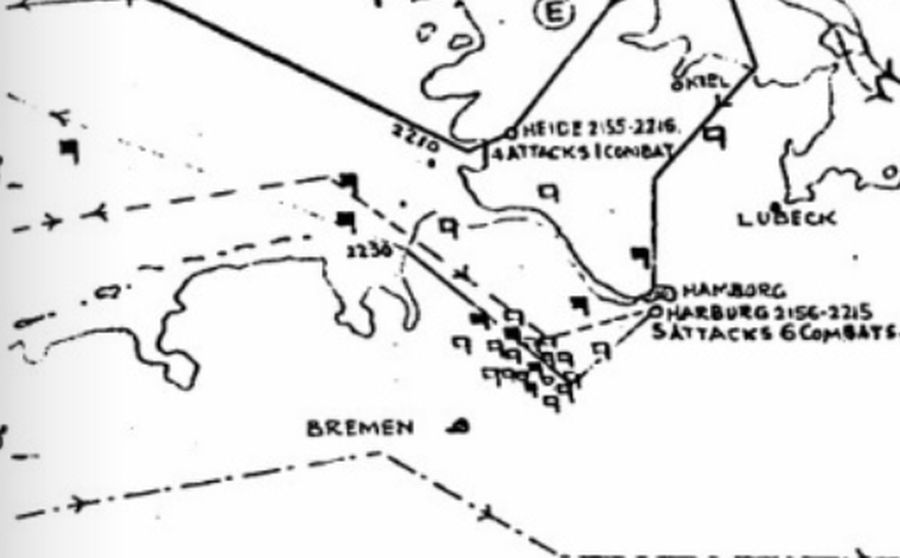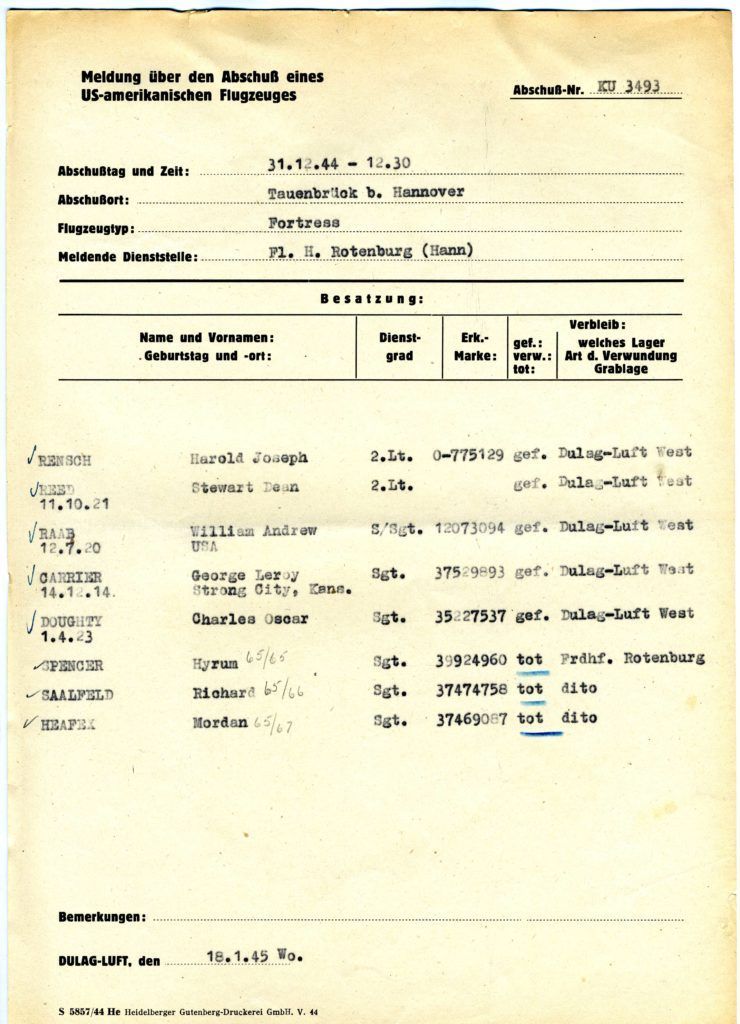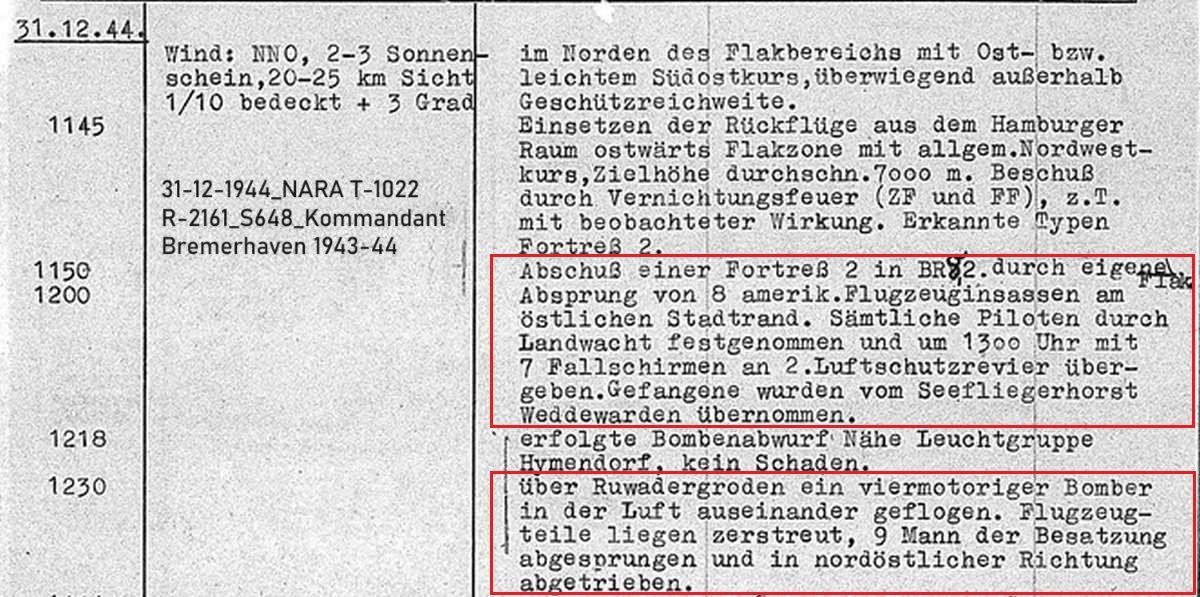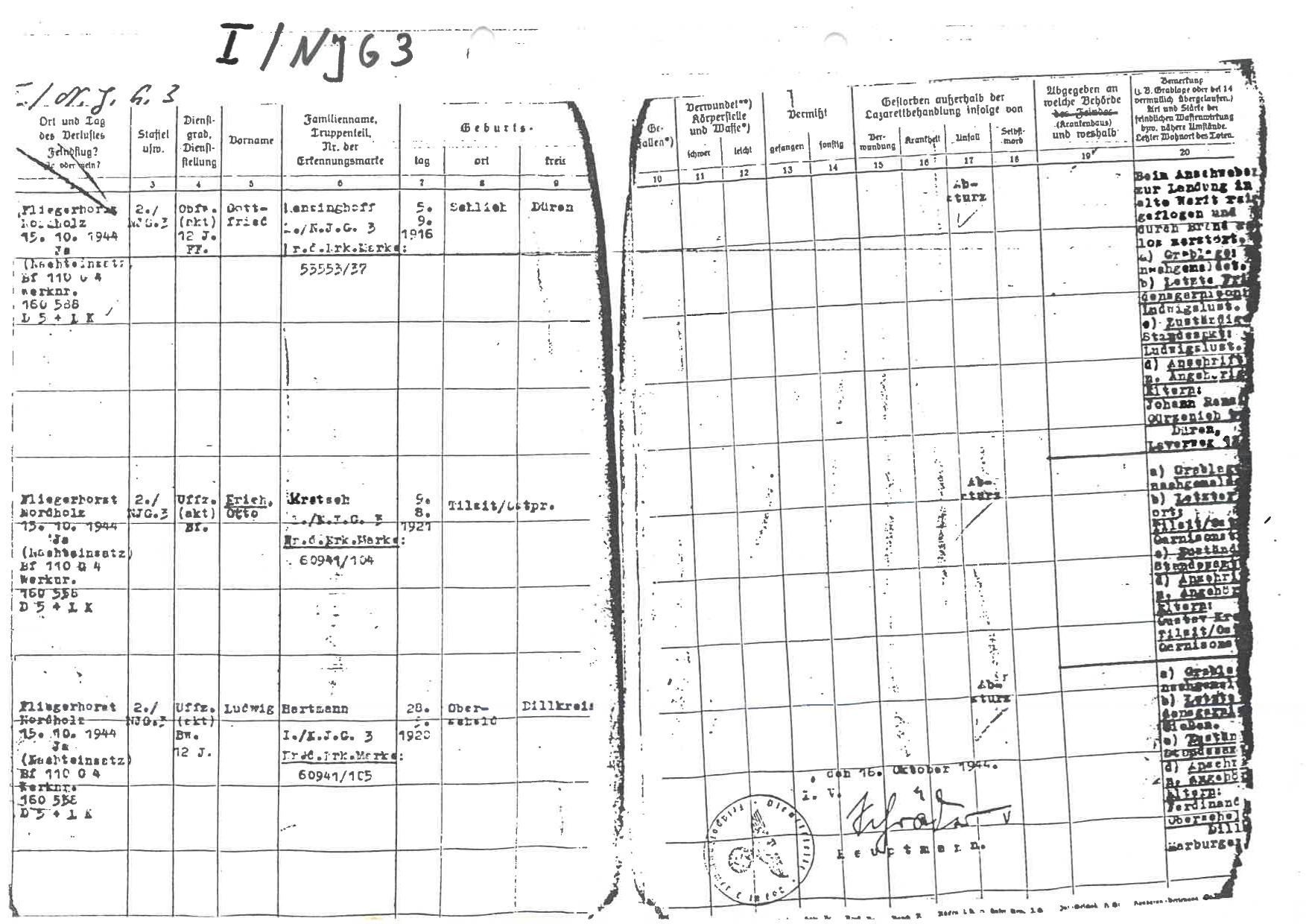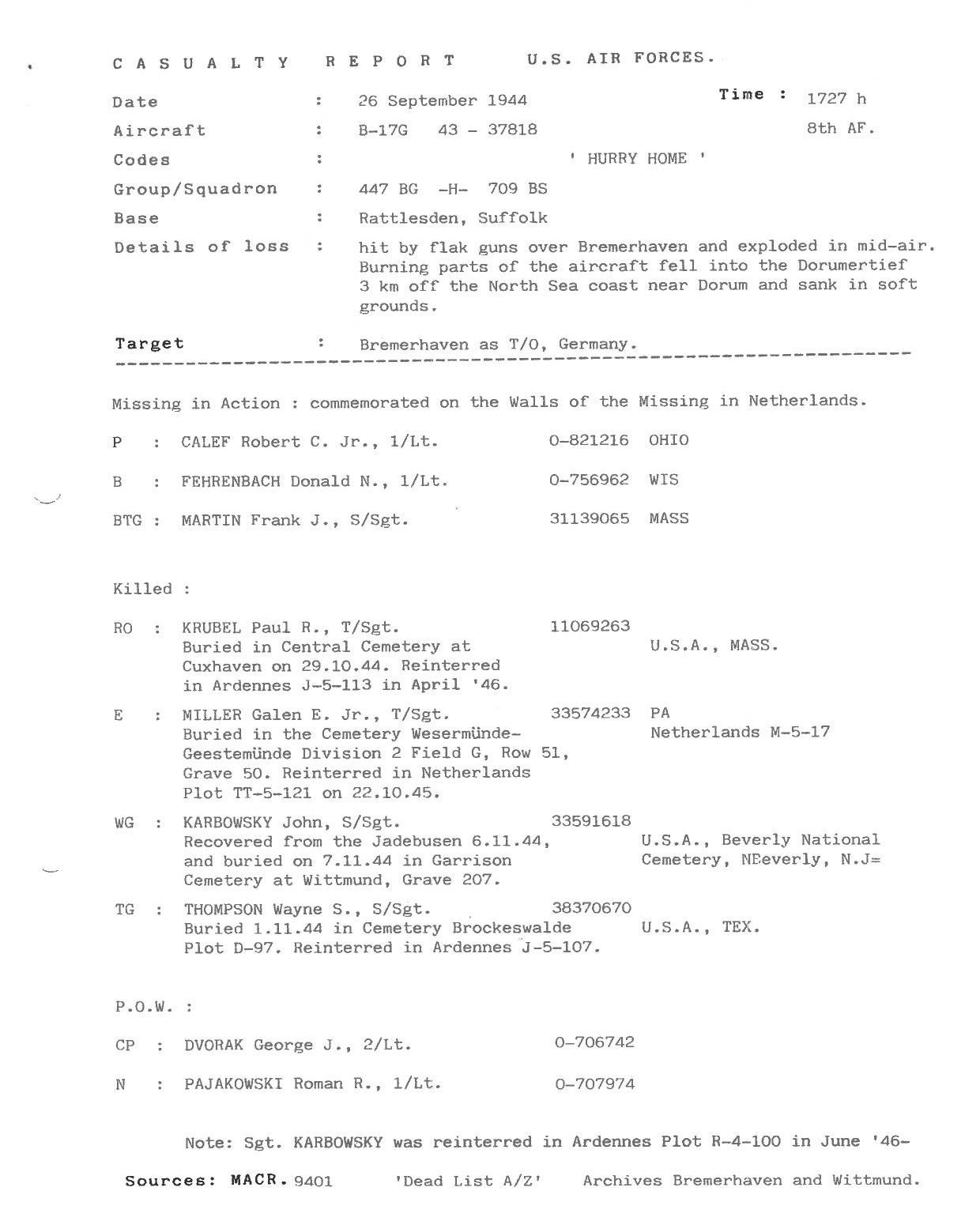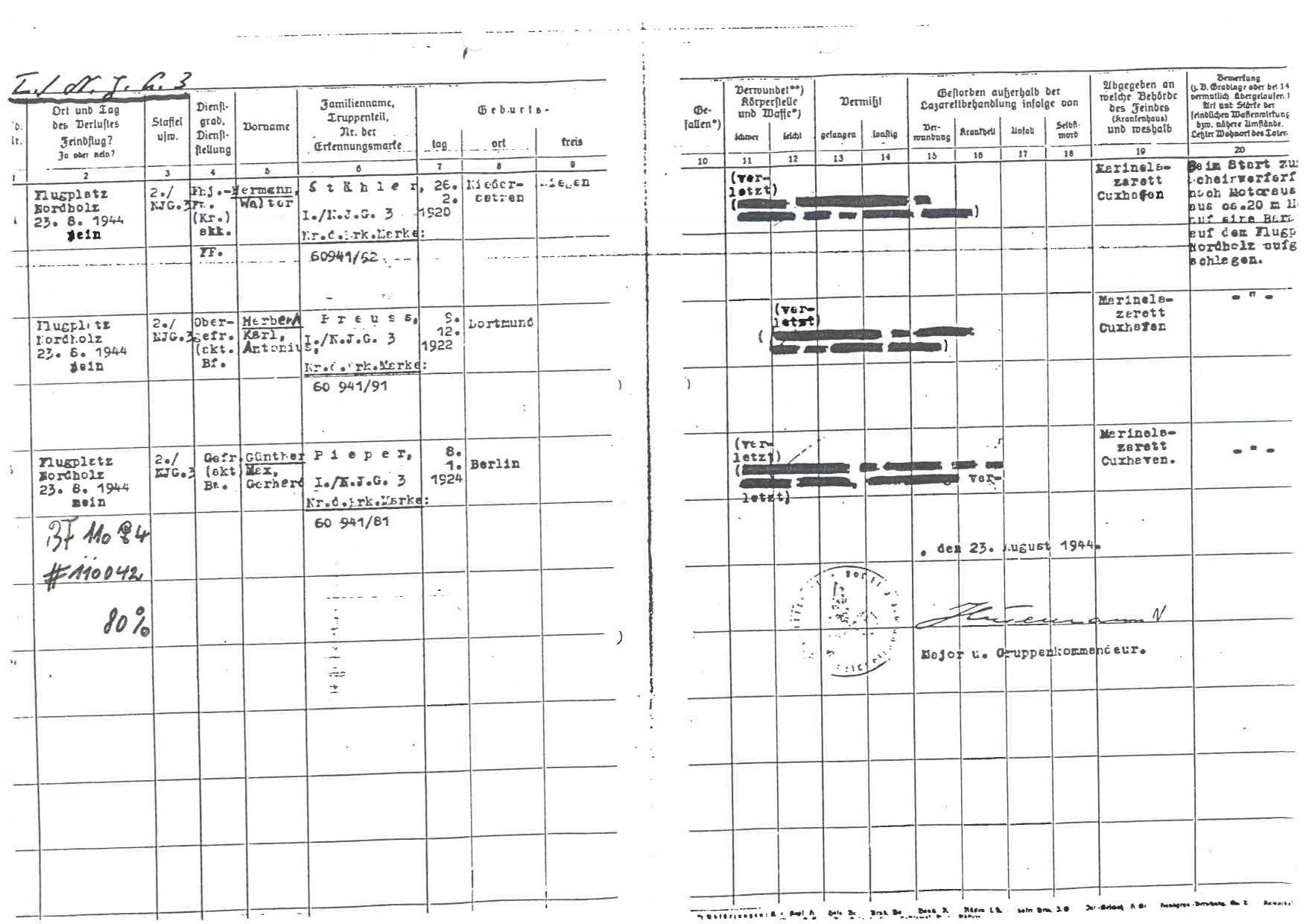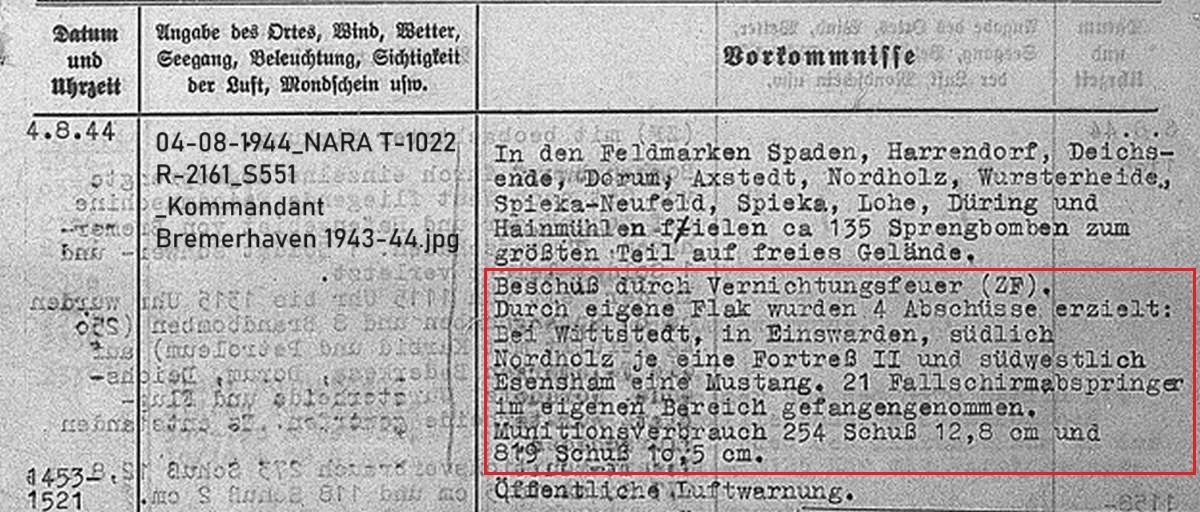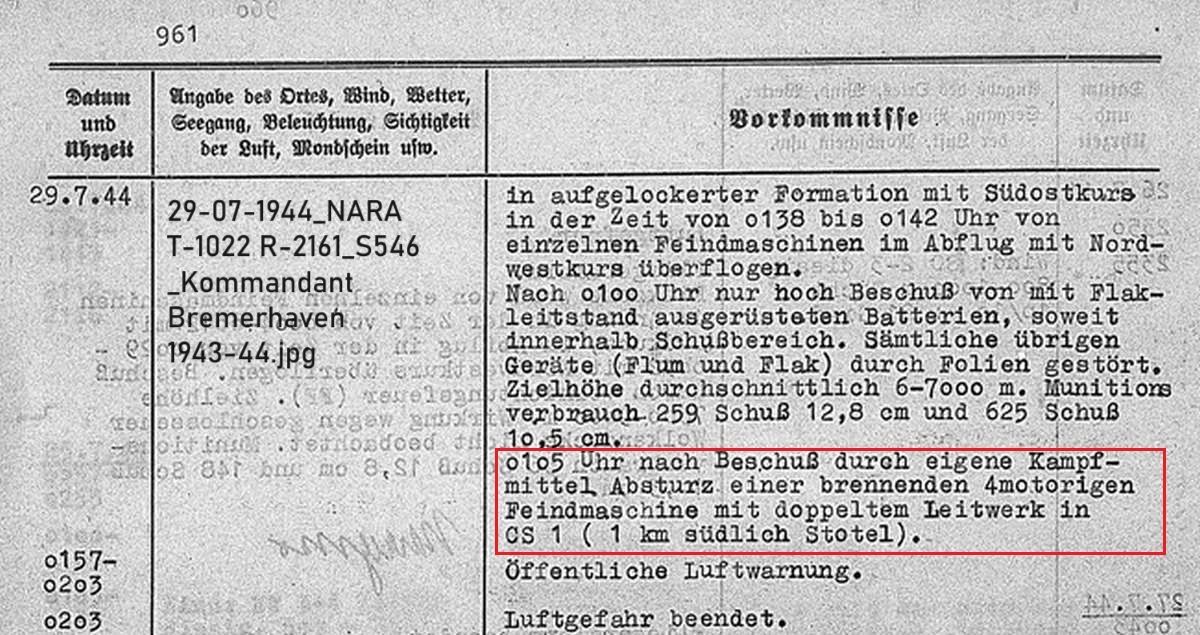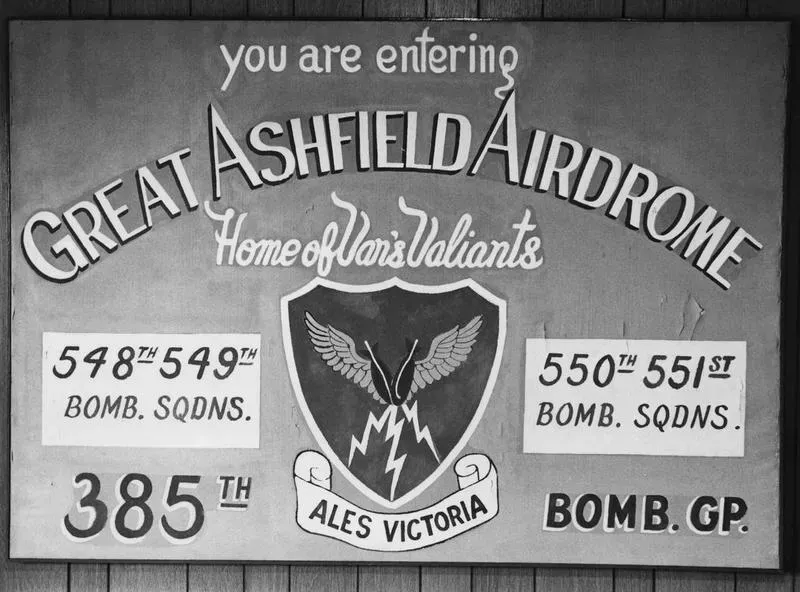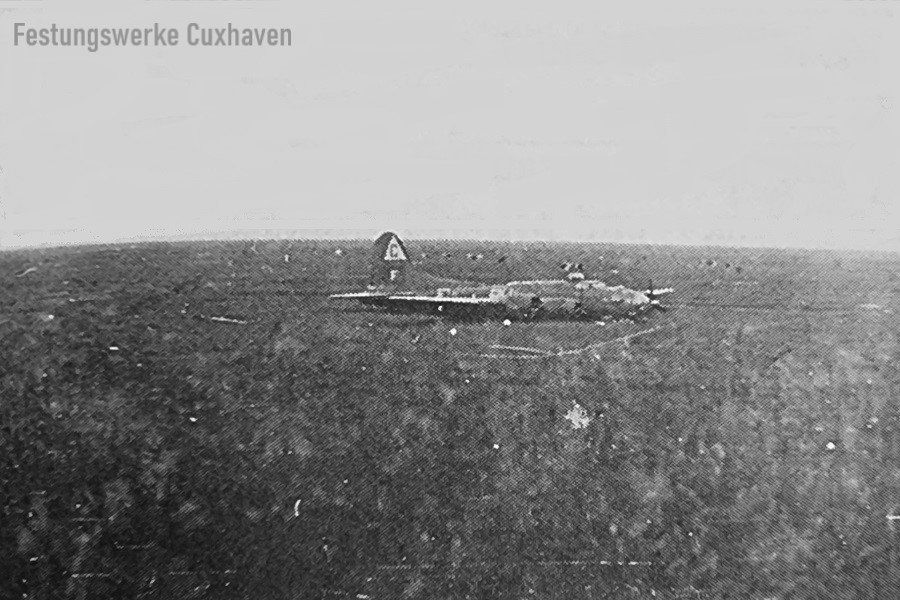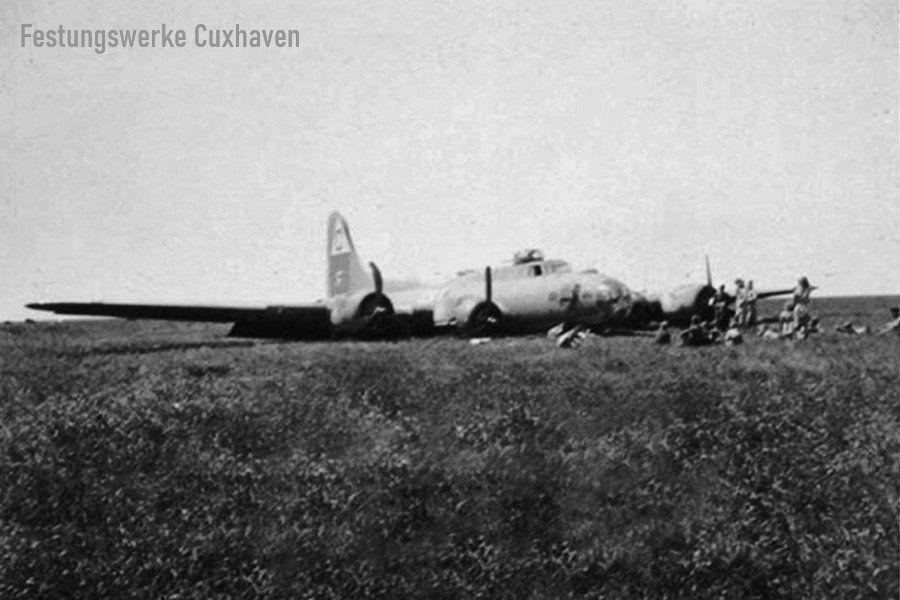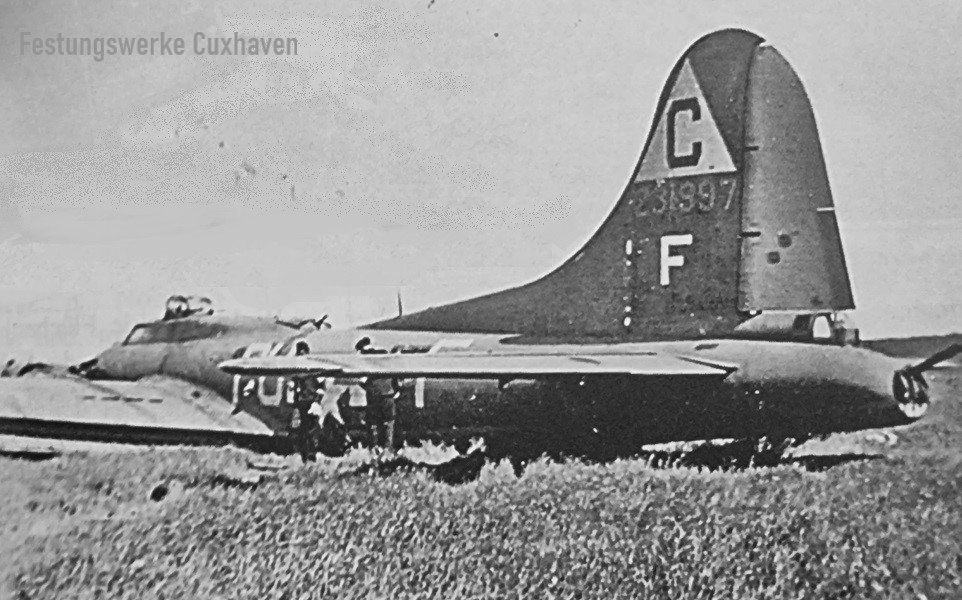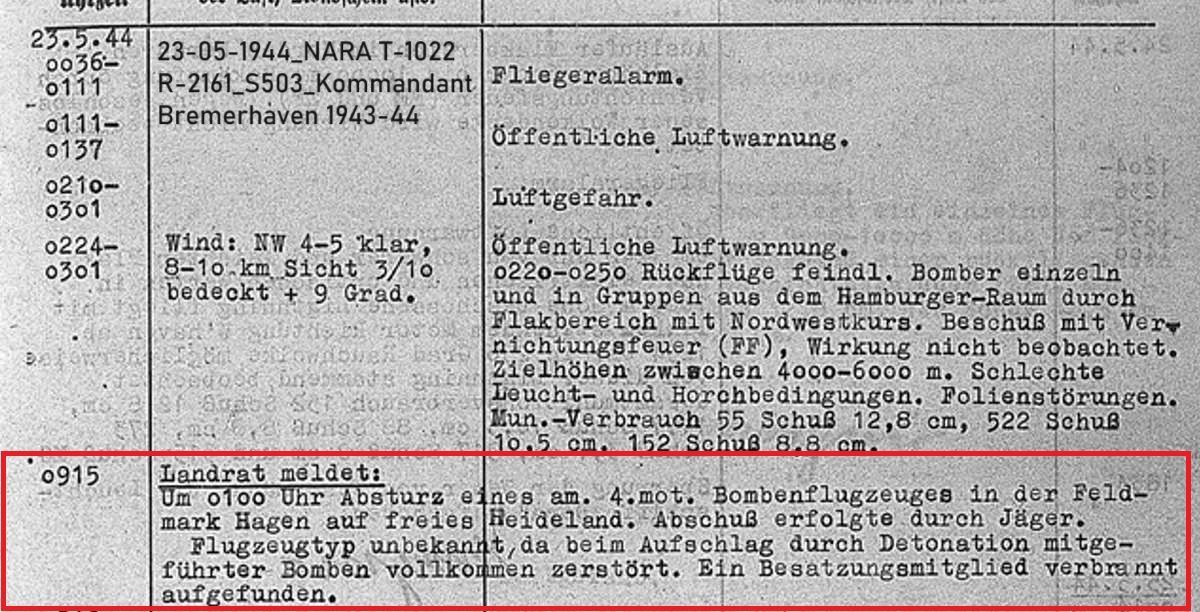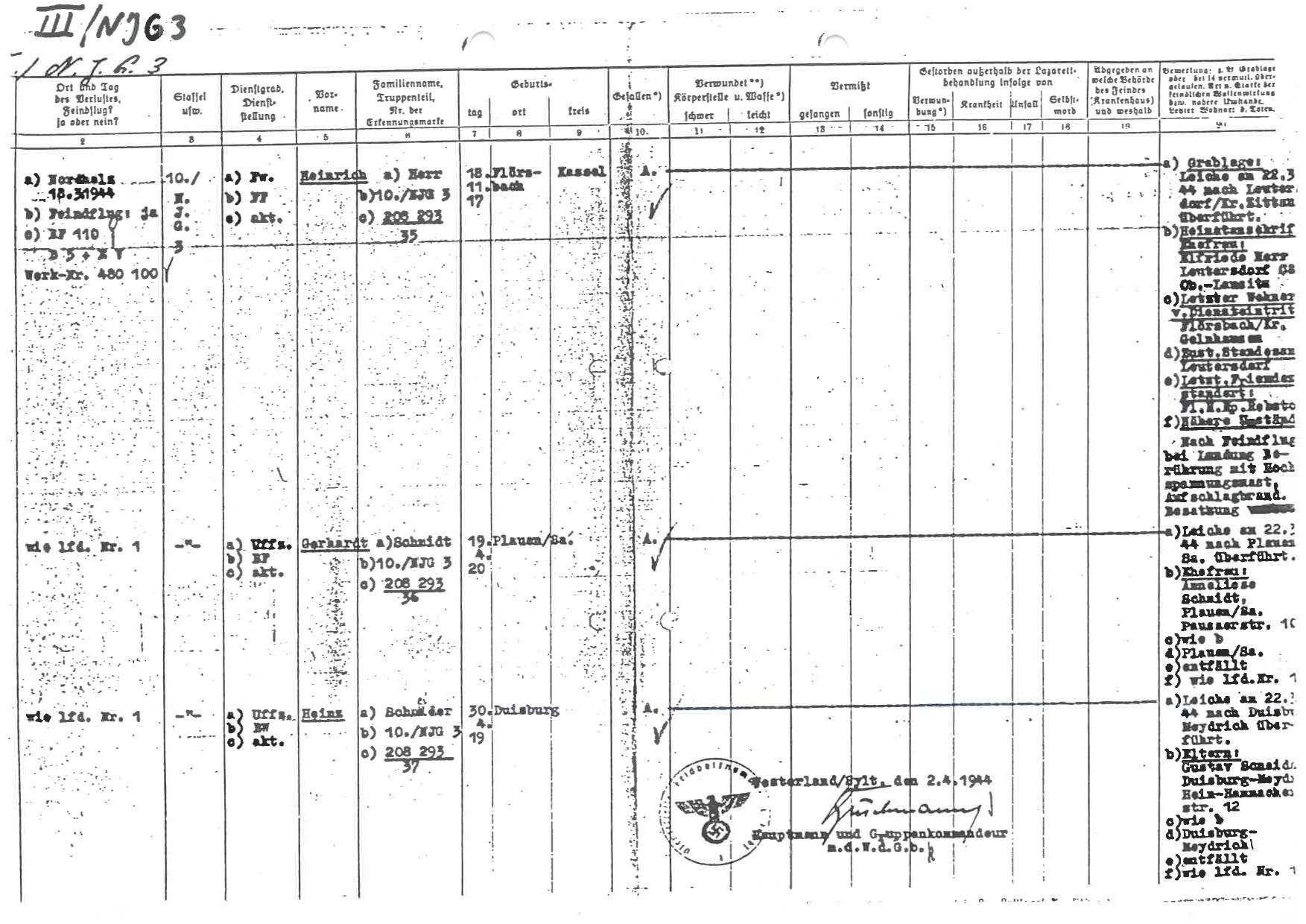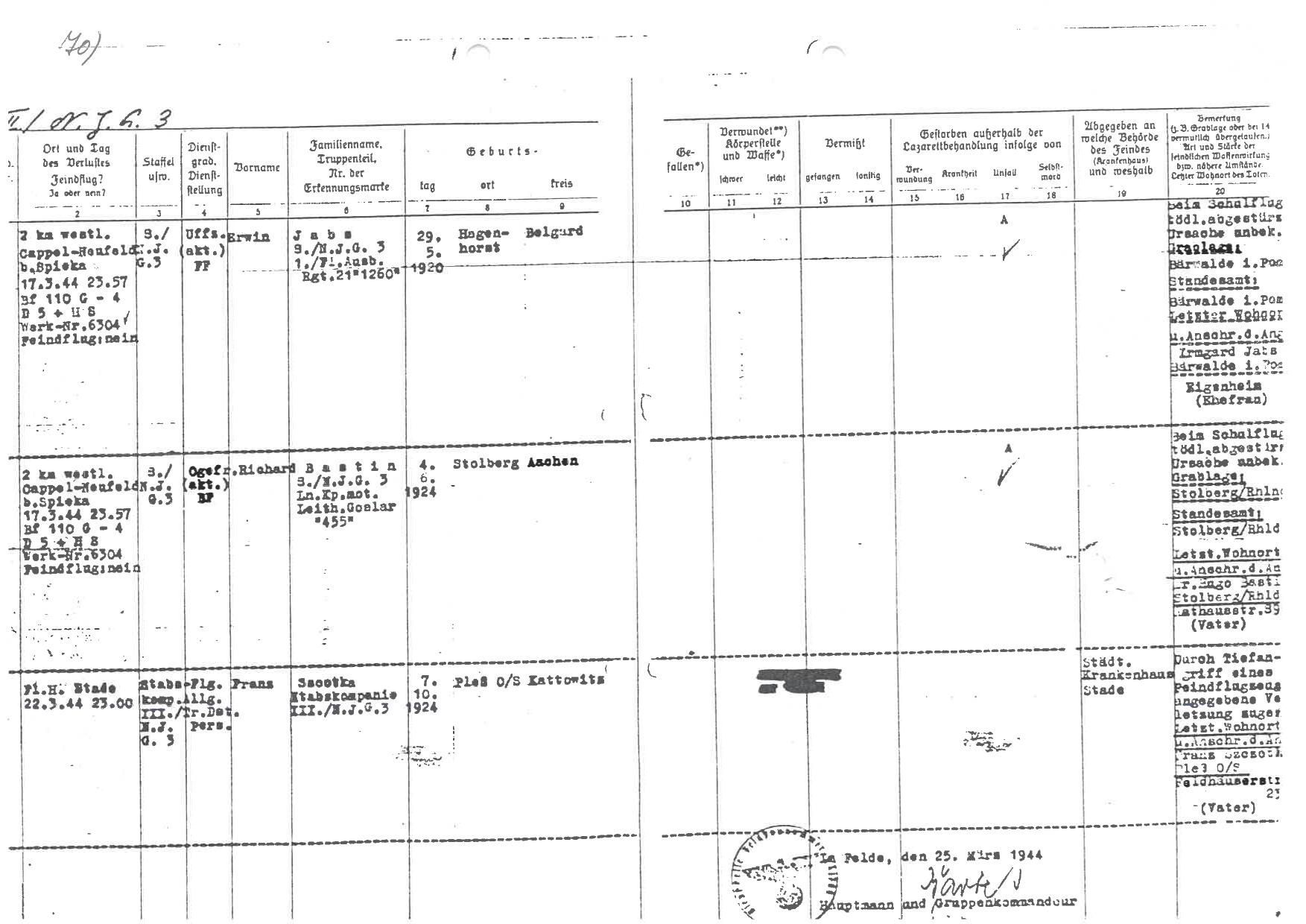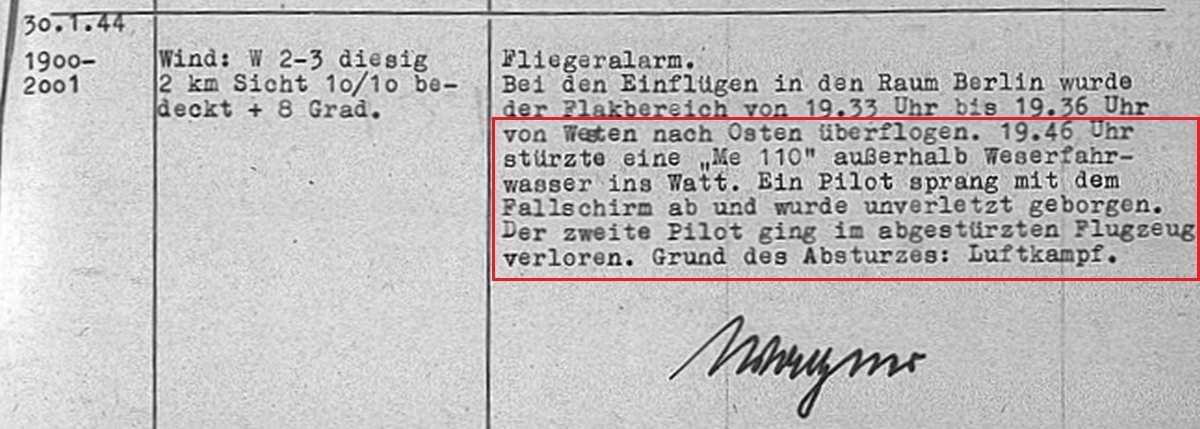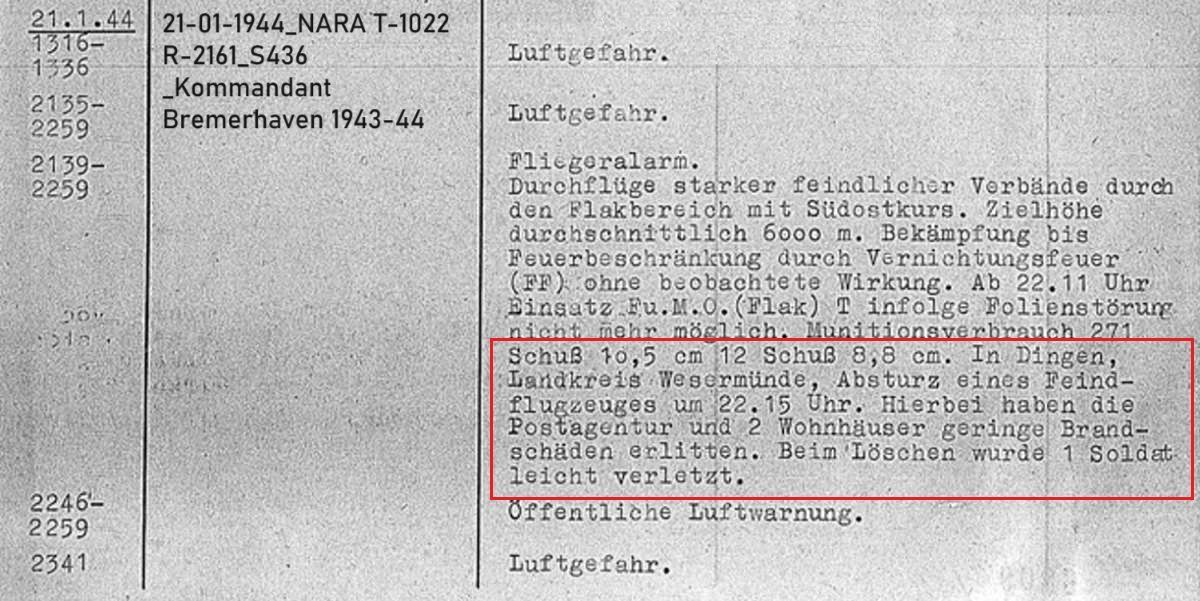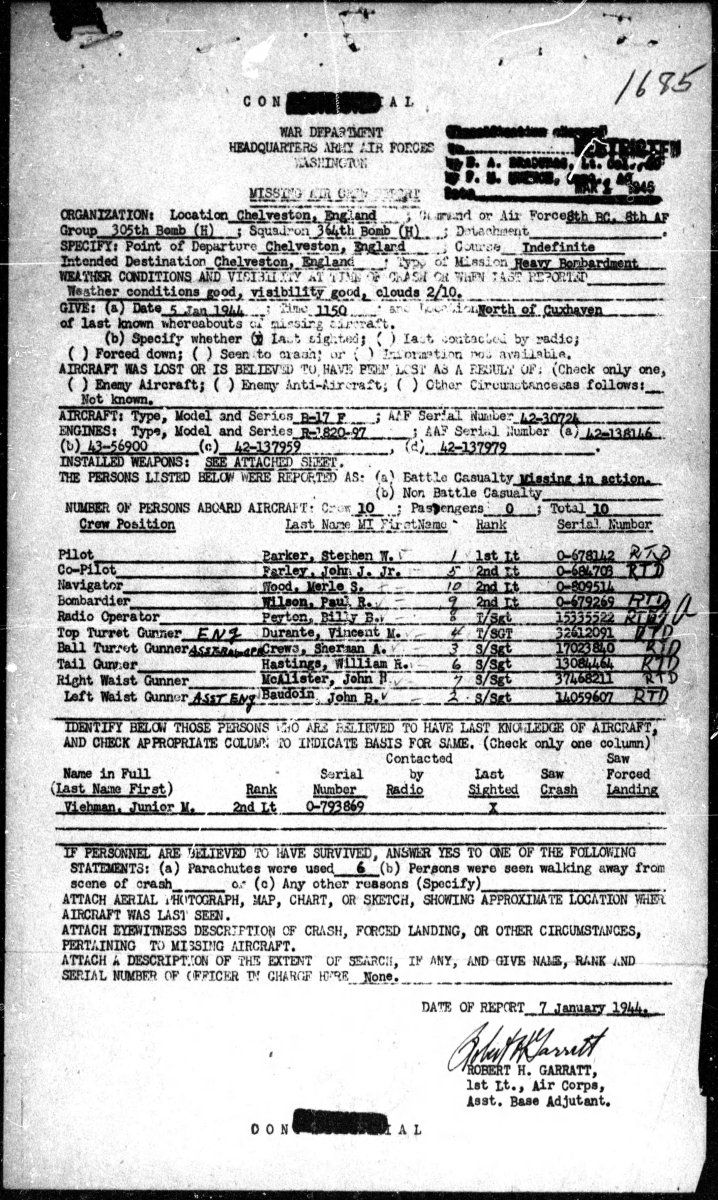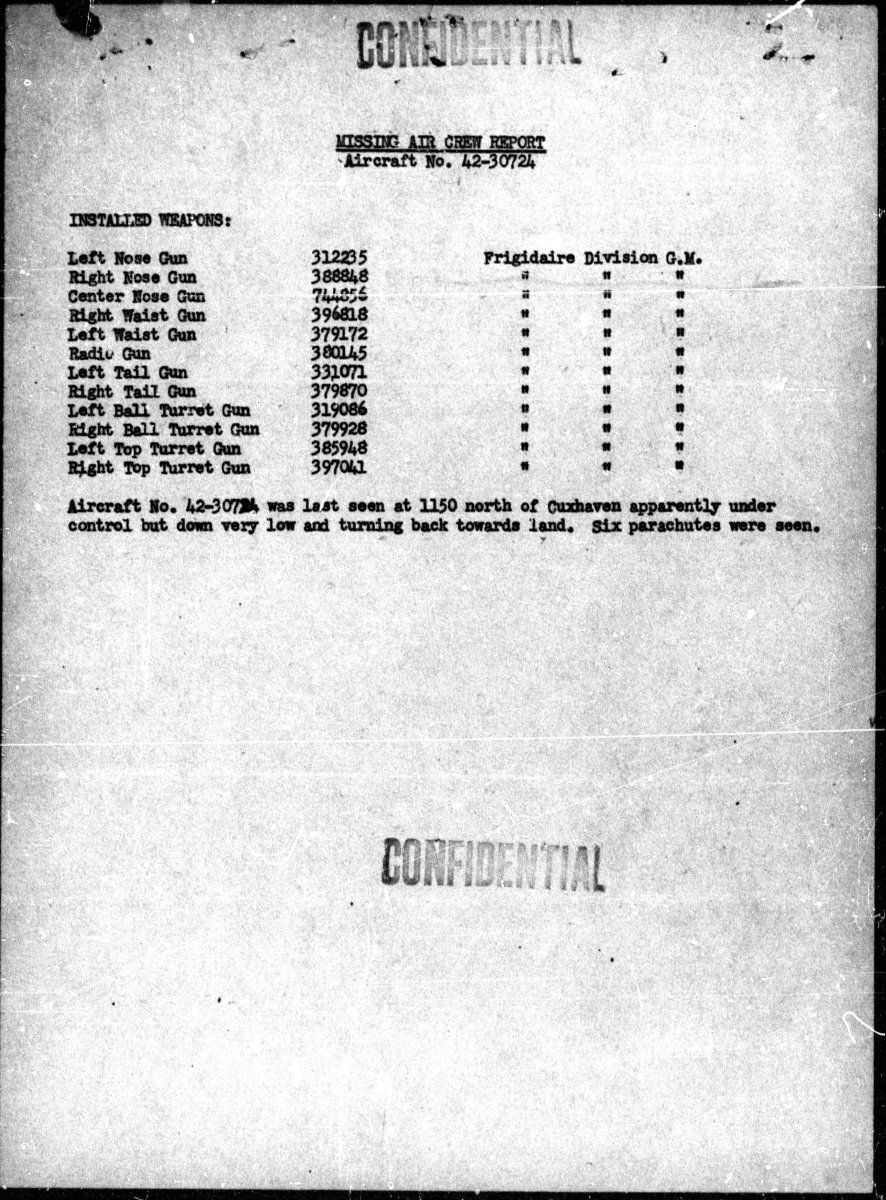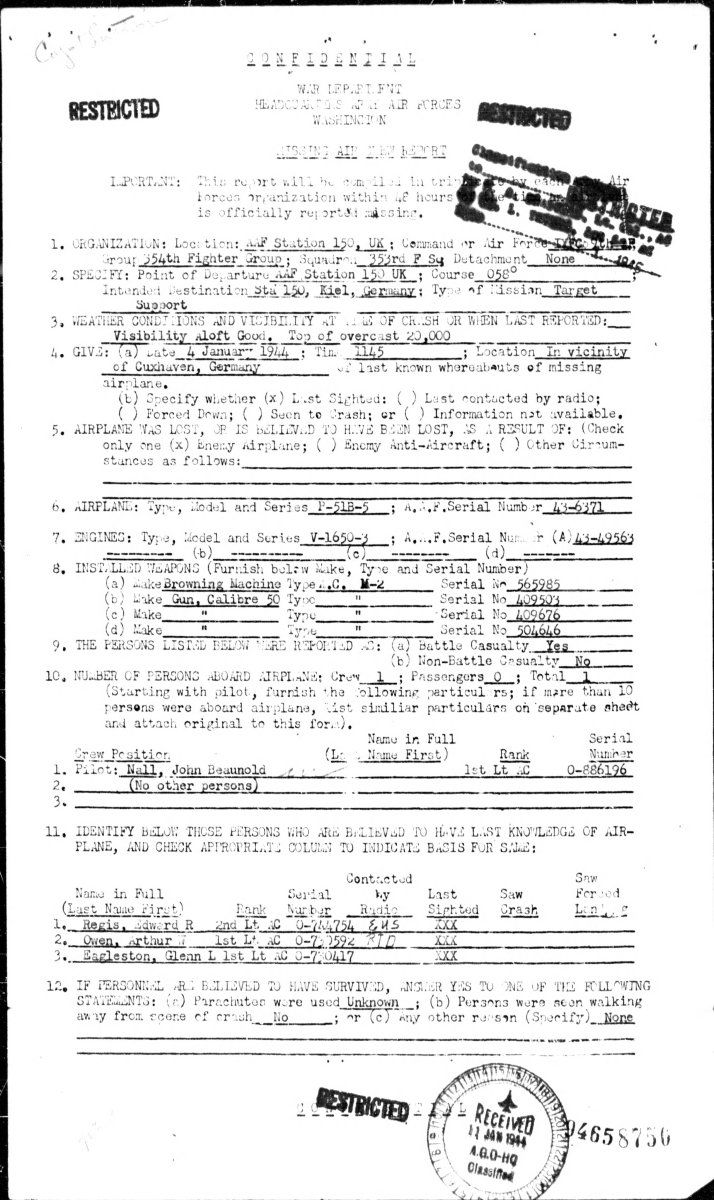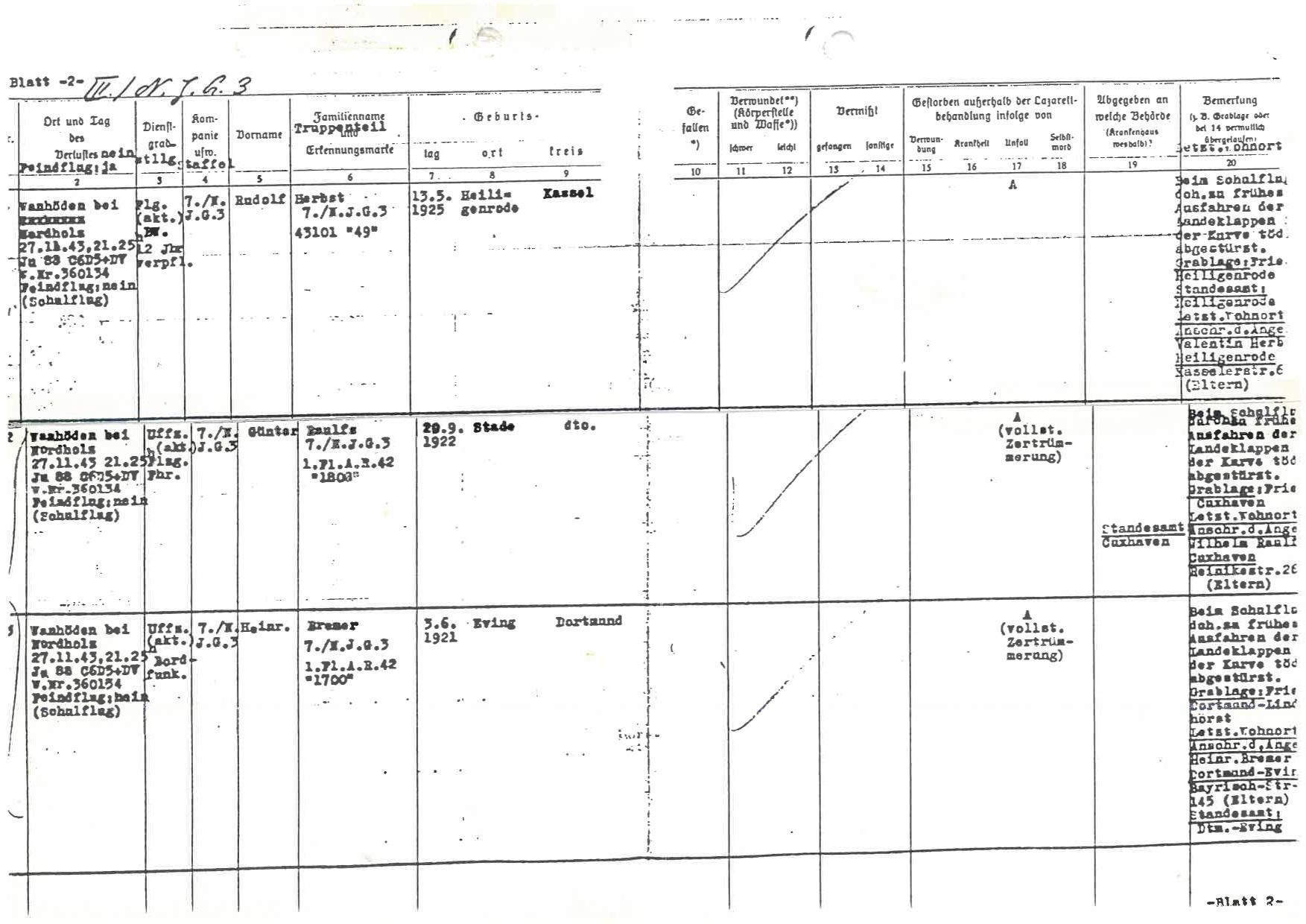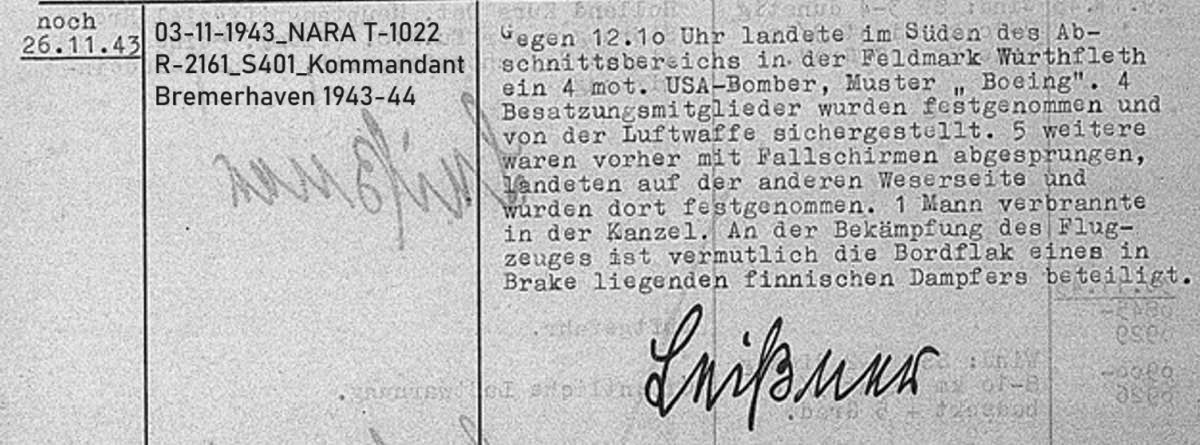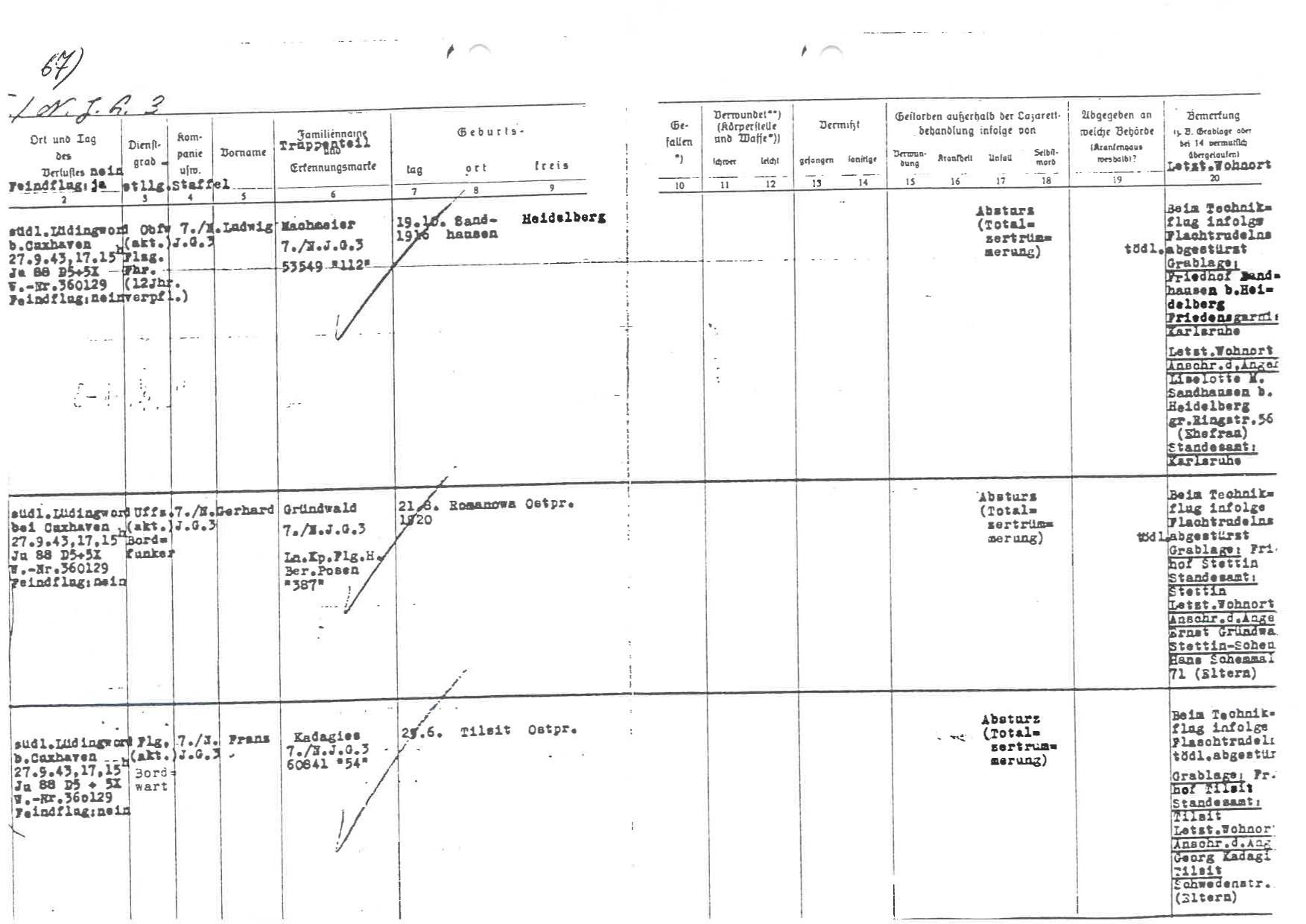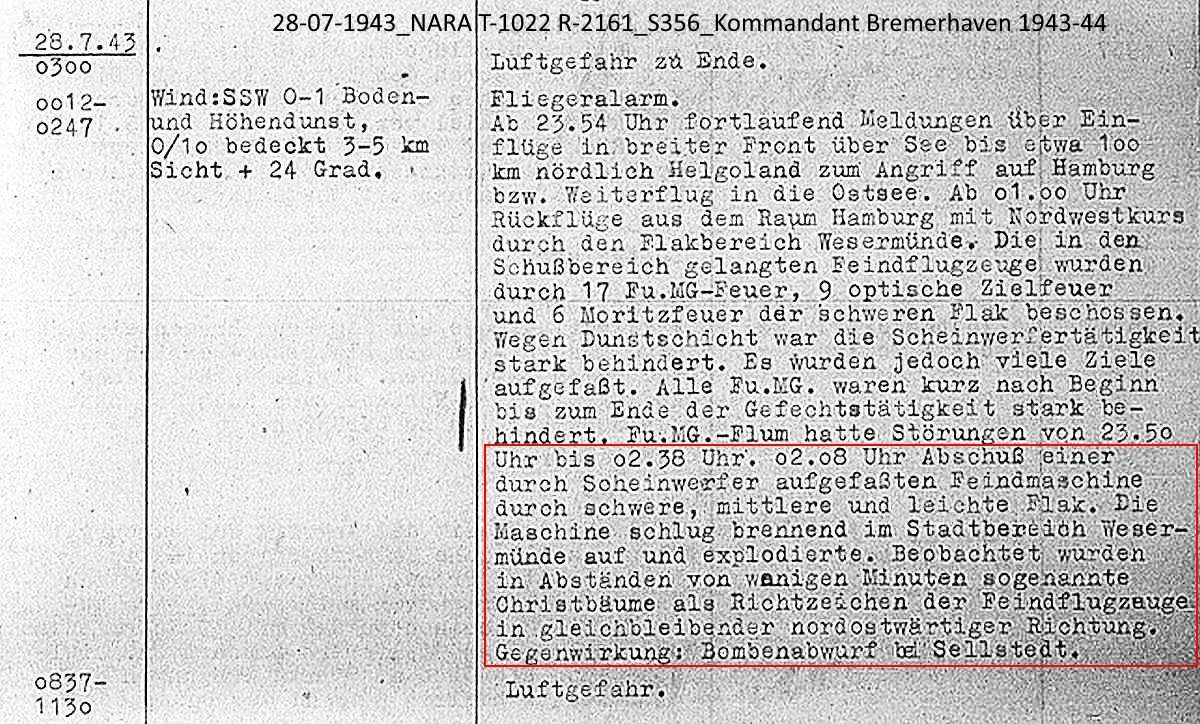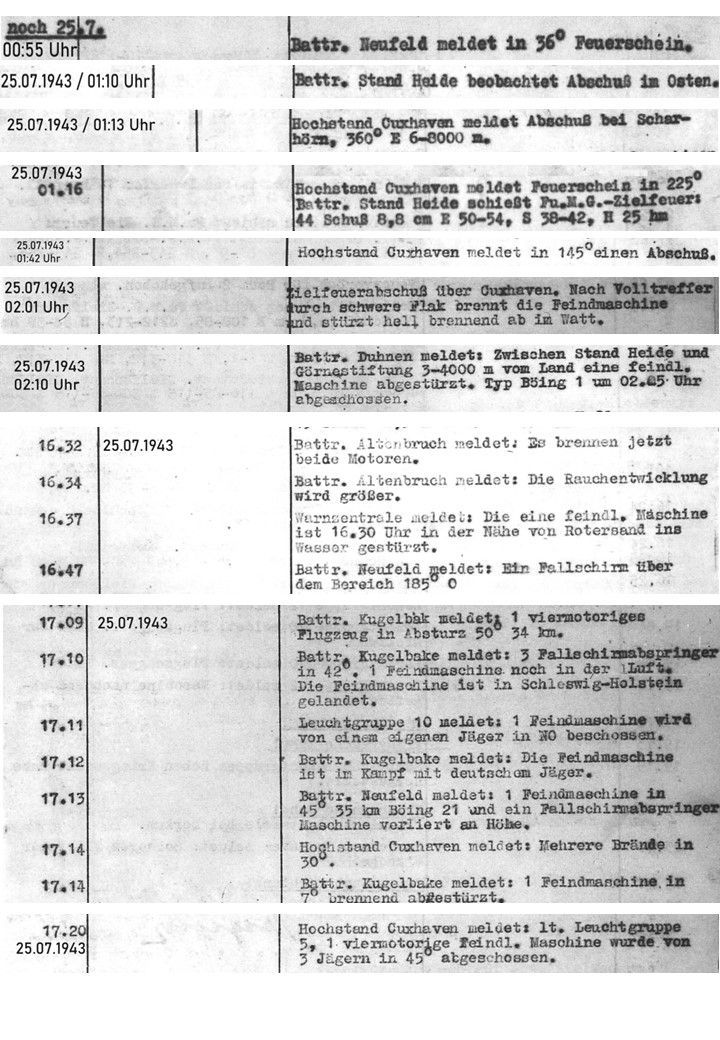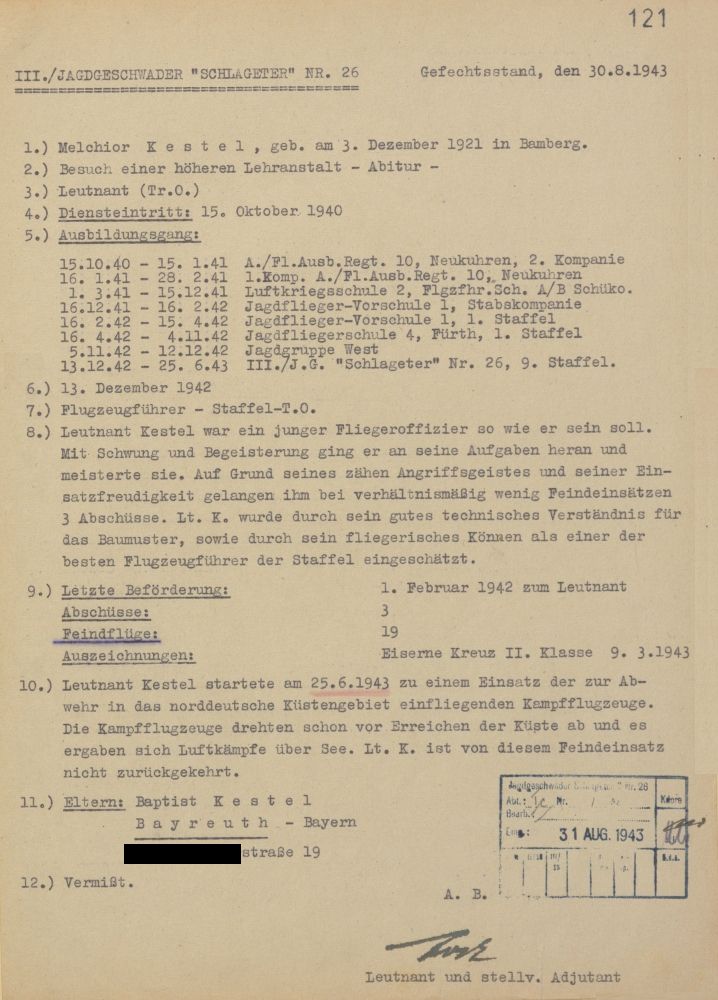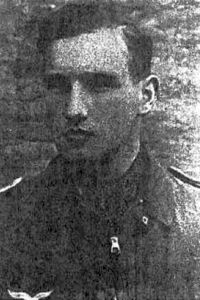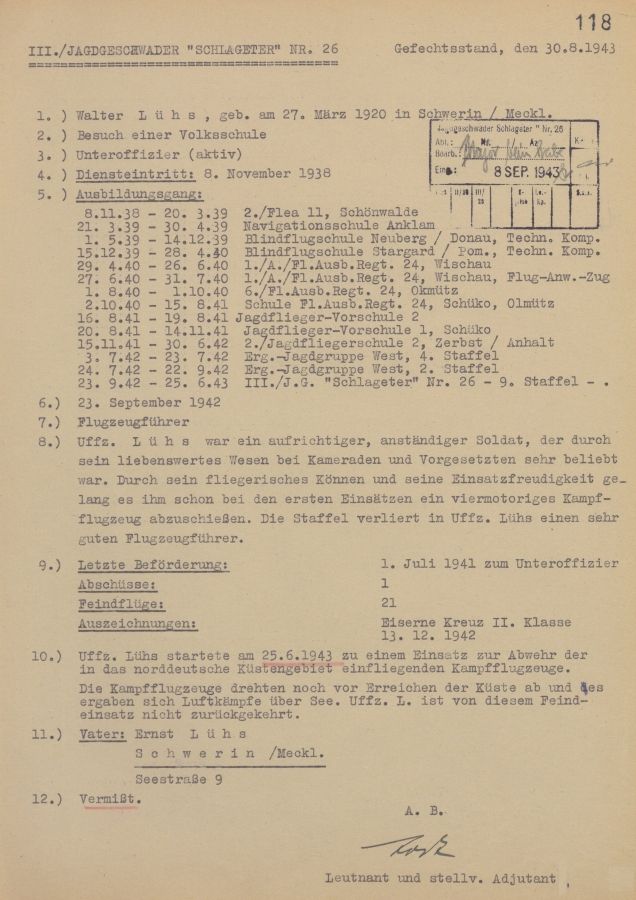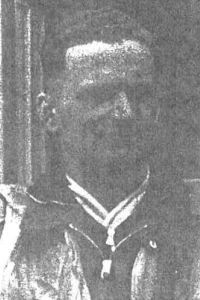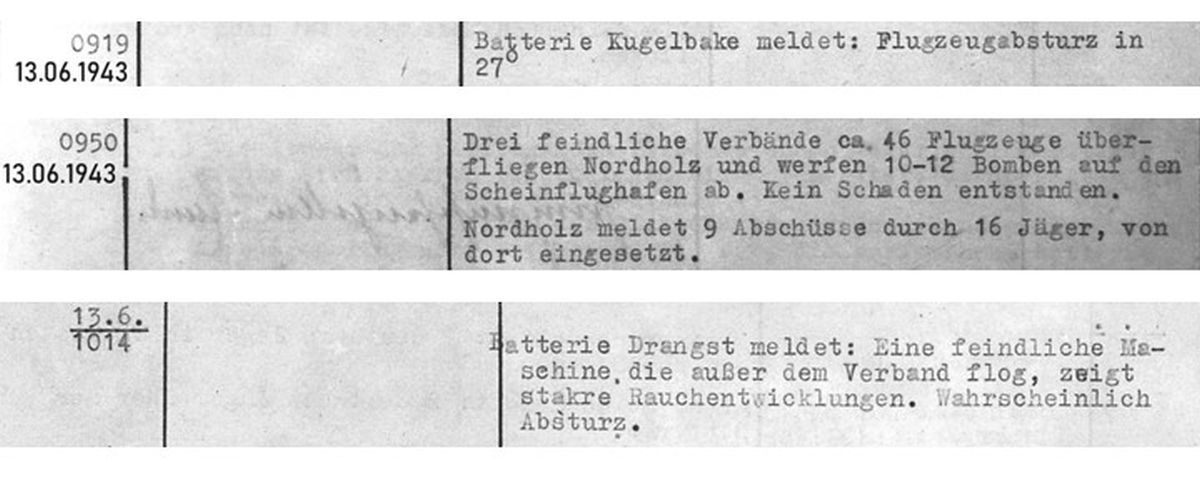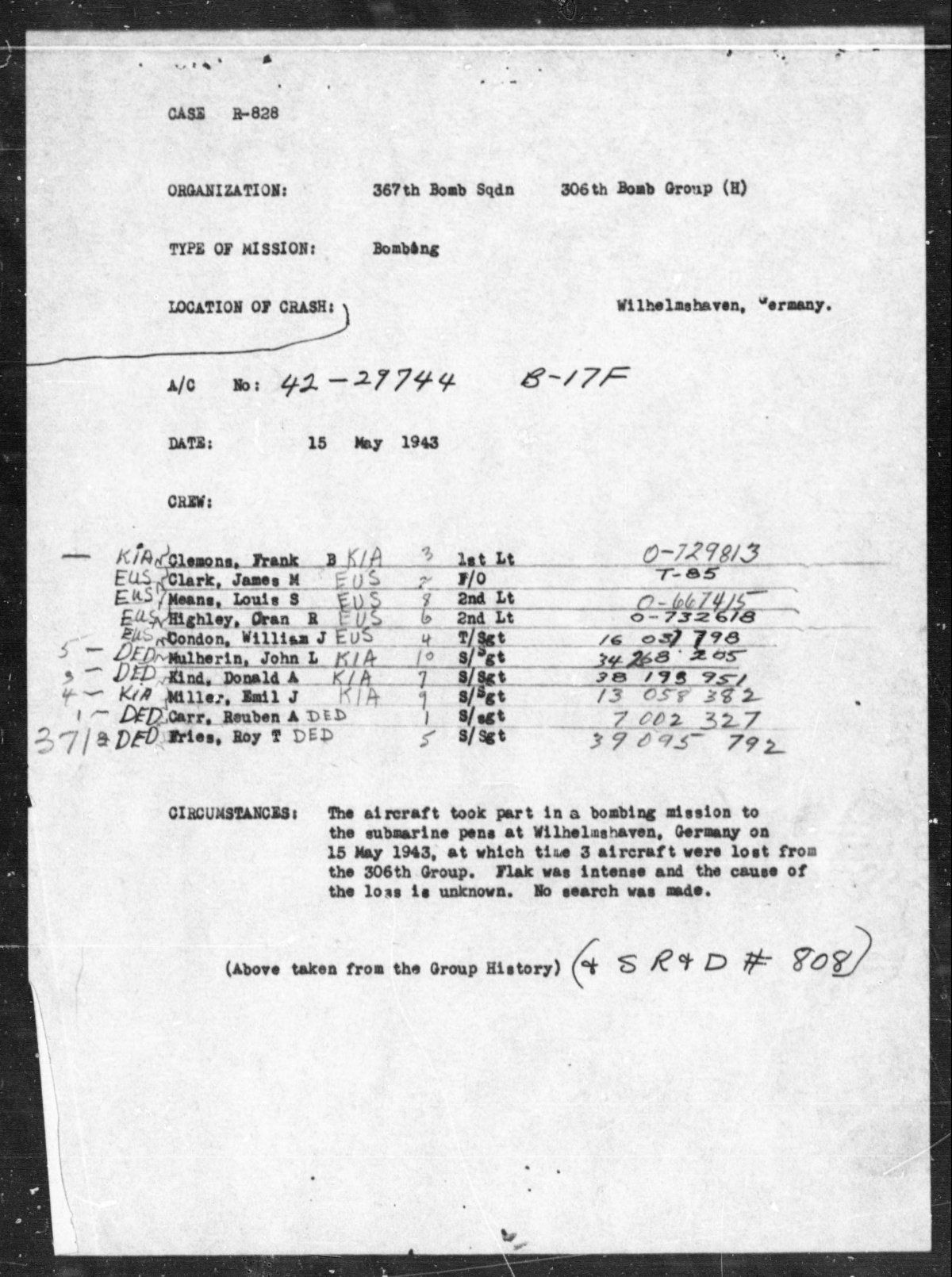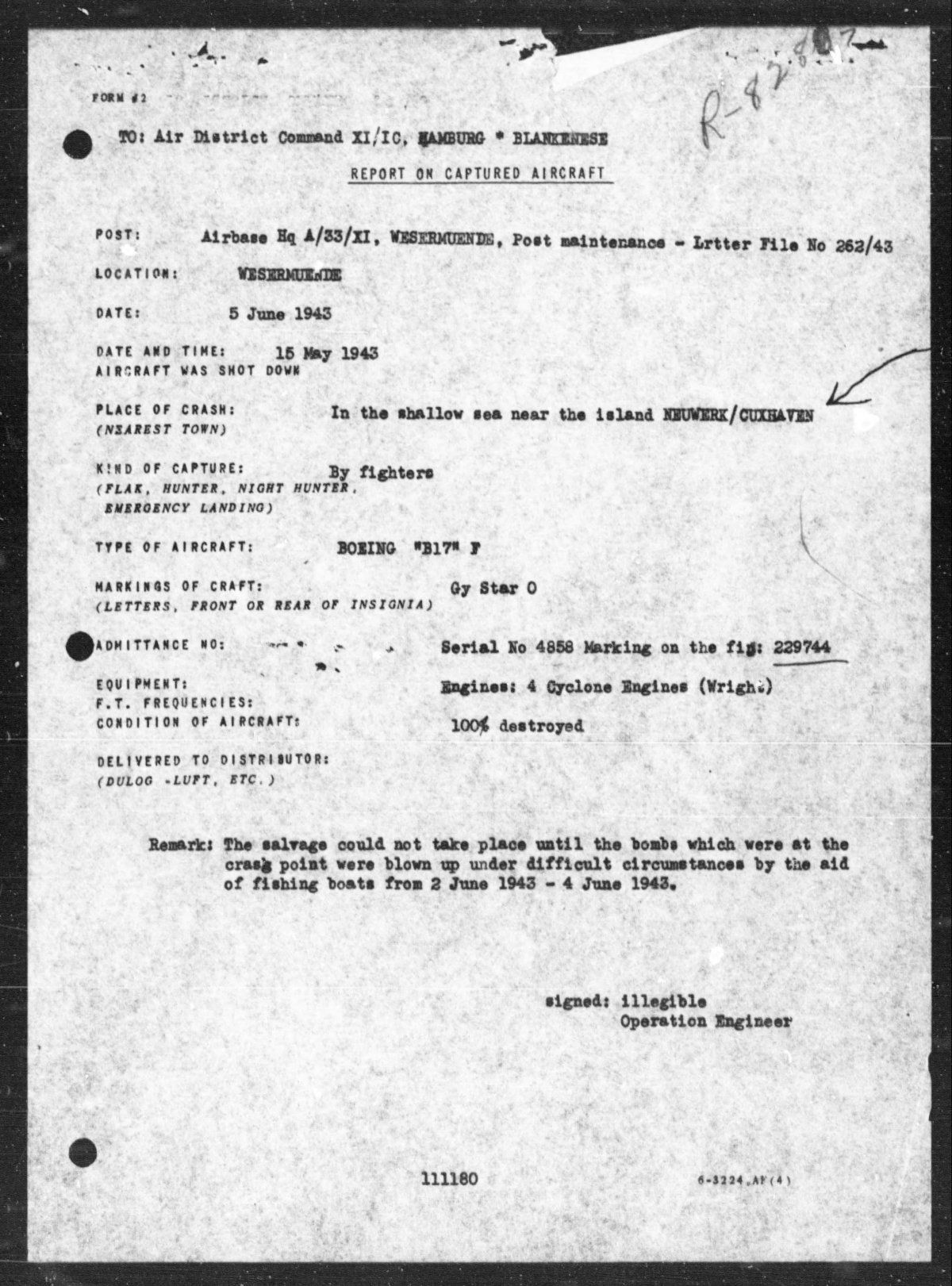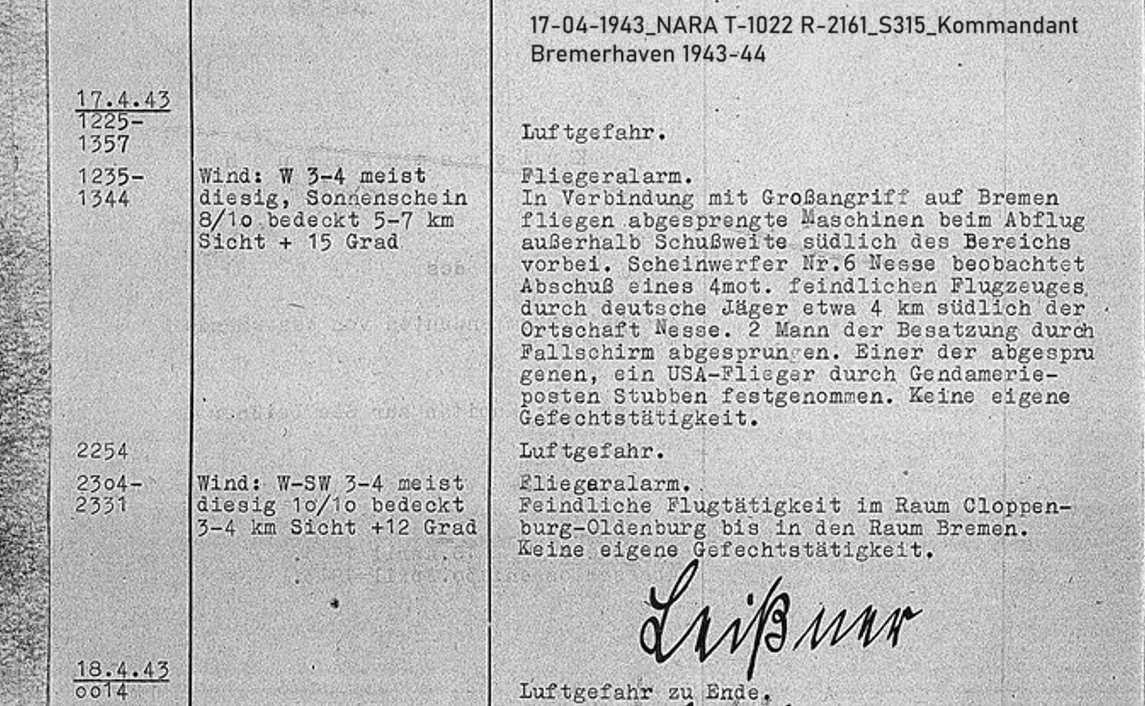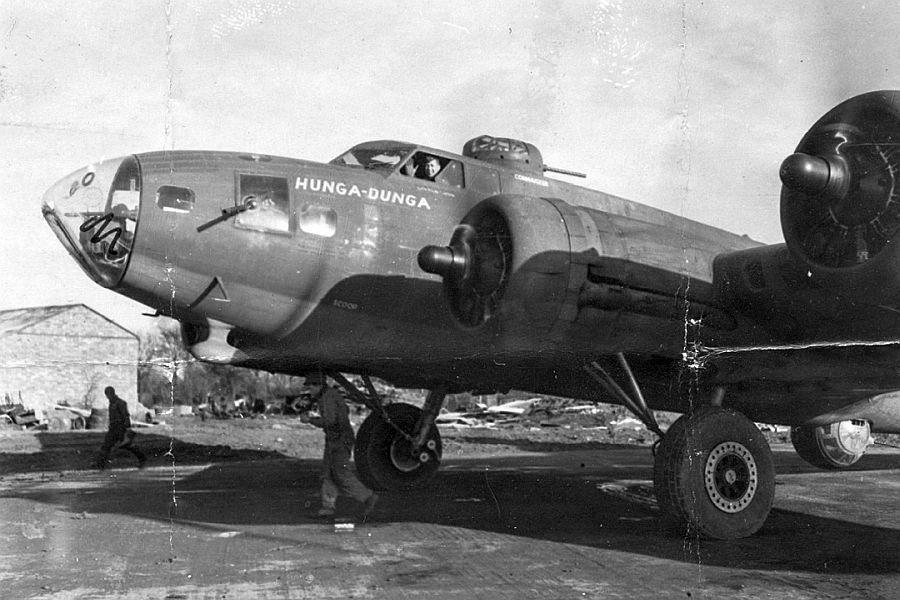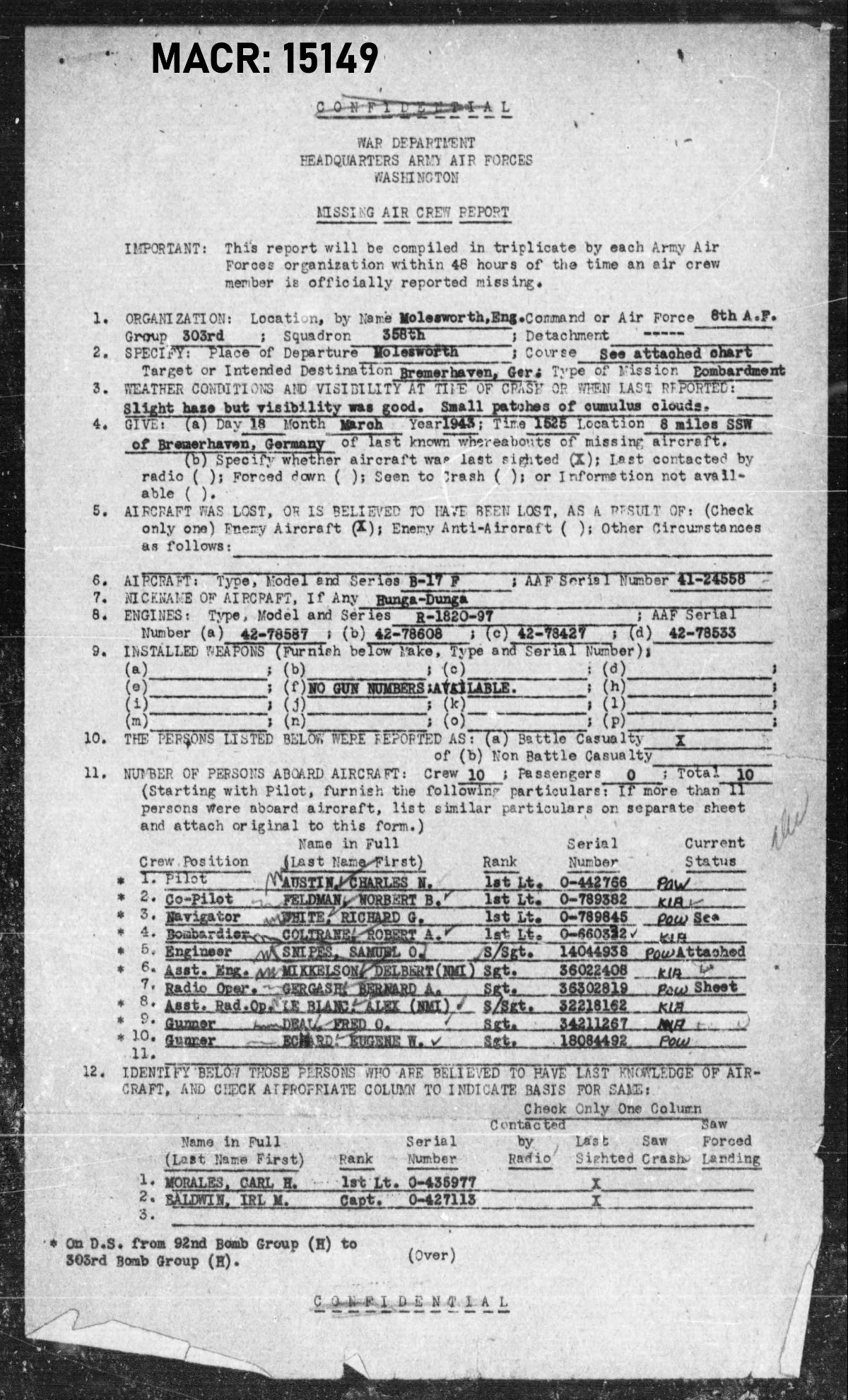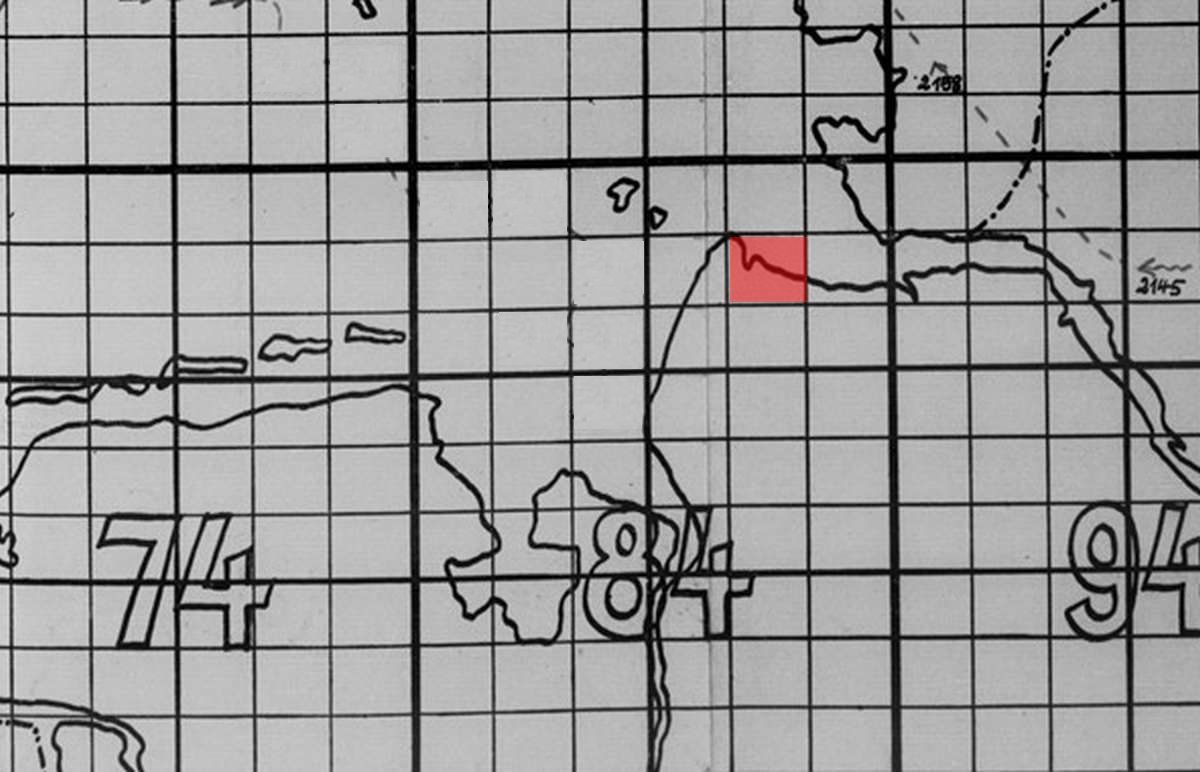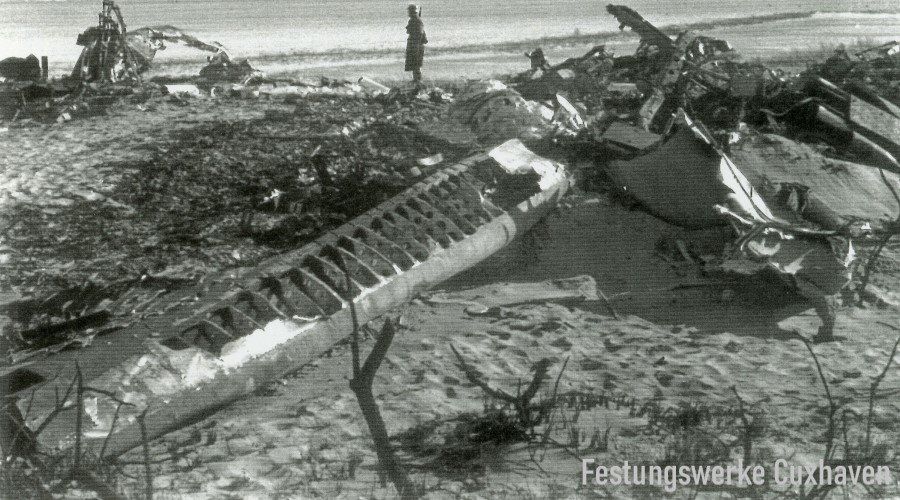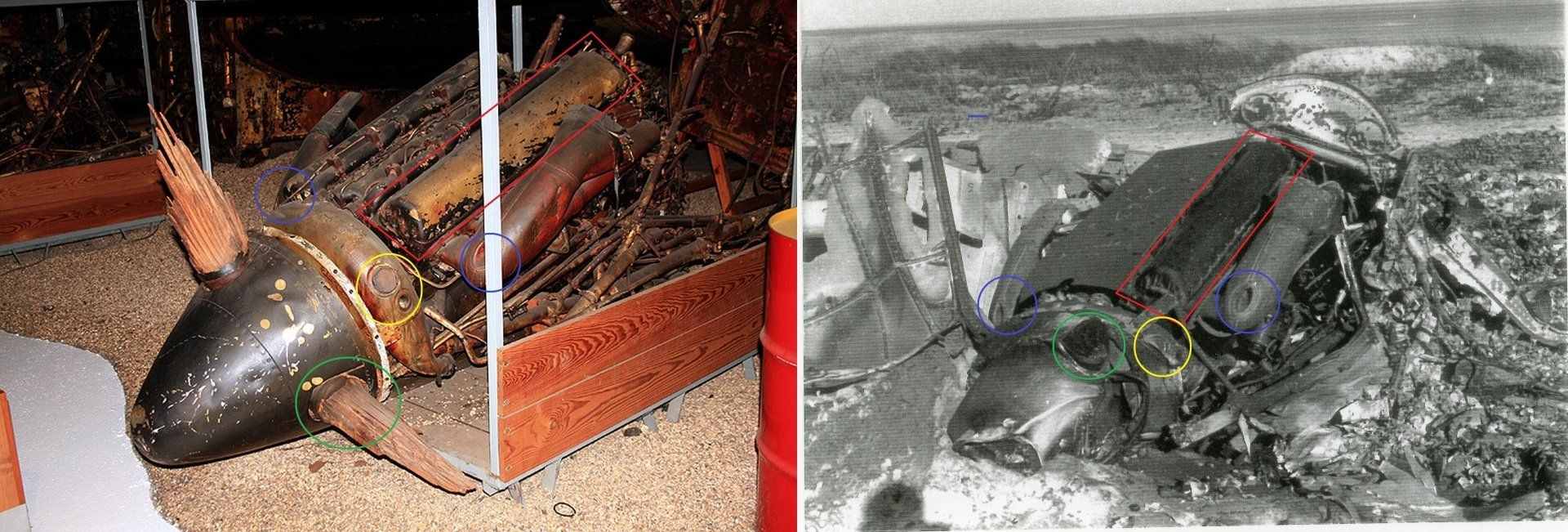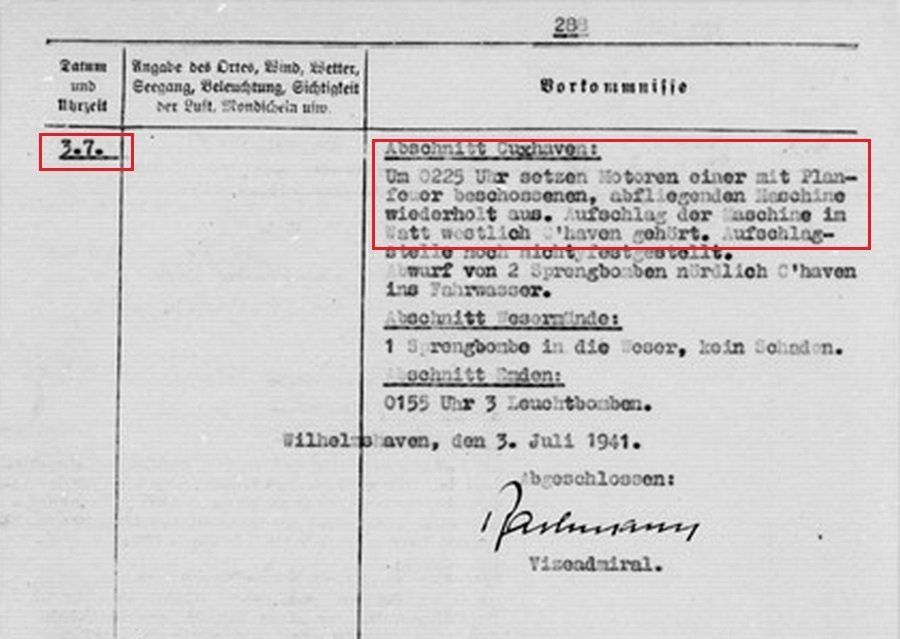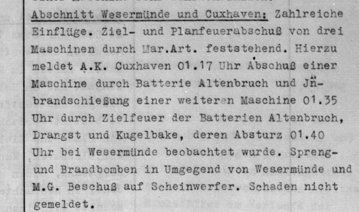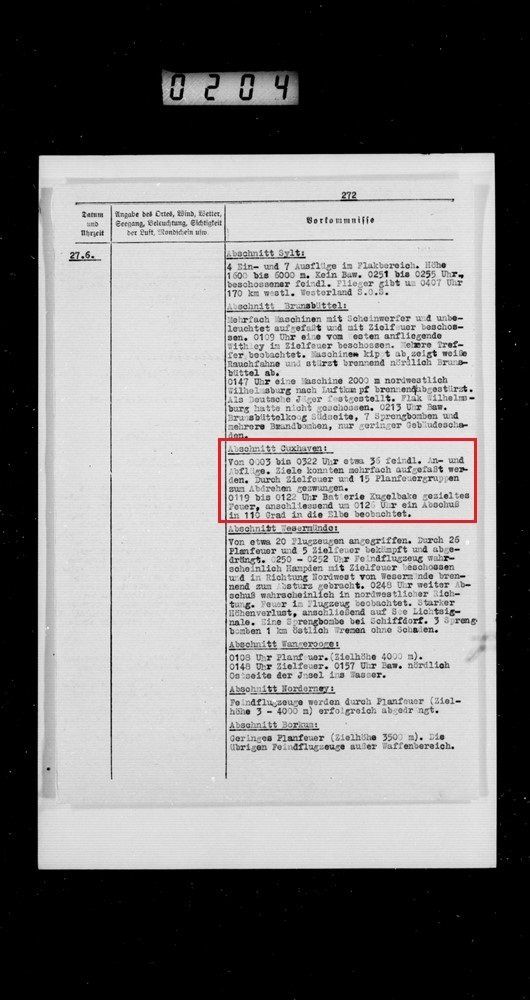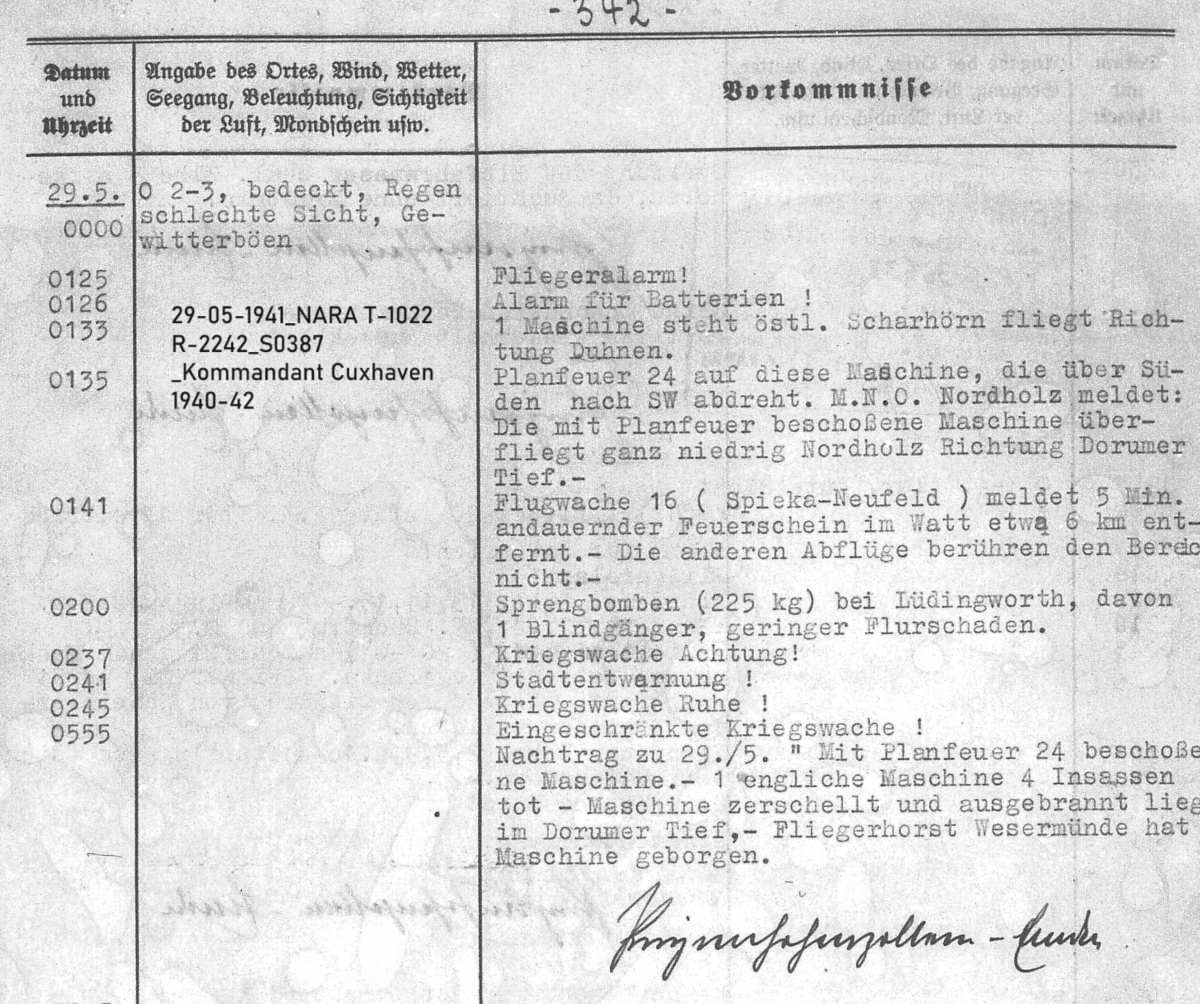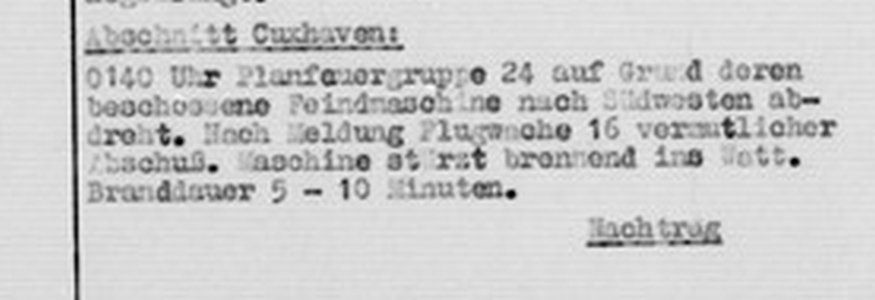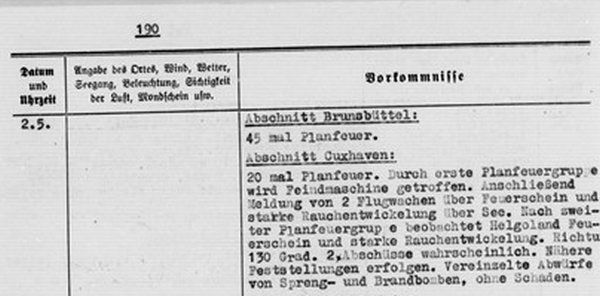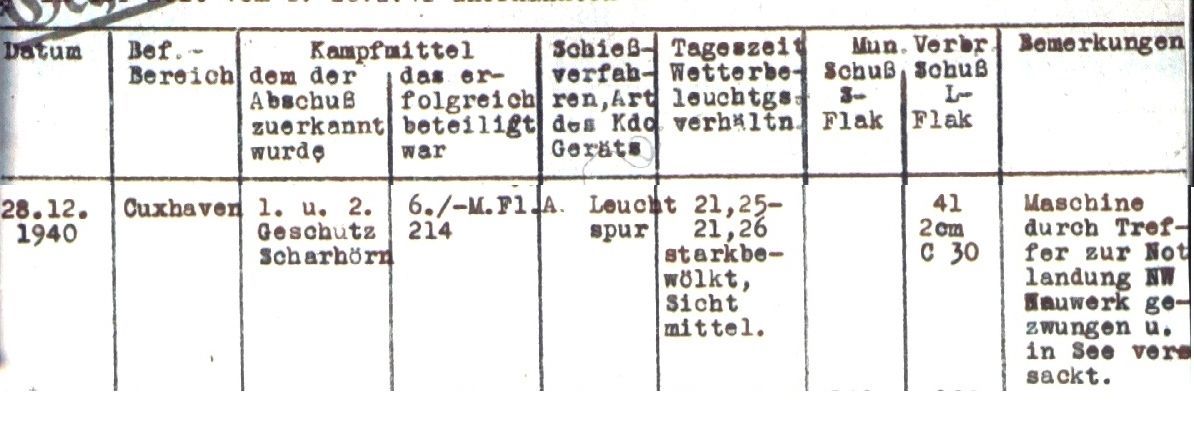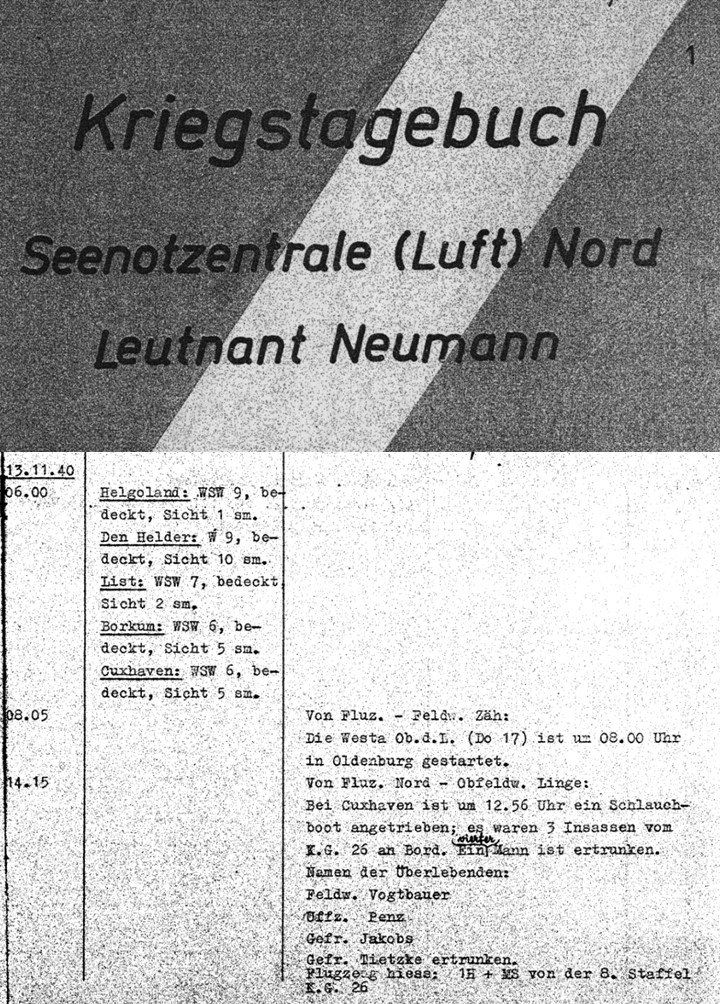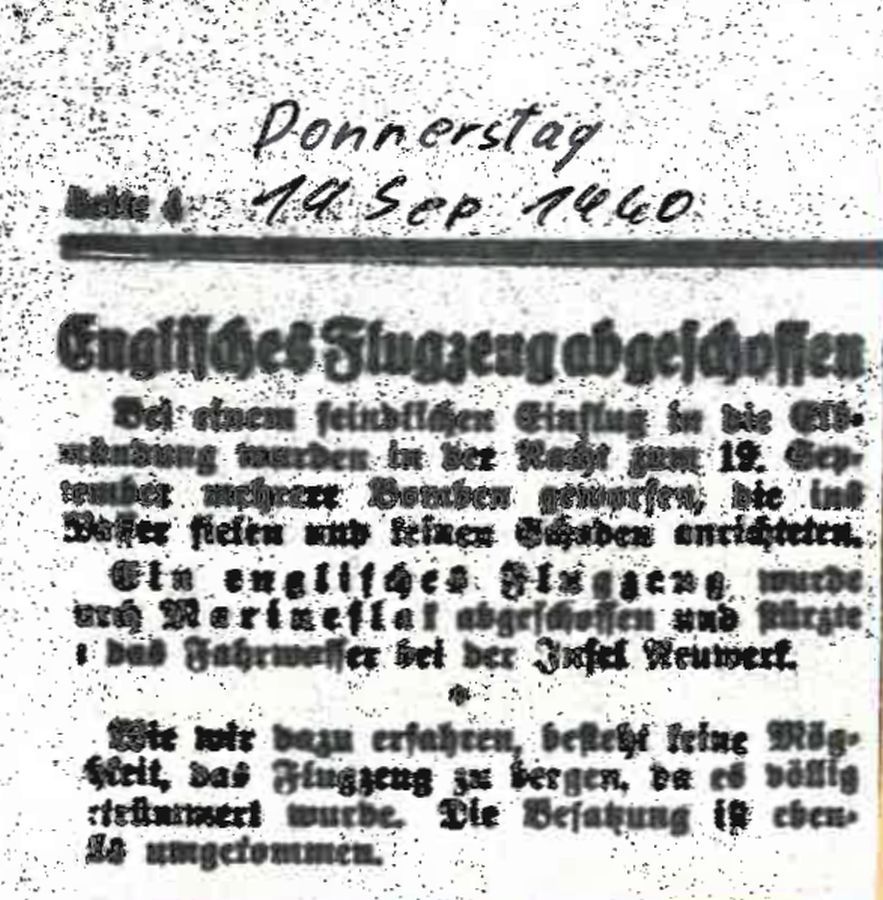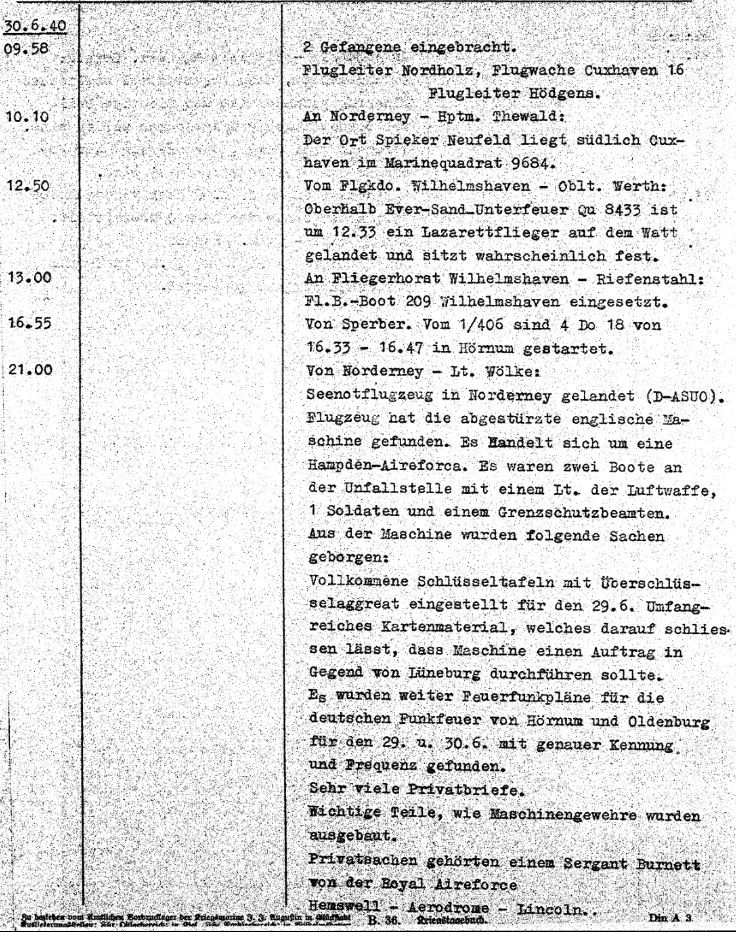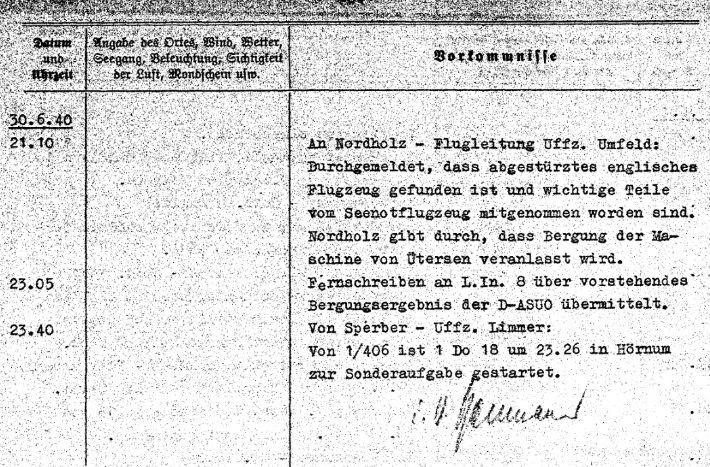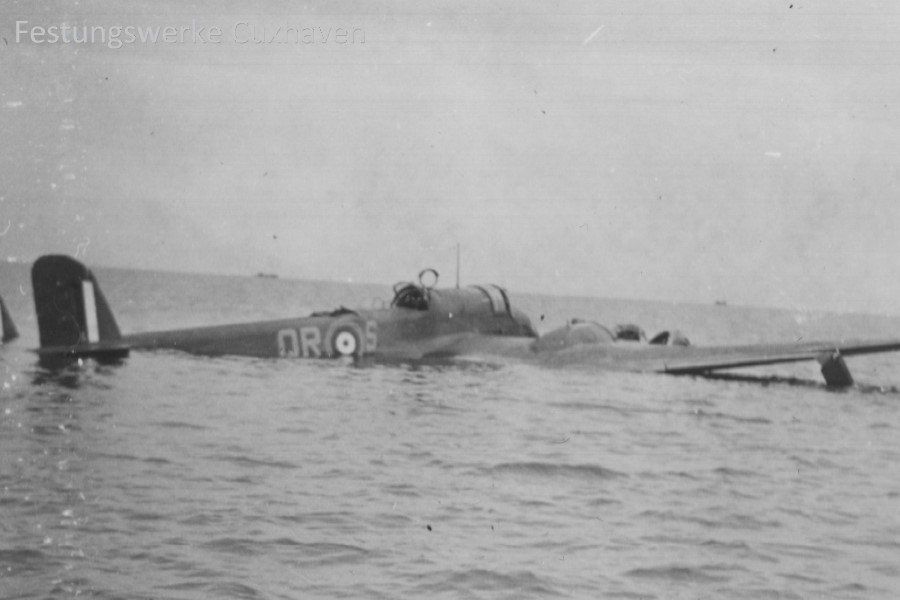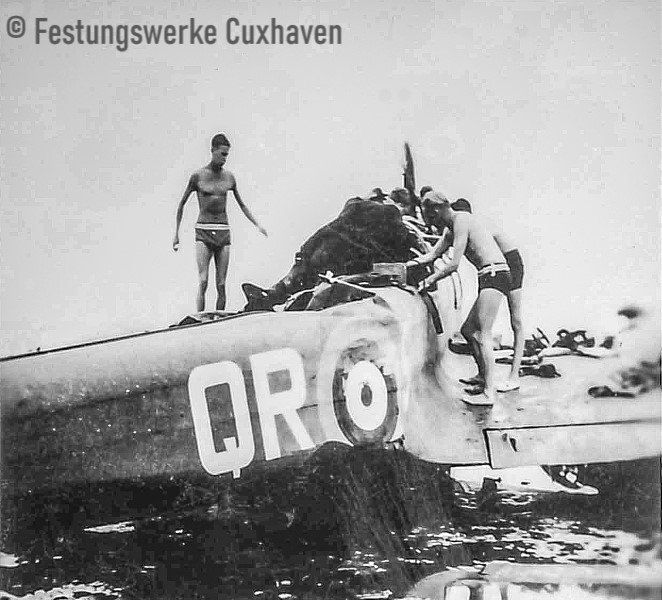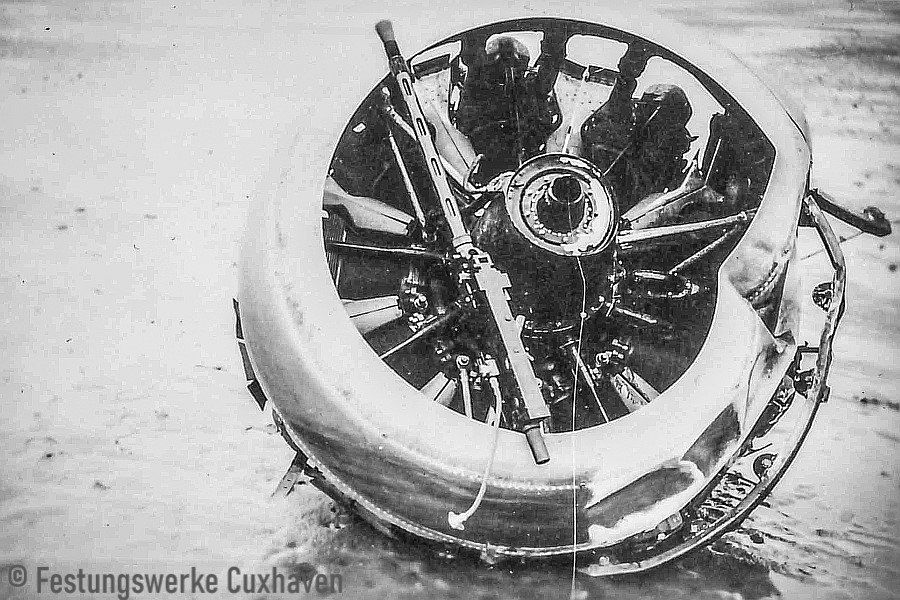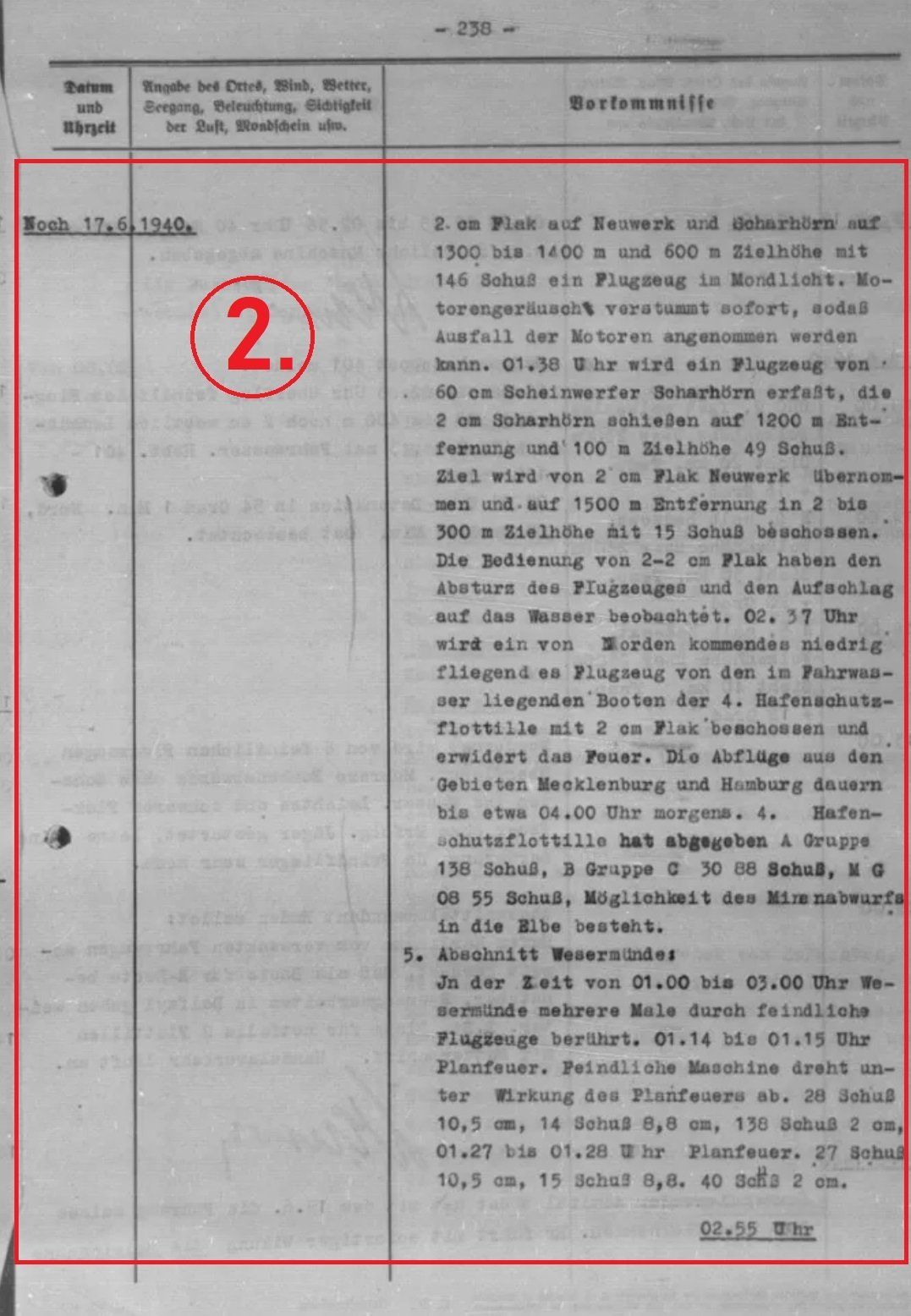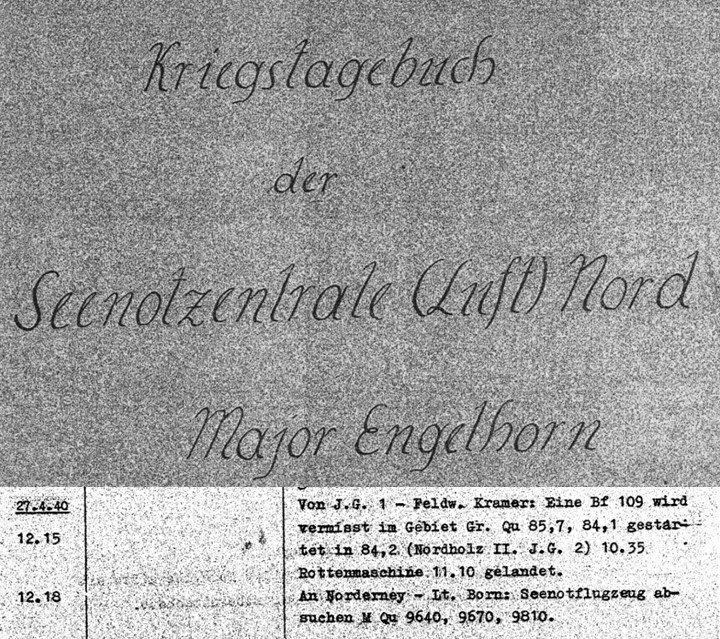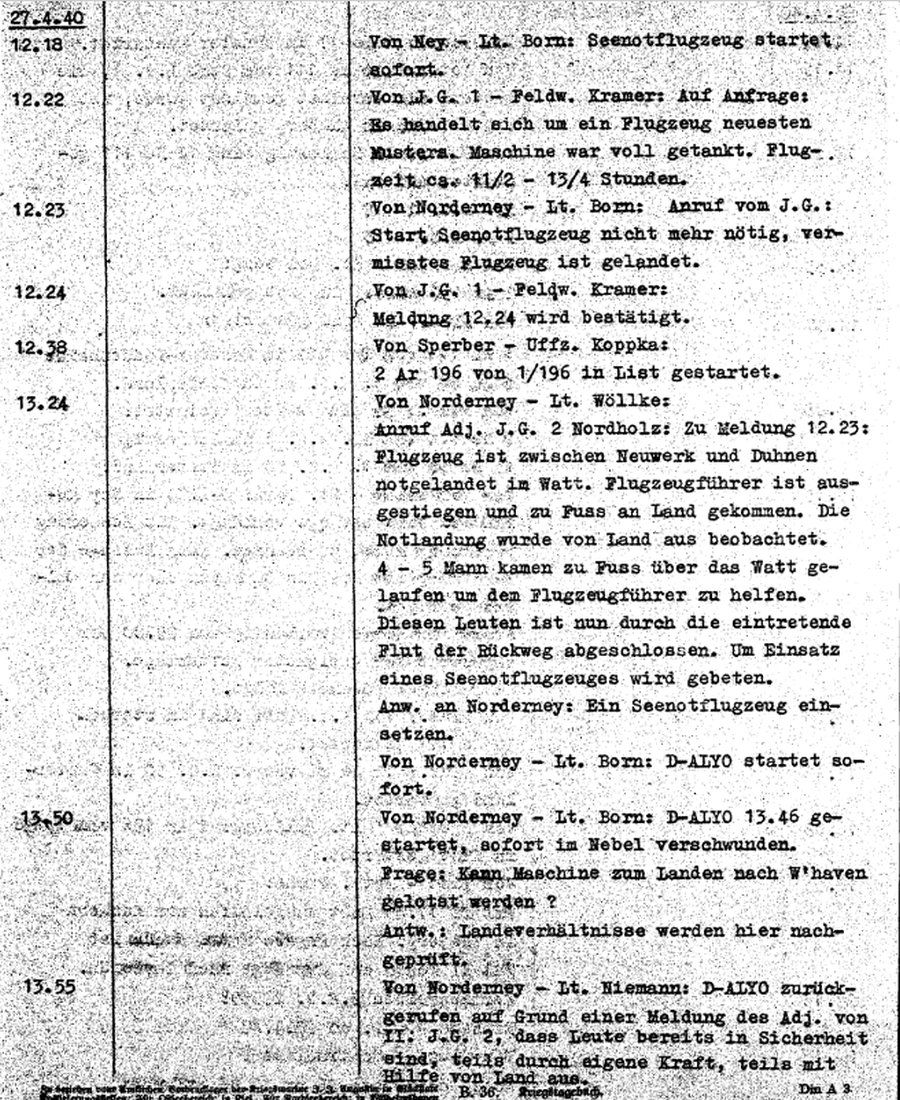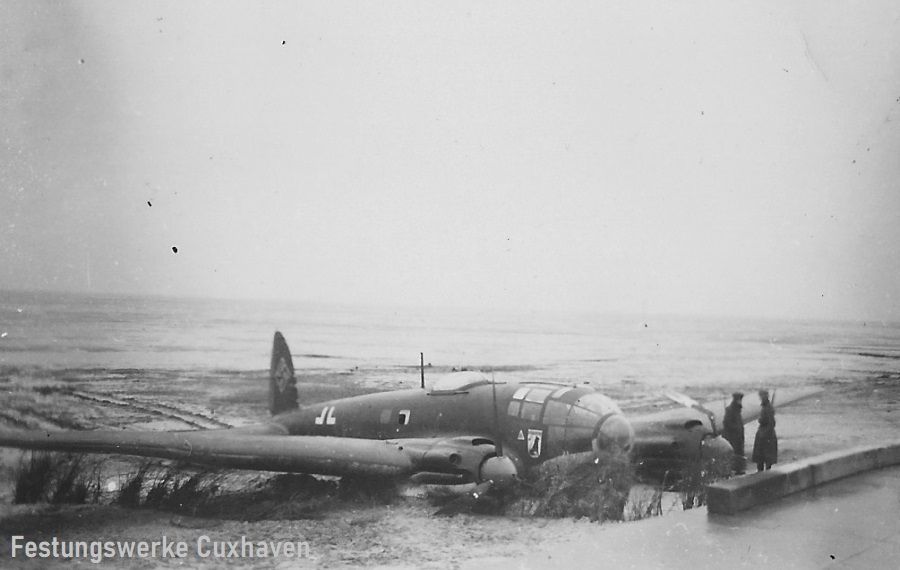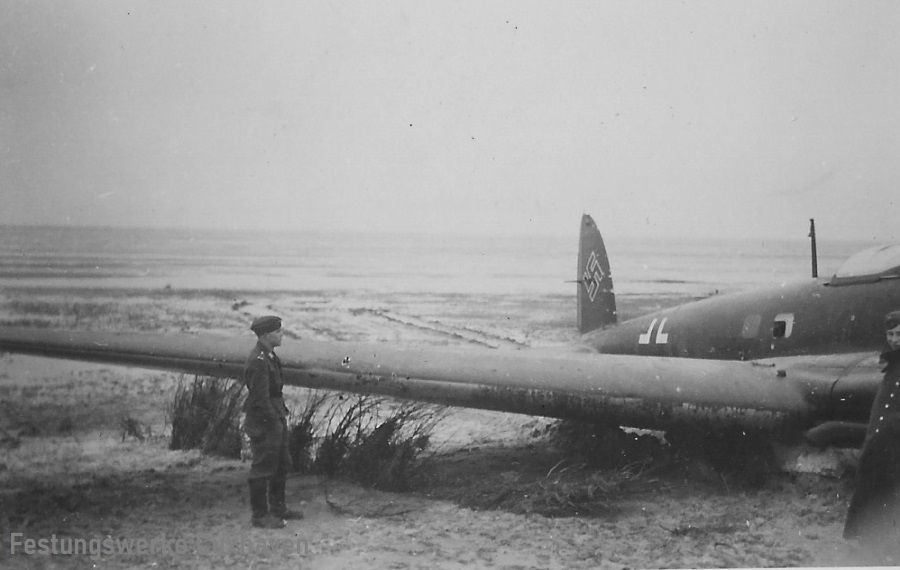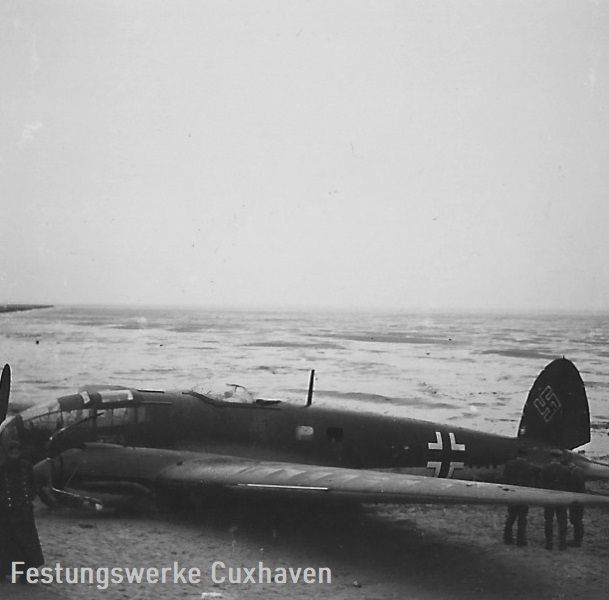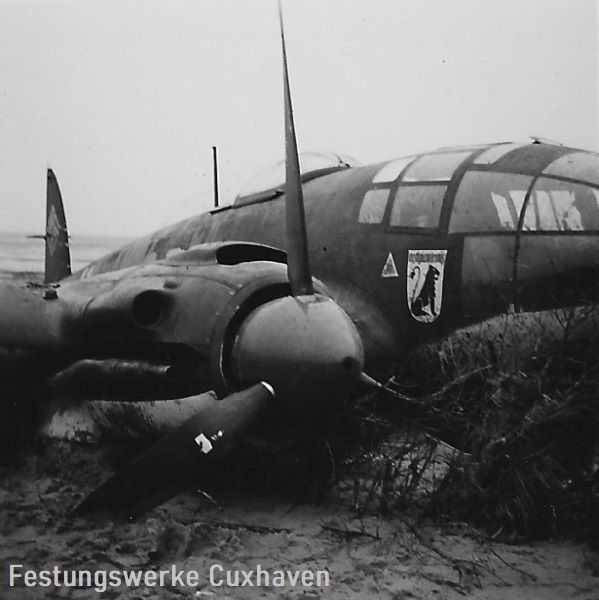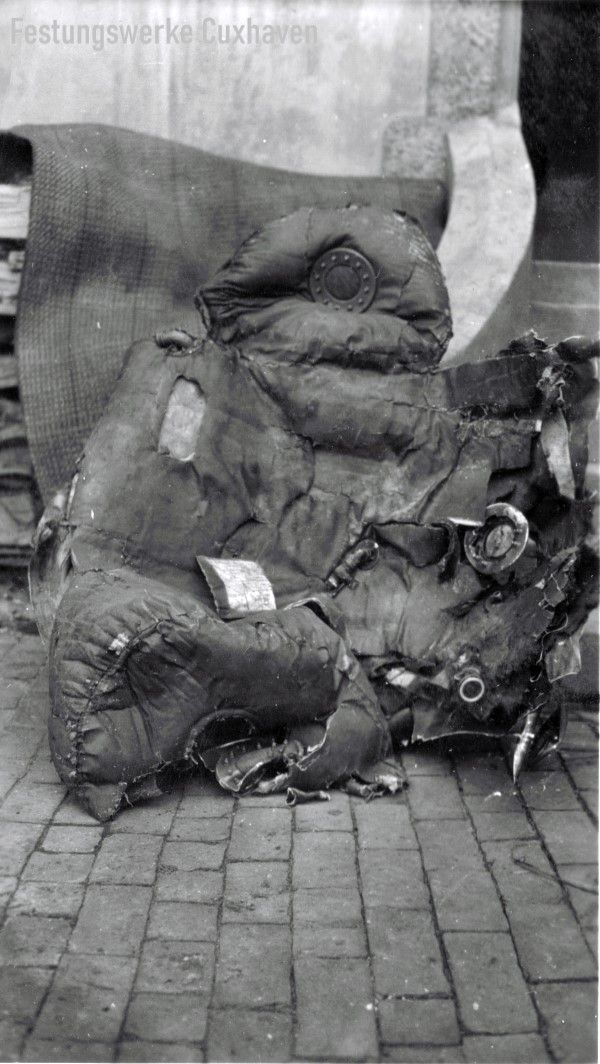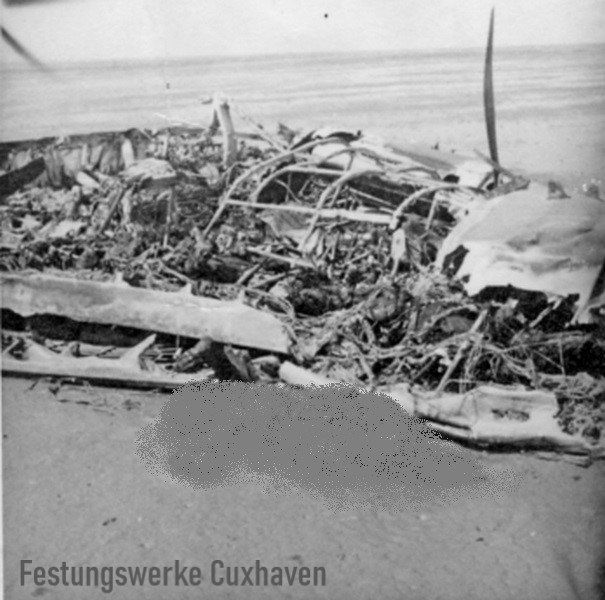Killed/Crashed 1939 - 1946
Im nördlichen Elbe - Weser- Raum und der Helgoländer Bucht
During the war years between 1939 and 1945, many Allied aircraft were shot down by anti-aircraft guns or fighters in the Cuxhaven sector, the forward islands, the German Bight and the Elbe-Weser area. But German aircraft were also affected by air battles, crashes or emergency landings. After the war, there were still aircraft accidents during routine Allied flights. The losses listed in the table reflect the sometimes high losses and the corresponding number of victims on both sides. However, by no means all cases are listed here; the number of unreported cases is clearly higher.
The recorded kills are based, among other things, on data from preserved lists by Stefan Ilsemann and Thorsten Perl, as well as from German war diaries and British and American records. This made it possible to conduct further research online, which ultimately led to this result.
Area of the city of Cuxhaven with its districts and the mudflats directly off the coast.
Area of the river mouths of the German North Sea coast and Heligoland Bight
Area of the municipalities of Land Wursten with the Nordholz air base of the Luftwaffe.
Bereich der Stadt Otterndorf, den Gemeinden des Landkreises Land Hadeln und des Abschnitts UGRUKO Balje.
Area of the Wesermünde section with Bremerhaven and the western side of the Weser.
Area around the municipalities of Stade, Rothenburg-Wümme and Bremervörde.
So far 242 confirmed shootdowns, crashes and aircraft accidents, last change: 23.05.2024
Datum
background
Quelle
03.01.1946

Aircraft type: P 51 Mustang, 406th FG, aircraft crashed into the Elbe about 8 km east of Cuxhaven for unknown reasons. Pilot Lt. George J. Stokes remained missing.
Source: Kill List Land Wursten
26.04.1945

Aircraft type: Hawker Tempest V, Reg. No.: NV967, 486 Squadron, Royal Air Force. The aircraft was knocked out by anti-aircraft fire and crash-landed near Uthlede (Wem.). The New Zealand pilot Keith Alexander Smith was able to save himself and was taken prisoner of war after being arrested, from which he was able to escape on May 4, 1945.
Quelle: S. Ilsemann
Quelle: https://www.rafcommands.com/database/serials/details.php?uniq=NV967
25.04.1945

Aircraft type: Supermarine Spitfire IX, Reg. No.: NH488, 349 Squadron, Royal Air Force. The fighter aircraft was deployed on patrol flights in northern Germany. South of Bremerhaven, the aircraft apparently carried out a ground attack on German troop concentrations, where it was successfully attacked by light anti-aircraft fire. The aircraft was badly hit and crashed near Stotel (Wem.) and was completely destroyed. The Belgian pilot FLT.Lt.Antoon Claesen was killed. He was transferred to Belgium after the war and buried in the Schoonselhof in Antwerp.
Quelle: S. Ilsemann
Those: https://luchtvaartgeschiedenis.be/content/spitfire-nh488-bij-stotel-antoon-claesen
19.04.1945

Aircraft type: Supermarine Spitfire LF XVI, Reg. No.: TB793, 4D-?, 74 Squadron, Royal Air Force. The aircraft took off at 6:15 p.m. on a patrol flight in the Elbe-Weser area. The aircraft was set on fire by light anti-aircraft fire near Bremerhaven. It crashed near Dorfhagen (Wem.) with a long trail of smoke, burning; pilot Luke Barnes was killed in the crash. He was buried in the cemetery in Dorfhaben and after the war transferred to the honorary cemetery in Becklingen.
Quelle: S. Ilsemann
Those: https://aircrewremembered.com/barnes-luke.html
14.04.1945

Aircraft type: De Havilland Mosquito NF MK 30, light twin-engine bomber, Reg. No. NT494, registration: VY-N, 85 Squadron, Royal Air Force/GB. The aircraft took off on April 13, 1945 at 9:53 p.m. for a night fighter mission during a major attack on Kiel/Schleswig-Holstein. During the flight, the aircraft was mistaken for an enemy aircraft by a Lancaster bomber and accidentally shot at. It was hit heavily and had to return home. A short time later, it was involved in an air battle with a He 219 Uhu night fighter. During the battle, the English aircraft managed to hit the German aircraft several times. F/L Thomas stated that, in his opinion, the "Uhu" crashed about 30 kilometers north of Hamburg. Sometime after midnight, the damaged and now burning Mosquito NT494/N was attacked and shot at by a "German night fighter." According to F/Lt Thomas, the fighter was attracted by the fire that illuminated the Mosquito. F/L Thomas managed to free himself from the aircraft, but F/O Hamilton was killed as a result of the crash near Armsdorf (LK.Land Hadeln).
Those: https://aviation-safety.net/wikibase/139968
Those: http://heroesofourtime.co.uk/charles-blackley-hamilton-dfc.html
Quelle: S. Ilsemann
14.04.1945

Aircraft type: Messerschmitt ME 163 (Komet) JG. 400, emergency landing of the rocket fighter in the immediate vicinity between Altenwalde and Nordholz. The '163' had separated from the '110' during the attack by the British fighters and flew to the ground in a wide left turn. It finally landed undamaged in a field near the former fish meal factory near the Hohe Lith. However, it was located by the two British fighters and also destroyed by onboard gunfire.
Source: Kill List Land Wursten
14.04.1945

Aircraft type: Messerschmitt Bf 110, crashed after being fired upon by a British fighter on the outskirts of the district of Oxstedt On the evening of April 14, 1945, Squadron Leader John Shepherd of 41./Squadron flew from Twente in Holland with three Spitfires on an armed reconnaissance flight in the area around Bremen. One aircraft turned around due to technical problems and returned to its base. As the two remaining fighters approached Nordholz airfield, two unidentified aircraft were discovered. Shepherd described the situation in his combat report as follows: Two aircraft were spotted taking off from Nordholz. As I flew towards them, I recognised them as a Messerschmitt 163 being towed by a Messerschmitt Bf 110. Despite the rapid approach, I managed to get a short burst of fire on the Messerschmitt 110, scoring hits on the port engine and cockpit. The Me 110 then went into a nosedive left turn, rolled over onto its back and crashed, burning, into a field next to two houses on the outskirts of Oxstedt; both crew members were killed.
Source: Kill List Land Wursten
09.04.194517:45

Aircraft type: Avro Lancaster MK I, heavy four-engine bomber, Reg. No.: RF121, identification: QR-J, Royal Air Force, 61 Squadron. The aircraft took off at 14:45 from Skellingthorpe airfield/GB and was on its way to a daytime attack on the oil processing industry in Hamburg. After completing the attack on the target, the aircraft turned and headed west. According to the tail gunner, the bomber was suddenly attacked by two Messerschmitt 262 jet fighters. According to his statements, one of the aircraft was shot down, but the second one hit the bomber devastatingly. Shortly before reaching the coast, the aircraft exploded and crashed near Horst, west of Kirchwistedt (Wem.). 3 crew members were able to escape by parachute, 5 others were killed in the crash. The killed crew members were buried on April 15, 1945 in the cemetery in Kirchwistedt as unknown English pilots and transferred to Becklingen in 1947.
Those: https://aircrewremembered.com/greenfield-albert-paulton.html
Those: https://losses.internationalbcc.co.uk/loss/101749/
09.04.1945

Aircraft type: Avro Lancaster MK I, heavy four-engine bomber, Reg. No.: NG342, identification: VN-S, Royal Air Force, 50 Squadron. The aircraft took off at 14:42 from Skellingthorpe airfield/GB and was on its way to a daylight raid on the oil processing industry in Hamburg. The bomber was probably hit by heavy anti-aircraft fire, which caused it to crash. The aircraft exploded near Wollingst (Wem,) and fell to the ground in several fragments. Two days later, five bodies were recovered from part of the wreckage and buried in Wollingst cemetery. On November 12, 1945, the two remaining crew members were found under another part of the wreckage and also buried in Wollingst. In February 1947, the remains were exhumed and buried next to each other in the British military cemetery in Hamburg-Ohlsdorf.
Quelle: S. Ilsemann
Those: https://aviation-safety.net/wikibase/94023
Those: https://losses.internationalbcc.co.uk/loss/101749/
07.03.1945

Aircraft type: Avro Lancaster MK III, heavy four-engine bomber, Reg. No.: ME474, Registration: QR-V, Royal Air Force, 61./ Squadron. The aircraft took off at 17:50 from RAF Skellingthorpe, Lincolnshire and was on its way to an attack on the oil processing industry in Hamburg/Harburg. For reasons that have not yet been determined, the aircraft crashed over the German Bight and went into the sea. The entire seven-man crew was killed. Pilot F/OFS Farren from Australia was washed up on the German coast and later buried in the Nederweert cemetery in the Netherlands. Flight Engineer Sgt. W. McMarth was washed up on the beach in Cuxhaven and later buried in the Ehrenfriedhof in Becklingen.
Those: https://aviation-safety.net/wikibase/279691
07.03.1945

Flugzeugtyp: Avro Lancaster MK III, schwerer viermotoriger Bomber, Reg.Nr.: PB417, Kennung: KM-R, Royal Air Force, 44./ Rhodesia Squadron (Simbabwe). Die Maschine startete um 18:26 Uhr vom Flugplatz RAF Spilsby/GB. und war auf dem Weg zu einem Angriff auf die ölverarbeitende Industrie in Hamburg/Harburg. Der Bomber erhielt über dem Zielgebiet mehrere Treffer, wo durch drei der vier Motoren Feuer fingen. Nach einer langen Sinkphase, gelang den Piloten eine erfolgreiche Notwasserung in der Wesermündung hinzulegen. Glücklicherweise landete die Maschine auf einer Sandbank an der Wattkante, zu diesem Zeitpunkt herrschte Ebbe. Das Wetter an diesem Tag war kalt und nebelig. Trotzdem schaffte es die Besatzung des DGzRS Seenotrettungsbootes "Geheimrat Gerlach" der Station Dorum am nächsten Morgen, dass Flugzeug zu finden. Unter Vormann Ernst-Hinrich Huck gelang die erfolgreicher Übernahme der gesamten Flugzeugcrew, danach ging es nach Bremerhaven. Keiner der Lancaster-Besatzung kam bei diesem Absturz ums Leben, aber alle gingen in die Kriegsgefangenschaft.
Those: https://aviation-safety.net/wikibase/159252
Those: https://www.spiegel.de/geschichte/zweiter-weltkrieg-seenotrettung-vom-feind-gerettet-a-1159630.html
07.03.194522:30

Flugzeugtyp: Avro Lancaster MK III, schwerer viermotoriger Bomber, Reg.Nr.: ME452, Kennung: CA-Q, Royal Air Force Volunteer Reserve, 18 Squadron. Die Maschine startete vom Flugplatz Fulbeck/GB. und war auf dem Weg zu einem Angriff auf die ölverarbeitende Industrie in Hamburg/Harburg. Vermutlich erhielt der Bomber zwischenzeitlich erhebliche Flaktreffer, die letztendlich zum Absturz führten. Das Flugzeug ging bei Frelsdorf in der Nähe einer Hauptstraße nach einer Explosion zu Boden, drei Mann konnten sich noch per Fallschirm retten.
Nach Berichten wurden 4 Besatzungsmitglieder auf dem Friedhof in Geestemünde beigesetzt (später nach Becklingen überführt). Ein Besatzungsmitglied wurde zwei Tage später bei Ohlerstedt/Hambergen durch die Polizei festgenommen, zwei kurze Zeit später ebenfalls.
Quelle: S. Ilsemann
Those: https://losses.internationalbcc.co.uk/loss/110579/
Those: https://www.rafcommands.com/forum/showthread.php?19021-189-Sqn-Lancaster-ME452-CA-Q-March-7-1945/page2&p=167642#post167642
Those: http://www.luftkrig1939-45.dk/pdf/Marts_1945/Kap_31.pdf
22.02.1945

Aircraft type: De Havilland Mosquito FB MK VI, light twin-engine bomber, Reg. No. NS981, 487 Squadron, Royal Air Force/GB. The aircraft was deployed during "Operation Clairon" in the Elbe-Weser area and was shot down by a railway anti-aircraft gun of the 3rd Flak Division between Brillit-Barchel-Oerel (ROW.). The crew was able to escape by parachute and was later arrested.
Those: https://aviation-safety.net/wikibase/89908
Those: http://www.chronicles-of-the-luftwaffe.de/
22.02.1945

Aircraft type: De Havilland Mosquito FB MK VI, light twin-engine bomber, Reg. No. PZ380, registration: SM-J, 305 Squadron, Royal Air Force/GB. The aircraft was flown by W/O Smith and F/SGT Robertson and left the base at 11:35 a.m. for a daytime raid on northern Germany, "Operation Clarion". The aircraft was badly damaged by anti-aircraft fire near Bremen and flew north with the engine on fire. The aircraft then crashed near Kassebruch (Wem.). While F/SGT Robertson survived the crash, W/O E. Smith was killed in the crash. He was buried in the cemetery in Kassbruch and transferred to the Becklingen Cemetery of Honor after the war.
Quelle:https://aviation-safety.net/wikibase/165906
Those: http://www.chronicles-of-the-luftwaffe.de/?p=799
Quelle: S. Ilsemann
14.01.1945

Aircraft type: De Havilland Mosquito FB VI, light twin-engine bomber, Reg. No. PZ465, identification: 3P-?, 515 Squadron/GB. - 100 Group. The aircraft took off from the "Little Snoring" airfield near Norfolk/GB. on a patrol flight towards Husum/Jagel. The aircraft was shot down over Cuxhaven and crashed south of Berensch. The Drangst anti-aircraft battery was credited with the shoot-down. However, Uffz. Kurt Scherer of 4./NJG4 also laid claim to it, as he was also said to have been involved in an air battle in this area. There are photos of the shoot-down (wreckage) in Gerd Wildfang's book.
http://aircrewremembered.com/bennett-cyril-victor.html
31.12.1944


Aircraft type: Boeing B17 "Flying Fortress", 42-97215, 'Scooter', 95 BG, 334 BS, heavy four-engine bomber of the USAAF. The bomber was part of a major attack on the city of Hamburg. The bomber was probably shot down by German fighters and crashed in the Wesermünde sector, probably on the Rotenburg district border. According to witnesses from another aircraft, parachutes could still be seen. 5 crew members were able to escape by parachute, 4 other men lost their lives. Three of them were buried in the Rotenburg cemetery for the time being. MACR Air Crew Report 11368, Report Luftgau KU 3493 (KU is the abbreviation for combat aircraft documents).
From report MACR 11368: Hit by enemy fighters 6 to 8 minutes after bombs gone. Attack was made at an altitude of 5 to 7 o'clock and out of the sun. Aircraft was hit on No. 3 engine on first approach, causing it to catch fire. Pilot attempted to extinguish fire but was unsuccessful. Aircraft flew in a slow spiral under reasonably good control. Parachute was seen before aircraft disappeared from sight at 1153 o'clock at 53-20 N, 09-30 E."
Those: https://b17flyingfortress.de/b17/42-97215/
Those: http://thepastpresented.com/index.php/tag/b-17g-43-97215/
Quelle: Abschussliste Land Wursten, T.P.
Those: https://www.americanairmuseum.com/archive/aircraft/42-97215
Quelle: Dave Osborne, B-17 Fortress Master Log
31.12.1944

Flugzeugtyp: Boeing B17 "Flying Fortress", 42-31895, 'Miss Chief', 100 BG, 418 BS, schwerer viermotoriger Bomber der USAAF. Der Bomber war Teil eines Großangriffs auf die Stadt Hamburg. Nach Angriff eines deutschen Jägers stürzte das Flugzeug schwer getroffen im Abschnitt Wesermünde ab. Genauer Absturzort ist nicht bekannt. 9 Crewmitglieder konnten sich retten und gingen im Anschluß in die Kriegsgefangenschaft.
Those: https://100thbg.com/aircraft/?aircraft_id=10198
Those: https://www.americanairmuseum.com/archive/aircraft/42-31895
Quelle: Abschussliste Land Wursten, T.P.
Source: 31-12-1944_NARA T-1022 R-2161_S648_Commander Bremerhaven 1943-44
31.12.1944

Aircraft type: North American P 51-D / Mustang, single-engine light fighter, USAAF, 44-13786, registration: CV-B, 359th FG, 368th FS, crashed after anti-aircraft fire near Großenhain (Wem.). The pilot was killed.
Quelle: S. Ilsemann
Those: http://www.forgottenprops.warbirdsresourcegroup.org/p51dk-mustang-4413001-4414000.html
26.11.1944

Aircraft type: Messerschmitt Me 262 A-2a, twin-engine light fighter, German Air Force, 1./KG 51, 9K PK, red P.From 09:36, five flights of four Me 262s each took off from Hopsten/NRW on a large-scale mission, each carrying two SD 250 bombs against enemy artillery positions in Roermond, Dürn, Helmond and Nijmegen. Along with four of his comrades, Oberlt Heinz Lehmann was also killed. He crashed his Me 262 3 km south of Kirchwistedt, southeast of Bremerhaven, for unknown reasons. What brought him to this place in the north is also not known. He probably ran out of fuel in the air. Lehmann is buried in Stade, Garrison Fdh Row 1, Grave 23. The WNr of his Me 262 is not known, it could have been 170299 (9K PK).
Quelle:https://aviation-safety.net/wikibase/218273
21.11.1944

Aircraft type: Consolidated - B 24 / Liberator, Reg. No.: 42-100337, 445th BG, 701 BS, USAAF. There is little information about the aircraft. It only crashed after being hit by anti-aircraft guns at Dingen (Wem.), now Imsum. Of the 9 crew members, 7 died, one survived, and there is no information about one crew member.
Eyewitness report: In the morning, shot down by the Brinkamahof anti-aircraft battery, tail shot off, broke apart and came down in the curve near the school on Büttelweg, some still tried to jump off.
Quelle: S. Ilsemann
Those: https://www.americanairmuseum.com/archive/aircraft/42-100337
Quelle: Abschussliste Land Wursten / T.P.
11.11.1944

Aircraft type: Avro Lancaster, heavy four-engine long-range bomber. After being fired upon by the Oste anti-aircraft and barrier battery, the aircraft was hit and caught fire. The aircraft flew further south until it crashed about 6 kilometers northeast of Bremervörde.
Aircraft type: Avro Lancaster, heavy four-engine long-range bomber. Reg. No.: NN714, registration: PO-W, Royal Australian Air Force, 467 Squadron. The aircraft took off from an airfield near Waddington/GB on November 11, 1944 at 4:18 p.m. and was on its way to an attack on Hamburg/Harburg. After being hit by anti-aircraft guns, the aircraft crashed near Kürstedt. According to reports, a night fighter was also involved in this shootdown, but no usable information is available. 6 crew members were killed in the shootdown, 1 crew member survived and was taken prisoner of war.
Both reports probably refer to the same aircraft. On that day, only one Lancaster is known to have been shot down in this area and Bremervörde is not far from Kürstedt.
Quelle: S. Ilsemann
Quelle: T 1022 R 2241-S187
Those: https://www.backtonormandy.org/the-history/air-force-operations/airplanes-allies-and-axis-lost/lancaster/17983-NN7141944-11-12.html
Quelle:https://aircrewremembered.com/eyre-thomas-frank.html
Quelle:https://aircrewremembered.com/eyre-thomas-frank.html
Quelle: 11-11-1944_NARA T-1022 R-2161_S625_Kommandant Bremerhaven 1943-44
25.10.194413:16 o'clock

Aircraft type: Boeing B17 "Flying Fortress", 42-97899, 457 BG, 748 BS, heavy four-engine bomber of the USAAF. The bomber was on an air raid with its squadron on Münster. At Bremerhaven it was hit heavily by anti-aircraft fire in the right structure, a short time later the engines and the wing were fully ablaze. After four minutes the aircraft broke apart, exploded in the air and crashed near Drangstedt (Wem.). 3 crew members were killed, 6 crew members were able to escape by parachute and were taken prisoner of war.
Quelle: S. Ilsemann
Quelle: https://www.americanairmuseum.com/archive/aircraft/42-97899
Those: https://americanveteranscenter.org/avc-media/magazine/wwiichronicles/issue-xxv-summer-2004/ready-or-not-into-the-wild-blue/
Source: 25-10-1944_NARA T-1022 R-2161_S614_Commander Bremerhaven 1943-44
15.10.1944

Aircraft type: Messerschmitt Bf 110 G-10 (D5 LK) - 2./NJG 3. The aircraft flew into the old shipyard during a night mission while hovering at Nordholz Air Base and was completely destroyed by the fire that followed. Crew: Obfw. FF Gottfried Lentinghoff born 05.09.1916 from Sehlieb-Düren, Uffz. Bf. Erich Otto Kretsch born 09.08.1921 and Uffz. Bw. Ludwig Hartmann born 28.09.1920 from Oberscheld-Dillkreis. Nothing is known about the condition of the crew.
Source: Kill List Land Wursten
Source: Loss list NJG.3-Nordholz
12.10.1944

Aircraft type: North American P 51-D / Mustang, single-engine light fighter, USAAF, 44-14074, 364thFG, 384thFS, pilot Lt. Frank T.Kosloski, aircraft crashed near Spieka - Knill after being hit by anti-aircraft guns, pilot made a crash landing and was subsequently taken prisoner of war. Heavy air battle between German and American air forces in the Elbe - Weser area.
Quelle: W.Oe.
Quelle: T 1022 R 2243-S440
12.10.1944

Aircraft type: North American P 51-D / Mustang, single-engine light fighter, USAAF, 44-13347, registration: 5E-Z, 364thFG, 385thFS, crashed after being shot down by a German fighter plane in the Bremervörde area, 2nd Lt. Wilfred A. Pohmer ( ), MACR 9503. Heavy air battle between German and American air forces in the Elbe-Weser area.
Quelle: W.Oe.
12.10.1944

Aircraft type: North American P 51-D / Mustang, single-engine light fighter, USAAF, 44-13899, registration: 5E-E, 364thFG, 385thFS, crashed after being shot down by a German fighter plane, crash near Alfstedt, 2nd Lt. Harold D. Joy ( ), MACR 9504. Heavy air battle between German and American air forces in the Elbe-Weser region.
Quelle: W.Oe.
12.10.1944

Aircraft type: North American P 51-D / Mustang, single-engine light fighter, USAAF, 44-14708, 364thFG, 385thFS, shot down by a German fighter plane, crashed near Sanddamm (Wanna), 1st. Lt. Roy A. Crouch, Jr., pilot subsequently became a prisoner of war, MACR 9507. Heavy air battle between German and American air forces in the Elbe-Weser area.
Quelle: W.Oe.
12.10.1944
12:15 Uhr

Aircraft type: Messerschmitt Bf 109 - G14, single-engine light fighter, German Air Force, 12th Squadron, JG. 26, serial number 461538, pilot Obfnr. Hans.Theodor Bühring , buried in Stade. Heavy battle between German and American air forces in the Elbe-Weser area.
Quelle: W.Oe.
12.10.1944
12:20 Uhr

Aircraft type: Messerschmitt Bf 109 - G14, single-engine light fighter, German Air Force, 9th Squadron, JG. 26, serial number 461979, pilot Obergefr. Horst Grimm , crash site Hippstedt, burial site in Stade. Heavy battle between German and American air forces in the Elbe-Weser region.
Quelle: W.Oe.
12.10.1944
12:20 Uhr

Aircraft type: Messerschmitt Bf 109, single-engine light fighter, German Air Force, 9th Squadron, JG. 26, serial number 781300, pilot Lt. Heinz Schild , crash site Bremervörde. Heavy battle between German and American air forces in the Elbe-Weser region.
Quelle: W.Oe.
12.10.1944

Aircraft type: Focke Wulf 190 A-8, single-engine light fighter, German Air Force, JG. 26, serial number 171642, pilot Lt. Edmund Fischer , crash site probably Bremervörde area, pilot missing. Heavy battle between German and American air forces in the Elbe-Weser area.
Quelle: W.Oe.
12.10.1944

Aircraft type: Focke Wulf 190 A-8, single-engine light fighter, German Air Force, JG. 26, serial number 171580, pilot Fhr. Martin Hennemann, crash site probably Bremervörde area, pilot missing. Heavy battle between German and American air forces in the Elbe-Weser area.
Quelle: W.Oe.
06.10.1944

Aircraft type: Consolidated - B 24 / Liberator, Reg.No.: 42-51283, 489th BG, 844 BS, USAAF. There is little information available about the aircraft. It only crashed after being hit by anti-aircraft guns near Lehnstedt (Wem.).
Quelle: S. Ilsemann
Quelle: https://www.americanairmuseum.com/archive/aircraft/42-51283
05.10.1944

Aircraft type: Supermarine Spitfire MK XI, Reg. No.: PA945, CH-A, 524 Squadron. The aircraft took off from RAF Benson air base in Oxfordshire and was on a reconnaissance mission near Hamburg. It crashed near Kleinwörden near Hechthausen, presumably after suffering severe damage from anti-aircraft fire. The pilot was able to save himself and was subsequently taken prisoner of war.
Quelle: S. Ilsemann
Those: https://aviation-safety.net/wikibase/158481
26.09.1944
17:27 Uhr

Aircraft type: Boeing B17 "Flying Fortress" B-17 47-37818 'Hurry Home', 447 BG, 709 BS, heavy four-engine bomber of the USAAF. Direct hit by anti-aircraft fire over Bremerhaven, where the right wing and the engines caught fire. During takeoff, the aircraft suddenly went into a spiral dive and exploded in the air a short time later. Burning parts of the bomber hit the mudflats about 3 kilometers from the Dorumer Tief. 7 crew members were killed, 2 men were able to escape by parachute and were subsequently arrested.
From the Paddingbüttel Chronicle: Two white parachutes were swinging high above in the blue air. They drifted eastwards. I later heard that the fuselage and wing were whirled through the air as individual pieces and hit the Misselwarden sand. One plane landed at Icken-Mangels in Dorum-Strich, the other at Liebert in Oberhausen.
Quelle: Jan Hey
Quelle: T 1022 R 2243-S435
Quelle: S. Ilsemann
Those: https://www.americanairmuseum.com/archive/aircraft/43-37818
Quelle: Abschussliste Land Wursten, T.P.
Quelle: 26-09-1944_NARA T-1022 R-2161_S585_Kommandant Bremerhaven 1943-44
18.09.194422:06 o'clock

Aircraft type: Avro Lancaster I, heavy four-engine bomber, Reg. No.: NG126, registration: DX-L, Royal Air Force, 57 Squadron. The aircraft took off from East Kirby airfield in Lincolnshire/GB on September 18, 1944 at 6:27 p.m. and was on its way to attack Bremerhaven. The 5th Group sent a total of 206 Lancasters and 7 Mosquitoes that night, which together dropped almost 900 tons of bombs. The city had not been seriously bombed up to that point, but that night it received a devastating blow. 2,670 buildings were destroyed, and another 369 were seriously damaged. Thirty thousand people lost their homes. The human losses were 618 people, 1193 were injured. After the bombing, the Lancaster NG126 was turning away from the target when it was hit by incendiary bombs from another aircraft, which set the plane on fire. The bomber then exploded on the outskirts of Bremerhaven and crashed near Schiffdorf/Reinckenheide. 7 crew members were killed in this crash and were later buried in the honorary cemetery in Becklingen. One crew member survived and was transferred to STALAG-Luft/Bankau-Kreuzburg/PL. as a POW.
Quelle: S. Ilsemann
Those: https://aircrewremembered.com/waugh-robert-john.html
Those: https://www.rafcommands.com/database/serials/details.php?uniq=NG126
Quelle: https://losses.internationalbcc.co.uk/loss/114374
Those: https://www.fronta.cz/kalendar/nalet-na-bremerhaven-v-noci-na-19-9-1944
Source:18-09-1944_NARA T-1022 R-2161_S582_Commander Bremerhaven 1943-44
18.09.194422:10 o'clock

Aircraft type: De Havilland Mosquito B MK IV, light twin-engine bomber, Reg. No. DZ635, identification: AZ-N, 627 Squadron/GB. - 100 Group, Royal Air Force Volunteer Reserve. The aircraft took off on September 18, 1944 at 7:03 p.m. from RAF Woodhall Spa airfield as a pathfinder for an air raid on Bremerhaven. The aircraft was fired upon by heavy anti-aircraft guns from the Wesermünde sector and shot down over Bremerhaven. The aircraft exploded in mid-air, debris fell near Schiffdorfer Damm (Wem.), and the crew lost their lives. Both were buried in the Geestemünde civil cemetery, and in 1947 they were reburied in the Becklingen Cemetery of Honor.
Those: https://aviation-safety.net/wikibase/71848
Quelle:https://www.rafcommands.com/database/serials/details.php?uniq=DZ635
Quelle: S. Ilsemann
Source:18-09-1944_NARA T-1022 R-2161_S582_Commander Bremerhaven 1943-44
29.08.1944

Aircraft type: Probably 2 x Bristol Beaufighter - twin-engine fighter-bomber. Aircraft 1: Bristol Beaufighter TF Mk X, Reg. No. LZ217 - QM-Q, 254 Squadron Royal Air Force (254 Sqn RAF) from RAF North Coates air base, Lincolnshire, 2-man crew . Nothing else is known about the alleged second aircraft shot down. Heavy air-sea battle in the mouth of the Elbe at Elbe 1. Around 60 - 80 Bristol Beaufighters attacked a German mine clearing unit. Two mine breakers were sunk, two British aircraft were shot down and went into the water. Whereabouts of the aircraft crews unknown. >Combat reports click here
Source: KTB-KTB 8. Vp-Fl (1944-August-16-31)
Quelle: Accident Bristol Beaufighter TF Mk X LZ217, 29 Aug 1944 (aviation-safety.net)
27.08.1944

Aircraft type: unknown aircraft, 7./NJG 3, Uffz.Albrecht Anton born 10.08.1919 from Vienna, shot down near Mulsum.
Source: Kill List Land Wursten
Those: http://www.denkmalprojekt.org/2017/vl-nachtjagdgeschwader-3_wk2.html
23.08.1944

Flugzeugtyp: Messerschmitt Bf 110 G-10 - 2./NJG 3, Beim Start zum Scheinwerferflug setzt ein Motor aus, wodurch das Flugzeug aus ca. 20 m Höhe auf eine Baracke auf dem Flugplatz Nordholz aufgeschlägt. Besatzung: Flugzeugführer. Fw. Hermann Walter Stähler geb. 06.02.1920 aus Niedersetzen - Siegen ist schwer verletzt, Obergfr. Bordfunker Herbert Karl Antonius Preuss geb. 09.12.1922 aus Dortmund leicht verletzt, Gefr. Günther Max Gerhard Pieper geb. 08.01.1924 aus Berlin schwer verletzt. Alle Besatzungsmitglieder kamen ins Marinelazarett Cuxhaven.
Source: Kill List Land Wursten
Source: Loss list NJG.3-Nordholz
17.08.1944Night

Flugzeugtyp: Messerschmitt Bf 110 G-10 (G9 +BM) - 4./NJG 1, schwerer zweimotoriger Nachtjäger, RegNr. 440351. Das Flugzeug startete um 23:15 vom Fliegerhorst Deelen/NL zu einem Einsatz gegen anfliegende Bomber der RAF auf Stettin (Pommern) und Kiel (Schleswig-Holstein). Auf Grund von Treibstoffmangel versagten die Motoren und die Messerschmitt ging zur Notlandung über. Bei Cuxhaven - Lüdingworth zerschellte die Maschine bei pechschwarzer Nacht vorzeitig auf dem Boden und wurde stark zerstört. Dabei kam der Flugzeugführer Uffz. Bernhard Fritz Walther geb. 02.05.1920 aus Döbeln - Leipzig ums Leben. Bordfunker Obgfr. Carl Leichner geb. 29.11.1921 - Gladbeck Münster/Westfalen und Bordschütze Gefreiter Herbert Karl Hofmann geb. 19.04.1923 Gößnitz/Thüringen wurden mit Verletzungen gerettet und ins Marinelazarett Cuxhaven überführt.
Source: Kill List Land Wursten
Source: Loss list NJG.3-Nordholz
13.08.194405:57 o'clock

Aircraft type: Unknown four-engine aircraft. Shot down by First Lieutenant Hermann Leube of the 4th NJG 3 from Sylt at an altitude of 4200 m near Cuxhaven. Whereabouts of aircraft and crew unknown.
Aircraft type: Unknown four-engine aircraft. Shot down by Lieutenant Hans Raum 9./NJG3, north of Bremerhaven at an altitude of 6100 m. Whereabouts of aircraft and crew unknown.
Flugzeugtyp: Handley Page Halifax III, schwerer viermotoriger Bomber, Reg.Nr.: MZ760, Kennung: NPU-N, 158 Bomb Squadron, Royal Air Force. Start der Maschine am 12.08.1944 um 21:24 Uhr vom Fliegerhorst Lissettee/GB. zu einem Luftangriff auf Braunschweig. Das Flugzeug stürzte nach dem Angriff eines deutschen Nachtjägers bei Hoßel (Wem.) hinter dem Gasthof Nordpol ab. Vermutlich ist es einer der beiden oben erwähnten Flugzeugabschüsse. Drei Besatzungsmitglieder überlebten den Absturz, 4 ihrer Kameraden kamen dabei ums Leben. Sie wurden auf dem Ehrenfriedhof in Becklingen beigesetzt.
Those: https://www.rafcommands.com/forum/showthread.php?323-Halifax-III-MZ760-NP-N&p=1595#post1595
Those: https://www.backtonormandy.org/the-history/air-force-operations/airplanes-allies-and-axis-lost/halifax/20992-MZ7601944-08-13.html
Those: http://aces.safarikovi.org/victories/doc/victories-germany-ww2-claims-viermottoters.pdf
Quelle: S. Ilsemann
Quelle: Abschussliste Land Wursten, T.P.
Source: 13-08-1944_NARA T-1022 R-2161_S554_Commander Bremerhaven 1943-44
11.08.1944

Aircraft type: Messerschmitt Me 110 G-4 (D5 LL), 440339 - 2./NJG 3, heavy twin-engine night fighter, German Air Force, crash on a workshop flight about 3.5 km north of Otterndorf, Crew: Uffz. Günther Schlomberg was killed in the accident, Uffz. Otto Wagner was wounded.
Source: Kill List Land Wursten
05.08.1944

Aircraft type: Consolidated - B 24 / Liberator, Reg. No.: 41-29557, "Shadrach", 34th Bomb Group, 8th Air Force, USAAF. The bomber was on its way to an air raid on Halberstadt. The aircraft was badly damaged by anti-aircraft fire near Magdeburg. On the way back to England, however, the aircraft crashed near Stubben (Wem.) due to the severe damage. Nine crew members were able to escape, one crew member was killed.
Quelle: S. Ilsemann
Those: https://www.americanairmuseum.com/archive/aircraft/41-29557
Source: 05-08-1944_NARA T-1022 R-2161_S551_Commander Bremerhaven 1943-44
05.08.1944

Aircraft type: Consolidated - B 24 / Liberator, Reg. No.: 42-95162, "Perils of Pauline", 467 Bomb Group, 8th Air Force, USAAF. The bomber had taken off from RAF Rackheath/UK for an air raid on Braunschweig. The aircraft was badly damaged by heavy anti-aircraft fire near Bremerhaven and went into a spiral dive, crashing near Wehdel (Wem.). Two crew members were able to save themselves by parachuting. The seven other men were probably unable to leave the aircraft due to the severe circular dive; they all lost their lives.
Quelle: S. Ilsemann
Quelle: https://www.americanairmuseum.com/archive/aircraft/42-95162
Source: 05-08-1944_NARA T-1022 R-2161_S551_Commander Bremerhaven 1943-44
05.08.194412:45
Aircraft type: Unknown four-engine aircraft. The aircraft crashed west of the island of Neuwerk after being fired upon by the Wangerooge heavy anti-aircraft guns.
Which: T-1022 R -2148_S159
05.08.1944

Aircraft type: North American P-51B-5-NA "Mustang", single-engine light fighter, USAAF, 43-6864, 352thFG, 386thFS, pilot David J. French. The aircraft was shot down in an aerial combat by Fhr. Oswald Ilsemann of the 2nd Group JG 3 "Udet". The American pilot was able to save himself by parachuting and was taken prisoner of war by the Germans (STALAG Luft III). The aircraft crashed near Appeln (Wem.).
Those: https://www.americanairmuseum.com/archive/aircraft/43-6864
Those: http://www.forgottenprops.warbirdsresourcegroup.org/p51b-mustang-436803-436912.html
Quelle: S. Ilsemann
04.08.194413:03

Aircraft type: Boeing B17 "Flying Fortress II". An American combat unit flying towards the "Hemmingstedt" fuel depot is fired upon by the Kaiser-Wilhelm-Koog battery before the bombing. One aircraft goes into a descent and crashes into the Elbe near the mouth of the Oste. All crew members are killed.
Source: KTB T 1022 R 2243-S147
04.08.194413:02

Aircraft type: Boeing B17 "Flying Fortress", 42-97195 'Miss Minneapolis', 96 BG, 337 BS, heavy four-engine bomber of the USAAF. The aircraft was deployed in an air raid on Magdeburg, where it was fatally hit by anti-aircraft guns on approach to the bombing. This must have caused a horrific fire on board, which ultimately led to the B 17 exploding in the air on the return flight. The debris crashed in the Wittstedt (Wem.) area, killing 6 crew members. 3 crew members were just able to escape by parachute and were taken prisoner of war.
Quelle:https://www.americanairmuseum.com/archive/aircraft/42-97195
Quelle: S. Ilsemann
Source: 04-08-1944_NARA T-1022 R-2161_S551_Commander Bremerhaven 1943-44
04.08.194413:16

Aircraft type: Boeing B17 "Flying Fortress", heavy four-engine bomber of the USAAF. The aircraft was shot down by the Wesermünde naval anti-aircraft gun and crashed near Einswarden. Further background information is missing.
Which: T-1022 R -2148_S158
04.08.1944
13:17 Uhr
Aircraft type: Unknown four-engine aircraft. The aircraft crashed between the mouth of the Elbe and the island of Heligoland after being fired upon by the M.FLA.A 214 Cuxhaven. No further background information is available.
Which: T-1022 R -2148_S158
04.08.1944

Aircraft type: Boeing B17 "Flying Fortress" B-17 42-38199 'Hairs Breath', 548 Bomb Group, heavy four-engine bomber of the USAAF. The bomber was involved in a major attack on the city of Hamburg. The aircraft was shot down in an air battle in the Elbe-Weser area by Lieutenant Strenge from the II. JG 5. staff at an altitude of 7000 m over Cuxhaven and made an emergency landing near Midlum. 9 crew members were taken prisoner of war, MACR 7743.
Source: Kill List Land Wursten
Quelle: KTB Kom_Cux_T 1022 R 2243-S409
Source: 04-08-1944_NARA T-1022 R-2161_S551_Commander Bremerhaven 1943-44
29.07.1944

Aircraft type: Handley Page Halifax III, heavy four-engine bomber, Reg. No.: LW595, Identification: 6U-Q, "The Queen of Them All", 415 Bomb Squadron (Swordfish), Royal Canadian Air Force. The squadron took off on July 28, 1944 at 10:29 p.m. from East Moore Air Base/GB for an air raid on Hamburg. The plane crashed near Stotel (Wem.). The exact reason for this could not be determined, but it is suspected that it was shot down by a German night fighter. Of the nine-man crew, only Sgt. Robert Alfred HARVEY survived. The eight crew members who died were buried in the honorary cemetery in Becklingen.
Quelle: S. Ilsemann
Those: https://caspir.warplane.com/pdoc/pn/600023566/
Those: https://www.rafcommands.com/database/serials/details.php?uniq=LW595
Source: 29-07-1944_NARA T-1022 R-2161_S546_Commander Bremerhaven 1943-44
29.07.1944
01:30 Uhr

Aircraft type: Avro Lancaster II, heavy four-engine bomber, Reg. No.: DS634, identification: EQ-A, 408th Squadron, Royal Canadian Air Force. The aircraft took off on July 28, 1944 at 10:35 p.m. from "RAF Linton on Ouse" in England for an air raid on Hamburg. Over Cuxhaven, the aircraft came under fire from the batteries of the Cuxhaven naval anti-aircraft gun and was badly hit. The bomber then went into a steep descent and crashed into the Wurster Watt near Spieka-Neufeld. Two crew members died, six others and an Englishman survived the crash and were taken prisoner of war. The two crew members who died were buried in the honorary cemetery in Becklingen.
Quelle:KTB. Küstenbefehlshaber Deutsche Bucht
Quelle: T 1022 R 2243-S403
Those: https://www.backtonormandy.org/the-history/air-force-operations/airplanes-allies-and-axis-lost/lancaster/19588-DS6341944-07-29.html
28.07.1944

Flugzeugtyp:
vermutlich Messerschmitt BF 109 G4, Unteroffizier 'Emil Leitz' stürzt beim Alarmstart auf amerikanische B 17 - Bomber am Flugplatz Nordholz ab und kommt dabei ums Leben.
Source: Kill List Land Wursten
27:07.194400:20 o'clock

Aircraft type: De Havilland DH.98 Mosquito B MK XX, light twin-engine bomber, Reg. No. KB266, identification: XD-F, 139 Squadron/GB. - 8th Path Finder Force Groupe, Royal Air Force. The aircraft took off on July 26, 1944 at 10:35 p.m. from the "RAF Upwood" airfield near Huntingdonshire/GB. for a night mission to Hamburg. The aircraft was intercepted and shot down by a German night fighter near Grossenhain/Wem. (now LK.Cuxhaven-Geestland). Both crew members were killed. They were buried in the honorary cemetery in Becklingen.
Those: https://aviation-safety.net/wikibase/144309
Those: http://www.newmp.org.uk/article.php?categoryid=99&articleid=1510&displayorder=167
Quelle: S. Ilsemann
Source: 27-07-1944_NARA T-1022 R-2161_S545_Commander Bremerhaven 1943-44
23.07.1944

Aircraft type: Junkers Ju 88 G-1 (D5 BS) - 8./III./NJG 3, Nordholz Air Base, no further background information available.
Those: https://www.asisbiz.com
20.07.1944

Aircraft type: Junkers Ju 88 G-1 - 8./NJG 3, German Air Force, medium twin-engine bomber in the version of a night fighter. The aircraft came from the "Hummer" night fighter area and crashed burning into the water about 3 km northwest of the island of Scharhörn. Rescue measures were initiated. Pilot: Ofw. Wolfgang Horsthemke (born October 27th, 1923) from Windhoek in South West Africa, Sergeant Anton Kemper (August 26th, 1913) from Ahden near Minden and Corporal Eugen Köllmer (born April 15th, 1922) from Ichtershausen in Thuringia were killed.
Source: Working Group Aviation Archaeology Lower Saxony
Quelle: http://www.denkmalprojekt.org/2017/vl-nachtjagdgeschwader-3_wk2.html
Quelle: Abschussliste Land Wursten, T.P.
08.07.1944

Aircraft type: Junkers JU 88 G1 (D5 BS) - 8./NJG 3, the aircraft crashed as a result of anti-aircraft fire northeast of Nordholz. Pilots Ofw. Willi Dietrich, Ofw. Heinz Hulpke and NCO Willi Eichner were killed.
Source: Kill List Land Wursten
21.06.194411:50
Aircraft type: Unknown twin-engine aircraft, shot down by boat DC 53 'Taube' of the Cuxhaven Harbor Protection Flotilla north of the 'Großer Vogelsand' after an on-board weapon attack by the enemy aircraft. No further information available.
Source: KTB T 1022 R 2243-S 386
20.06.194417:27 o'clock

Aircraft type: Boeing B17 "Flying Fortress" B-17, 42-5985 'Mr. Smith', 385 BG, 549 BS, heavy four-engine bomber of the USAAF. The bomber took off from the RAF air base "Great Ashfield" in England for an air raid on the city of Hamburg. During the mission, it was shot down by anti-aircraft guns and fighters. The plane crashed into the moor between Neuenwalde and Bederkesa. Later, a team of aviation archaeologists from a research group for missing aircraft crews found parts of the plane at a lake following clues. The co-pilot of the bomber "Sam Levy" was killed in the crash because his parachute did not open properly. He was buried in the honorary cemetery in Becklingen. The remaining nine men of the crew were taken prisoner of war.
Those: https://b17flyingfortress.de/b17/42-5985-mr-smith/
Quelle:https://www.americanairmuseum.com/archive/aircraft/42-5985
Quelle: S. Ilsemann
Source 20-06-1944_NARA T-1022 R-2161_S521_Commander Bremerhaven 1943-44
20.06.194410:10 hrs

Aircraft type: Boeing B17 (Flying Fortress), heavy four-engine bomber of the USAAF, Reg. No. 42-31997, registration: PU-F, 303rd Bomb Group, 360th BS. The aircraft was part of a major attack on the tank depot in Ostermoor and the locks at Brunsbüttel. During the mission, the bomber was fired upon by the heavy anti-aircraft guns of the Brunsbüttel sector and was badly damaged. On the return flight towards the sea, it was fired upon by the Stand Heide battery and, after a turn near Neuwerk, landed safely in the foreland of the Spieka-Neufeld dyke. The ten men, and thus the entire crew of the bomber, were taken prisoner. Source: Luftgaukommando XI.
Source and copyright: Gerd Wildfang
Book, Military Buildings of the Fortress Cuxhaven by Gerd Wildfang
Source: Working Group Aviation Archaeology Lower Saxony
Quelle:https://www.americanairmuseum.com/archive/aircraft/42-31997
Source: KTB T 1022 R 2243-S 385
Quelle: KTB T 1022 R 2241-S 129
18.06.194410:52

Aircraft type: A Consolidated B 24 / Liberator was shot down by naval anti-aircraft guns in Cuxhaven. It crashed into the Wadden Sea west of Duhnen. Another aircraft was set on fire by anti-aircraft guns and flew off to sea.
Quelle:KTB. Küstenbefehlshaber Deutsche Bucht
Source: KTB T 1022 R 2243-S 384
23.05.1944
01:00 Uhr

Aircraft type: Avro Lancaster, heavy four-engine bomber, Reg. No.: NE125, identification: EA-K, Royal Air Force, 49 Squadron. The bomber took off from RAF Fiskerton air base on May 22, 1944 at 10:18 p.m. for an air raid on Braunschweig. At Brake, the aircraft was spotted by searchlights at a height of around 6,200 meters and fired at by anti-aircraft fire. At the same time, night fighter pilot Oberleutnant Karl-Heinz Seeler from 5./JG302 (Wilde Sau) spotted the aircraft and attacked it. The aircraft was then shot down over Hagen im Bremischen (LK.Wem.) and crashed into the peat bog about a kilometer from the town, killing the entire crew. All crew members were buried in the garrison cemetery in Geestemünde and reburied in the military cemetery in Becklingen after the war. The OKL confirmed the kill on 9 September 1944 as being attributed to 2./Flakscheinwerfer Abt. 269 and 5./JG 302.
Quelle: S. Ilsemann
Quelle: 49 Squadron Association : Personnel Index - Detail
What: Avro Lancaster NE125 accident, (aviation-safety.net)
Quelle: 23-05-1944_NARA T-1022 R-2161_S503_Kommandant Bremerhaven 1943-44
21.05.194412:15

Aircraft type: Lockheed P38 "Lightning", heavy twin-engine fighter, Reg. No. 42-68076, 38FS, 52FG, USAAF. According to American reports, the aircraft was shot down in the Cuxhaven sector on May 21, 1944. The surviving pilot Noah R Tipton was arrested as a prisoner of war.
Quelle:42-68076 | American Air Museum
Quelle: Abschussliste Land Wursten, T.P.
18.03.1944

Aircraft type: Messerschmitt Bf 110 G 4 (D5 EV) - 10./IV./NJG 3, The aircraft had taken off from Sylt Air Base on an enemy mission against Allied bombers. When landing in Nordholz, the night fighter hit a high-voltage pylon and crashed. The entire crew was killed in the fire from impact. They were pilot Fw.Heinrich Herr born 18.11.1917 from Flörsbach Kassel, BF Uffz.Gerhardt Schmidt born 19.04.1920 from Plauen/Sa. and BS Uffz.Heinz Schneider born 30.04.1919 from Duisburg.
Source: https://www.asisbiz.com , Wurster Land hit list
17.03.194423:54

Aircraft type: Messerschmitt Bf 110 G (D5 HS4) - 8./NJG 3. The aircraft crashed into the mudflats about 2 km west of Cappel-Neufeld during a training flight for unknown reasons. All crew members were killed in the accident. They were pilot Uffz.Erwin Jabs born 29.05.1920 from Hagenhorst Belgard and Ogfr. BF Richard Bastin born 04.06.1924 from Stolberg - Aschen.
Those: https://www.asisbiz.com
Source: Loss list NJG.3-Nordholz
03.03.1944

Aircraft type: Boeing B17 "Flying Fortress", 42-31112 'Paper Doll', 447 BG, 710 BS, heavy four-engine bomber of the USAAF. The bomber was on an air raid with its squadron on Wilhelmshaven. Near Bremerhaven, the aircraft collided with the bomber 42-38075 (94 BG, 331 BS) at medium altitude. Both aircraft crashed into the sea near the mouth of the Weser. All 20 crew members were killed. One man from 42-38075 was washed ashore near Büsum on May 5, 1944, the rest remain missing.
Quelle: 42-31112 / Paper Doll | B-17 Bomber Flying Fortress – The Queen Of The Skies (b17flyingfortress.de)
Quelle: 42-38075 | B-17 Bomber Flying Fortress – The Queen Of The Skies (b17flyingfortress.de)
Quelle: Abschussliste Land Wursten, T.P.
30.01.194419:46 o'clock

Aircraft type: Messerschmitt BF 110, heavy German fighter. The unknown aircraft crashed into the mudflats after an aerial combat outside the shipping lane. One crew member was able to escape by parachute, the second man lost his life.
Quelle: 30-01-1944_NARA T-1022 R-2161_S439_Kommandant Bremerhaven 1943-44
21.01.1944
22:13 Uhr

Aircraft type: Handley Page Halifax Mk V, heavy four-engine bomber, 431 Squadron, Royal Canadian Air Force, Reg. No. LK680, Registration: SE-R. The aircraft took off from RAF Croft, North Yorkshire at 20:20 on an air raid on Magdeburg in Saxony-Anhalt. The aircraft was shot down over the coast of Wesermünde by German night fighter pilot Major Heinrich Prinz zu Sayn-Wittgenstein of Stab/NJG 2, flying a Ju 88 C-6, R4 XM from Deelen airfield in the Netherlands.
According to the radio operator on board the Junkers, Sergeant Friedrich Ostheimer, the Halifax crashed in a gigantic fireball, burning. The debris fell on the town of Dingen (now Imsum/Wem.) and set several houses on fire. 6 crew members were killed, one crew member survived the crash. The Wesermünde naval anti-aircraft gun also claimed the bomber's downing, but the credit was given to the crew of the night fighter.
Source: T-1022 R-4027-2 Commander North Sea and Commander West-0198
Source:CWHM - CASPIR (warplane.com)
Source: 21-01-1944_NARA T-1022 R-2161_S436_Commander Bremerhaven 1943-44
05.01.1944

Aircraft type: Boeing B17 "Flying Fortress", heavy four-engine bomber of the USAAF, registration number 42-30724, identification: WF - D, 364 US - Bomber Squadron, name: Devastating Dotti, shot down by a German fighter plane, crashed near Cuxhaven, possibly east between Altenbruch and Belum in the Elbe. Of the ten crew members, nine later returned to duty (Return To Duty - RTD).
http://www.americanairmuseum.com/aircraft/4749
https://b17flyingfortress.de/b17/42-30724-devastating-dottie/
https://catalog.archives.gov/
Source: Working Group Aviation Archaeology Lower Saxony
05.01.1944

Aircraft type: Lockheed P38 "Lightning", heavy twin-engine fighter, Reg. No. 42-67045, 343FS, 55FG, 8AF, USAAF. The aircraft was flying as an escort fighter during a bombing raid on Kiel in northern Germany. The aircraft crashed near AHE / Kirchwistedt in the Wesermünde district, probably due to the failure of both engines. The pilot, 1st Lt. John Norman Barnett, was killed.
Quelle: S. Ilsemann
Source: 1Lt John Norman Barnett (1919-1944) – Find a Grave Memorial
04.01.1944

Flugzeugtyp: North American P 51B "Mustang", Reg.Nr.: 43-6371, leichtes einmotoriges Jagdflugzeug der USAAF, 353 Jagdgeschwader, RegNr. 43-6371. Die Maschine wurde vermutlich nördlich von Cuxhaven beim Angriff auf eine deutsche Junkers Ju 88 abgeschossen. Der Pilot John B. Nall blieb vermisst.
Quelle:https://www.americanairmuseum.com/person/119183
https://catalog.archives.gov/
20.12.1943

Flugzeugtyp: Messerschmitt Bf 109 G6, W.Nr. 15680. leichter einmotoriger Jäger, Deutsche Luftwaffe, III./JG54. Abschuß der Maschine beim Luftkampf mit amerikanischen Bomben und Jägern, die einen Angriff auf Bremen flogen. Die Maschine stürzte im südlichen Bereich des Abschnitts Wesermünde ab und wurde zu 100% zerstört. Feldwebel Hans Hermann wurde bei dem Absturz schwer verletzt
Source: below X
Source: OKL-LW. Losses 24-PDF-S133
20.12.1943

Aircraft type: Boeing B17 "Flying Fortress" B-17, 42-31233, 427 Bomb Squadron, heavy four-engine bomber of the USAAF. During an air raid on Bremen, the aircraft was hit by 2 rockets fired by a heavy Me 110 fighter. The aircraft crashed near Heise / Beverstedt (Wem.). 2 survivors and 8 crew members were killed.
Quelle: S. Ilsemann
Quelle: https://www.americanairmuseum.com/archive/aircraft/42-31233
Source:20-12-1943_NARA T-1022 R-2161_S425_Commander Bremerhaven 1943-44
20.12.1943

Aircraft type: Boeing B17 "Flying Fortress" B-17, 42-39746 'Santa Ana', 360 Bomb Squadron, heavy four-engine bomber of the USAAF. During an air raid on Bremen, the aircraft was shot down by an unknown German fighter. The aircraft crashed near Bexhövede (Wem.). 9 survivors, 1 crew member was killed.
Quelle: S. Ilsemann
Those: https://b17flyingfortress.de/b17/42-39764-santa-ana/
Source:20-12-1943_NARA T-1022 R-2161_S425_Commander Bremerhaven 1943-44
20.12.1943

Aircraft type: Consolidated - B 24 / Liberator, Reg. No.: 42-7500, "Sky Queen", 577 Bomb Squadron. During its 9th mission, an air raid on Bremen, the aircraft was badly damaged by several anti-aircraft guns. North of Bremen, the bomber was attacked again by a German fighter and shot down. The pilot decided to abandon the aircraft and the entire crew parachuted out at around 3200 meters. The aircraft crashed near Lehnstadt (Wem.), 6 crew members survived and 4 men were killed.
Quelle: S. Ilsemann
Those: https://de.findagrave.com/memorial/11700486/george-sambanis
Source:20-12-1943_NARA T-1022 R-2161_S425_Commander Bremerhaven 1943-44
20.12.194311:50

Aircraft type: Boeing B17 "Flying Fortress" B-17, 42-31075 'The Rebel', 535 Bomb Squadron, heavy four-engine bomber of the USAAF. During an air raid on Bremen, the aircraft was shot down by a German fighter. The aircraft crashed near Albstedt / Hagen in Bremischen (Wem.). 7 survivors, 3 crew members were killed.
20.12.43 # Hptm. Alfred Grislawski # 1./JG 1 # B-17 # CS: 8,000 m. [Brake-Beverstedt area] # 11:50 a.m. # Film C. 2031/II Anerk: No.15
Quelle: S. Ilsemann
Those: https://b17flyingfortress.de/b17/42-31075-the-rebel/
Those: http://www.cieldegloire.fr/jg_001a.php
Source:20-12-1943_NARA T-1022 R-2161_S425_Commander Bremerhaven 1943-44
16.12.194318:25

Aircraft type: Messerschmitt Bf 110 G4, W.Nr. 5458 (D5 GR), heavy twin-engine fighter, German Air Force, 7./NJG 3. The night fighter took off that evening to intercept British bombers. During the mission, the aircraft was shot at by its own anti-aircraft guns and brought down in the coastal area. The aircraft and pilot Alfred Held were never found.(FF) Captain Alfred Heldt - missing in action(Bf) Corporal Heinz Reinhold - fatally injured in action(Bw) Sergeant Herbert Hübner - fatally injured in action
Quelle:https://aviation-safety.net/wikibase/245071
12.12.1943

Aircraft type: Messerschmitt Bf 110 G - 4, 9./NJG 3, German Air Force, Reg. No. 740080, D5 IT. The aircraft had taken off from Stade Air Base to intercept an American Boeing B 17. During the aerial combat, the aircraft was shot at by a Lockheed P-38 Lightning and brought down, north of Leuchtgruppe 79 on the Baljer Außendeich. The fighter plane was totally destroyed. Both crew members were apparently able to parachute out of the aircraft before the Me 110 crashed on the south bank of the Elbe. (FF) NCO Gerd Wundes - rescued, minor injuries. (Bf) Fw. Rudi Krenz - missing in action.
Sources: https://aviation-safety.net/wikibase/245069
Source: OKL-LW. Losses 24-PDF-S72
Quelle: 12-12-1943_T-1022_R-2241_S050_Kom-BB_u_Cux
27.11.194321:25 o'clock

Aircraft type: Junkers Ju 88 C 6-b (D5+DV), W.Nr. 360134, heavy twin-engine fighter, German Air Force, III./NJG 3. During a training flight, the aircraft crashed in a curve near Wannhöden due to the landing flaps being extended too early. The entire crew was killed in the accident. They were pilot Uffz.Günther Raulfs born 20.09.1920 in Stade, BF Uffz.Heinrich Bremer born 03.06.1921 in Eving - Dortmund, BS Uffz.Rudolf Herbst born 13.05.1925 in Heiligenrode - Kassel. Aircraft 100% total loss.
Source: Crash list Land Wursten
Source: Loss list NJG.3-Nordholz
Source: OKL-LW. Losses 24-PDF-S03
27.11.1943

Flugzeugtyp: Junkers Ju 88 C 6-b (D5+PH), W.Nr. 750342, schwerer zweimotoriger Jäger, Deutsche Luftwaffe, III./NJG 3.Die Maschine verunglückt auf Grund eines Überschlags im Lüdingworth - Köstersweg/Süderende etwa 2Km. vom Flugplatz entfernt. Flugzeugführer Hptm. Anton Baumeister kam bei dem Absturz ums Leben - geb. 15.04.1919 aus Stuttgart, BF. Gefr. Harald Ludmann geb.01.09.1923 aus Wuppertal-Elberfeld und BS. Gefr. Edmund Lenke geb. 03.06.19-24 aus Essen, beide leichtverletzt ins Marinelazarett Cuxhaven. Maschine zu 90% zerstört.
Source: Crash list Land Wursten
Quelle: OKL-LW. Losses 23-PDF-S137
26.11.1943

Aircraft type: Boeing B17 "Flying Fortress" B-17, 42-31042 'Shady Lady', 544 Bomb Squadron, heavy four-engine bomber of the USAAF. During an air raid on Bremen, the aircraft was shot down by an unknown German fighter. The aircraft crashed near Uthlede (Wem.). 9 crew members were able to get to safety, 1 crew member was killed.
Quelle: S. Ilsemann
Quelle:https://www.americanairmuseum.com/archive/aircraft/42-31042
Source: 26-11-1943_NARA T-1022 R-2161_S410_Commander Bremerhaven 1943-44
03.11.1943

Aircraft type: Focke Wulf 190 A-6, serial number # 550741, light single-engine fighter, German Air Force, II./JG1. Sergeant Detlev Lüth has to go down after an air battle with a Boeing B 17 near Schiffdorf. Machine 100% destroyed.
Quelle: Abschussliste Land Wursten, T.P.
Source: 03-11-1943_NARA T-1022 R-2161_S401_Commander Bremerhaven 1943-44
Quelle: OKL-LW. Losses 23-PDF-S050
03.11.1943

Aircraft type: Focke Wulf 190 A-4. Light single-engine fighter, German Air Force. During a major attack with 566 B-17 bombers and 378 escort fighters on Wilhelmshaven, Corporal Günther Schieweck of 4./JG 1 crashed during a battle with a B17 near Padingbüttel and was killed.
What:
Quelle: Abschussliste Land Wursten, T.P.
24.10.1943

Aircraft type: Messerschmitt BF 109 G 5, light single-engine fighter, German Air Force, III./JG 11. Emergency landing after air battle with engine failure in the Wesermünde sector. Pilot uninjured, exact landing location unknown.
Source: OKL-LW. Losses 22-PDF-S161
15.10.1943

Aircraft type: Junkers Ju 88 C 4, W.No. 0257, heavy twin-engine fighter, German Air Force, IV./ NJG 3, crash landing due to operator error, machine 45% destroyed.
Quelle: OKL-LW. Losses 22-PDF-S102
15.10.1943

Aircraft type: Junkers Ju 88 C 6, W.No. 0642, heavy twin-engine fighter, German Air Force, IV./ NJG 3, crash landing due to operator error, machine 40% destroyed.
Quelle: OKL-LW. Losses 22-PDF-S102
15.10.1943

Aircraft type: Junkers Ju 88 C 6, W.No. 360135, heavy twin-engine fighter, German Air Force, IV./ NJG 3, emergency loading due to engine failure, machine 40% damaged.
Quelle: OKL-LW. Losses 22-PDF-S102
09.10.1943

Aircraft type: Avro Lancaster III, heavy four-engine bomber, Reg. No.: ED969, identification: GT-S, Royal Air Force, 156 Squadron. The aircraft took off at 22:57 from Warboys/England for an air raid on Bremen. In the target area, the aircraft was spotted by searchlights from the 2nd & 3rd/Flakscheinw. Abt. 269 and the 1st & 4th/Flakscheinw. Abt. 138 and fired at with anti-aircraft guns, with hits being identified. Apparently on the return flight, the damaged aircraft was intercepted and shot down near the coast by an unknown German night fighter. The aircraft crashed into the moor near Obenaltendorf between the towns of Osten and Wischhafen at 01:30. Four crew members were killed, three survived the crash.
Quelle: S. Ilsemann
Those: https://www.rafcommands.com/database/serials/details.php?uniq=ED969
08.10.1943

Aircraft type: Boeing B17 "Flying Fortress", 42-5864, EP-A. 'Piccadilly Lily', 100 BG, 351 BS, USAAF four-engine heavy bomber. The bomber had taken off from Thorpe Abbotts/GB with its squadron on a major raid on Bremen. This crew led the 100th Squadron on the mission. Captain Alvin L. Barker, then operations officer of the 351st Squadron, flew in the left seat. Marshall Lee flew as ball turret gunner to better observe the formation and report to Murphy and Barker. Lee was apparently later killed after leaving the ball turret to assist the pilot and co-pilot. A minute or two after the bombs were dropped, the aircraft was hit by anti-aircraft shells, damaging the navigator's compartment, causing a fire in the No. 3 engine and causing the oxygen system to fail. Near Bremerhaven, the B 17 went into a steep dive and exploded. Four crew members were able to escape by parachute. On October 15, the remains of Murphy, Barker, Lee, Piel and Dickerson were buried in the post cemetery in Wesermünde.
Those: http://franckruffino.chez.com/My-Site/B-17 42-5864.htm
Those: https://www.americanairmuseum.com/archive/aircraft/42-5864
Quelle: Abschussliste Land Wursten, T.P.
08.10.1943

Aircraft type: Consolidated B-24 D Liberator, 42-63958/389.BG 565.EE-R, "Lucky Tiger". 565th BS, 389th BG, USAAF. The aircraft was part of a major attack on Bremen - Vegesack. After bombing the target, it dropped out of the formation for unknown reasons, and one engine failed. A short time later, the bomber was being pursued by fighters. The last sighting of the aircraft was that it was attacked by a JU-88 as the formation left the coast. The attacked B 24 flew in a spiral to the right, flames burning in the cockpit. The nine crew members were killed in the crash. While crab fishing, Horst Döscher from Spieka-Neufeld discovered the site of the crashed aircraft in the mudflats off the coast.
Sources: Wurster Land crash list/TP
Quelle: https://www.honorstates.org/index.php?id=397633
Quelle: https://www.americanairmuseum.com/archive/person/cecil-w-karnes
06.10.1943

Aircraft type: Messerschmitt BF 109 G 6, light single-engine fighter, German Air Force, III./JG 11. Crashed after aerial combat with impact fire in the Wesermünde sector. Corporal Wegert was killed. Exact crash location unknown.
Source: OKL-LW. Losses 22-PDF
04.10.1943

Aircraft type: Messerschmitt Bf 110 G2, W.Nr. 6418, heavy twin-engine fighter, German Air Force, I./ZG 1. Crash landing after enemy flight at Nordholz air base due to technical problems, aircraft 20% damaged. No personal injuries.
Source: OKL-LW. Losses 22-PDF-S14
04.10.1943

Flugzeugtyp:
Messerschmitt Bf 110 G 2, W.Nr. 21610, schwerer zweimotoriger Jäger, Deutsche Luftwaffe,
I./ NJG 1. Notlandung nach Feindflug auf dem Fliegerhorst Nordholz in Folge von Motorstörungen, Maschine zu 25% beschädigt. Keine Personenschäden.
Quelle: OKL-LW. Losses 22-PDF-S22
27.09.194317:15

Aircraft type: Junkers Ju 88 C 6-b (D5+SR), W.Nr. 360129, heavy twin-engine night fighter, German Air Force, III./ NJG3. The aircraft crashed during a technical flight as a result of a flat spin south of Cuxhaven - Lüdingworth, and the three crew members lost their lives. Those killed were Obfw. Flugzeugführer Ludwig Machmeier born 19.10.1916 from Sandhausen near Heidelberg, Uffz. Bf. Gerhard Grünwald born 21.08.1920 Romanowa in East Prussia and Flg. Bw. Franz Kadagies born 25.06.19?? from Tilsit East Prussia. The aircraft is a 100% total loss.
https://aviation-safety.net/wikibase/244999
Source: Working Group Aviation Archaeology Lower Saxony
Source: Crash list Land Wursten
Source: Loss list NJG.3-Nordholz
Quelle: OKL-LW. Losses 21-PDF-S165
02.09.1943

Aircraft type: Messerschmitt Bf 109 T2, W.No. 7772 (Green 5), light single-engine fighter, German Air Force, 10./JG 11. After taking off from the Helgoland-Düne airfield, the aircraft crashed into the sea about 500 meters to the east, Corporal Rudolf Dölling was killed.
Sources: Accident Messerschmitt Bf 109 T-2 7772, (aviation-safety.net)
13.08.194306:38 o'clock

Aircraft type: Messerschmitt Bf 109 G4, W.Nr. 19215, light single-engine fighter, German Air Force, III./JG26. Shortly after takeoff from Nordholz, the engine caught fire during a transfer flight. After an emergency refueling, Corporal Heinrich Hering managed to leave the aircraft just in time before the engine exploded. Aircraft 90% destroyed.
Sources: Wurster Land crash list
Source: KTB _T 1022 R 2243-S208
Source: OKL-LW. Losses 20-PDF-S142
13.08.1943
Nachts

Aircraft type: Handley Page Halifax Mk III, heavy four-engine bomber, 51 Squadron Royal Air Force, Reg. No. MZ349, registration: MH-U. The aircraft took off at 21:09 from RAF Snaith, Yorkshire/GB for an air raid on Braunschweig in Lower Saxony. The aircraft was probably shot down by the night fighter crew Uffz. Koppelmeyer, Uffz. Mathes (Bf) and Ogefr. Haas (Bs) of 6./NJG 1, who had taken off from Deelen (Netherlands) at 23:10 in a Messerschmidt Bf 110 G-4 G9 AP. The bomber crashed into the sea off Cuxhaven. Of the seven-man crew, only four were rescued alive.
03.08.1943

Aircraft type: Junkers Ju 52 MS, W.No. 3310, three-engine transport aircraft in the minesweeper version, German Navy, 6./ Minesweeping Group "Mausi". When landing at Weddewarden Air Base (Bremerhaven), the aircraft touched down too hard. The undercarriage was badly damaged. The aircraft was 20% destroyed, no injuries.
Quelle: OKL-LW. Losses 20-PDF-S015
03.08.1943

Flugzeugtyp: Avro Lancaser MK II, schwerer zweimotoriger Bomber, 115 Geschwader, Royal Airforce, RegNr. DS685, Kennung KO-A. Die Maschine startete in der Nacht vom 2. auf den 3. August um 23:42 Uhr von RAF East Wretham/GB zum Luftschlag auf Hamburg. 740 Flugzeuge – 329 Lancaster, 235 Halifax, 105 Stirlings, 66 Wellington, 5 Mosquitos wurden dabei insgesamt in den Einsatz geschickt. Die Bombertruppe stieß dabei auf ein großes Gewittergebiet über Deutschland, viele Besatzungen drehten vorzeitig bei oder bombardierten alternative Ziele im Umkreis von 100 Kilometern. Mindestens 4 Flugzeuge, wahrscheinlich mehr, gingen durch Vereisung, Turbulenzen verloren oder wurden vom Blitz getroffen. Insgesamt gingen bei diesem Angriff 30 Flugzeuge – 13 Lancaster, 10 Halifax, 4 Wellington, 3 Stirlings verloren, 4,1 Prozent der Streitkräfte. Lancaster Bomber DS685 wurde dabei von einem Nachtjäger abgeschossen und ging bei Cuxhaven in die See.
Source: KTB Abschuesse_T 1022 R 2243-S197-205
Those: https://115squadron-raf.be/crewsLancaster Mk II - DS685 - KO-A.html
31.07.194321:40 o'clock

Aircraft type: Messerschmitt Bf 109 G6 - (white 15), W.Nr. 19358, light single-engine fighter, German Air Force, 7./JG 26. A wing was torn off by a dud during a test flight with 21cm rockets between Neuwerk and Knechtsand. Captain Günther Kelch was unable to leave his aircraft and died in the crash. He was the captain of the 7./Squadron of the III.Group JG 26.
Sources: Wurster Land crash list
Sources: KTB crash T 1022 -R 2243-S188
Source: OKL-LW. Losses 20-PDF-S018
30.07.194301:40 hrs

Aircraft type: Avro Lancaster MKIII, heavy four-engine bomber, Reg. No.: ED535, Registration: AR-?, Royal Australian Air Force, 460 Squadron. The aircraft took off at 22:55 from RAF Binbrook airfield/GB to attack the city of Hamburg. On approach to the target, the bomber was attacked and shot down by the German night fighter pilot Captain Egmont Prinz zur Lippe-Weissenfeld in his Messerschmitt BF 110 G 4 from III./ NJG 1 from Stade (under the command of NJG 3). The Australian aircraft crashed into the Flögelner Holz near Bederkesa (Wem.), the entire crew was killed. The shoot-down was Weissenfeld's 43rd aerial victory.
Those: https://aviation-safety.net/wikibase/213826
Quelle: S. Ilsemann
Those: https://www.rafcommands.com/database/serials/details.php?uniq=ED535
Those: https://recordsearch.naa.gov.au/SearchNRetrieve/Interface/ViewImage.aspx?B=673383
Quelle: RL_10_620_S0015
30.07.1943

Flugzeugtyp: Handley Page Halifax MK V, schwerer viermotoriger Bomber,
Reg.Nr.: ED244, Kennung: MP-X,
76 Squadron, Royal Air Force.
Start des Geschwaders um 22:33 Uhr vom Fliegerhorst Holme-on-Spalding Moor, Yorkshire/England für eine Luftoperation nach Hanburg. Während des Einsatzes wurde die Maschine durch einen deutschen Nachtjäger abgeschossen und stürzte bei Oberndorf (LKH.) ab. Zwei Mann der neunköpfigen Besatzung kamen dabei ums Leben.
Quelle: S. Ilsemann
Quelle:https://aviation-safety.net/wikibase/177994
28.07.194302:15 o'clock

Aircraft type: Avro Lancaster I, heavy four-engine bomber, Reg. No.: R5687, identification: VN-D, Royal Air Force, 50 Squadron. The aircraft took off from RAF Skellingthorpe airfield in Great Britain for a previously unknown mission. Over Bremerhaven-Lehe, the aircraft was hit by the Wesermünde naval anti-aircraft guns and crashed somewhere in the harbor area. The crew was buried in Bremerhaven and reburied in Becklingen after the war.
Quelle: https://aviation-safety.net/wikibase/213655
Quelle: Abschussliste Land Wursten, T.P.
Source: 28-07-1943_NARA T-1022 R-2161_S356_Commander Bremerhaven 1943-44
28.07.1943

Aircraft type: Messerschmitt Bf 109 G4, W.Nr. 16109, light single-engine fighter, German Air Force, 7./JG26. After an air battle over the German Bight, the Me. 109 was badly damaged by pilot error during landing; the pilot survived the crash. The aircraft was 60% destroyed.
Sources: Wurster Land crash list
Quelle: OKL-LW. Losses 20-PDF-S075
28.07.1943

Flugzeugtyp: Messerschmitt Bf 109 G4, W.Nr. 19349, leichter einmotoriger Jäger, Deutsche Luftwaffe, 7./JG26. Während des Startvorgangs am Fliegerhorst Nordholz zu einem Abfangmanöver gegen amerikanische B 17 Bomber über der deutschen Bucht, verunglückt Uffz. Emil Leitz tödlich. Die anderen Maschinen setzten ihren Einsatz fort und brachten drei Bomber durch Bordwaffeneinsatz zum Absturz. Maschine zu 100% zerstört.
Sources: Wurster Land crash list
Quelle: OKL-LW. Losses 20-PDF-S075
25.07.1943

Aircraft type: Messerschmitt Bf 109 G6, W.No. 15368 (White 13), light single-engine fighter, German Air Force, 7./JG 1, home base Leeuwarden/Netherlands. The aircraft was badly damaged after heavy fighting with American bombers over the German Bight and had to make an emergency landing at the Helgoland-Düne airfield. The wounded pilot, Corporal Hans Fordemann, managed to make a belly landing.
Sources: Incident Messerschmitt Bf 109 G-6 15368, (aviation-safety.net)
25.07.1943

Aircraft type: Messerschmitt Bf 109 G6, W.Nr. 20073 (White 5), light single-engine fighter, German Air Force, Staff III./JG 1. Group commander Major Karl-Heinz Leesmann took off from Leeuwarden Air Base in the Netherlands on a defensive mission against 286 heavy American Boeing B 17 and Liberator bombers flying into the North German coastal area. During the heavy air battles over the sea, his plane was shot down southeast of the island of Heligoland. He has been missing ever since.
Sources: Accident Messerschmitt Bf 109 G-6 20073, (aviation-safety.net)
25.07.194302:00 hrs

Flugzeugtyp: Avro Lancaser MK III, schwerer zweimotoriger Bomber, 460 Geschwader, Royal Australian Airforce, RegNr. W4987, Kennung AR-?. Die Maschine startete in der Nacht vom 24. auf den 25. Juli um 23:08 Uhr von RAF Binbrook/GB um Hamburg anzugreifen. Bombenladung 1 x 4000 lb und 2 x 1000 lb Bomben. 48 x30 lb und 510 x 4 lb Brandsätze. Nach dem Start war vom Flugzeug nichts mehr zu hören, es kehrte nicht zur Basis zurück. An dem Angriff nahmen 26 Flugzeuge des Geschwaders teil. Der Bomber wurde vom Nachtjäger-Piloten Unteroffizier Willi Berg des 7./NJG 3 (Stützpunkt Flugplatz Kastrup, Dänemark) mit einer Messerschmidt Bf 110 G-4 abgeschossen und stürzte ca. 4 Km vor Duhnen ins Watt. Auch die Marine Flak beanspruchte den Abschuß, dieser wurde aber Uffz. Berg zugesprochen. Die gesamte 7 Mann Besatzung wurde getötet und auf dem Soldatenfriedhof Becklingen bei Celle beigesetzt.

https://aviation-safety.net/wikibase/213599
https://catalog.archives.gov/
Source: 25.07.1943-KTB Kom CUX_Absch_Lancaster_T 1022 R 2243-S157 158
17.07.1943

Aircraft type: Messerschmitt Bf 109 G4, W.Nr. 19367 (Blue 2), light single-engine fighter, German Air Force, 12./JG 26 "Schlageter". Corporal Alfred Schrickel took off from Nordholz Air Base on a defensive mission against Allied fighter planes flying into the North German coastal area. During the heavy air battles over the sea, his plane was shot down and he has been missing ever since.
Sources: RL_10_275_0429
04.07.1943

Aircraft type: Messerschmitt Bf 109 G4, W.Nr. 19364, light single-engine fighter, German Air Force, 12./JG 54. The aircraft crashed northeast of Nordholz airfield after engine failure, pilot uninjured, 50% fracture.
Sources: Wurster Land crash list
Source: OKL-LW. Losses 19-PDF-S031
25.06.1943

Flugzeugtyp:
Messerschmitt Bf 109 G6, W.Nr. 15459 (Blaue 9), leichter einmotoriger Jäger, Deutsche Luftwaffe, (12./JG 54) III./JG 26 "Schlageter". Leutnant
Gerd Kirschenlohr startete vom Fliegerhorst Nordholz aus zu einem Abwehreinsatz, gegen in das norddeutsche Küstengebiet einfliegende schwere amerikanische Bomber. Nach einem Tankstop auf der Insel Wangerooge machte er sich auf den Rückweg nach Nordholz. Bei Blexen striff die Maschine im Tiefflug (vermutlich auf Grund des Wetters) die Wasseroberfläche und stürzte sofort ab, Leutnant Kirschenlohr wurde dabei getötet.
Quellen:https://aircrewremembered.com
25.06.1943

Flugzeugtyp:
Messerschmitt Bf 109 G6, W.Nr. 15419 (Gelbe 3), leichter einmotoriger Jäger, Deutsche Luftwaffe, III./JG 26 "Schlageter". Feldwebel
Alfred Niese startete vom Fliegerhorst Nordholz aus zu einem Abwehreinsatz, gegen in das norddeutsche Küstengebiet einfliegende schwere amerikanische Bomber mit Ziel Hamburg. Während der schweren Luftgefechte über der See wurde seine Maschine abgeschossen, er gilt seitdem als vermisst.
Sources: RL_2_III_1190_0020
25.06.1943

Aircraft type: Messerschmitt Bf 109 G6, W.No. 15423 (Yellow 4), light single-engine fighter, German Air Force, III./JG 26 "Schlageter". Lieutenant Melchior Kerstel took off from Nordholz Air Base on a defensive mission against heavy American bombers flying into the North German coastal area with the target of Hamburg. During the heavy air battles over the sea, his plane was shot down and he has been missing ever since.
Sources: RL_2_III_1190_0020
25.06.1943

Aircraft type: Messerschmitt Bf 109 G6, W.No. 15428 (Yellow 13), light single-engine fighter, German Air Force, III./JG 26 "Schlageter". Corporal Walter Luchs took off from Nordholz Air Base on a defensive mission against heavy American bombers flying into the North German coastal area with the target of Hamburg. During the heavy air battles over the sea, his plane was shot down and he has been missing ever since.
Sources: RL_2_III_1190_0020
13.06.1943

Aircraft type: Messerschmitt Bf 109 G6, W.Nr. 16425 (< l), light single-engine fighter, German Air Force, 9./JG 26 "Schlageter". Group commander Captain Kurt, Otto, Martin Ruppert took off from Nordholz Air Base on a defensive mission against heavy American bombers flying into the North German coastal area. During the heavy air battles over the sea, his aircraft was badly hit, so he had to eject with a parachute. He was probably going too fast when he ejected, so the parachute was damaged and he fell to the ground almost without braking. He died on the spot.
Those: https://aircrewremembered.com/
15.05.1943

Aircraft type: Messerschmitt Bf 109 G4, light German fighter aircraft. On this day, the 8th US Air Force carried out an air raid on Wilhelmshaven and Heligoland. The approach ran along the German Bight to Schleswig Holstein. During the air battles between the American aircraft and German interceptors, several aircraft were shot down. Among other things, 4 x Me 109 G4 were shot down between Heligoland and Cuxhaven, killing three pilots, one missing and another uninjured. One of the fighter pilots was the 25-year-old Captain "Günther Fink" (46 aerial victories, Knight's Cross of the Iron Cross) from 8./JG 54. The other pilots were Lieutenant "Friedrich Rupp" and Lieutenant "Fritz Krüger", both from 7./JG 54.
Source: RL 2 III 1189 S0197 - Quartermaster General of the German Air Force/Losses List
15.05.1943
10:59 Uhr

Aircraft type: Messerschmitt Bf 109, light German fighter aircraft. The aircraft landed safely at "Rugenbarg" in the Cuxhaven district of Duhnen after sustaining damage in an aerial combat over the German coast. The pilot was unharmed. His first task was to chase the village children away from the aircraft, as there was still a risk of explosion.
Quelle: 15.05.1943-KTB Kom CUX_T 1022 R 2243-S107
Quellen: Zeitzeugen aus Duhnen
15.05.1943

Aircraft type: Boeing B17 F "Flying Fortress", heavy four-engine bomber of the USAAF, Reg. No. 42-29481, registration: NN., 303 BG., 427 BS. Name: NN On this day, the 303 Bomb Group of the 8th US Air Force flew an attack with 24 bombers on the military installations on the island of Heligoland and the airfield on the neighboring Düne as targets of opportunity. During the combat mission, the bombers were attacked by strong units of German fighter planes. The Fortress described above did not return from its mission to England. It was last seen about 8 kilometers west of the island of Scharhörn at an altitude of 24,000 feet, flying east, while German fighter planes attacked. A parachute was seen leaving the aircraft, then visual contact with 42-29481 was lost. The entire ten-man crew was killed.
Quelle: 42-29481 | American Air Museum
15.05.1943

Aircraft type: Boeing B17 "Flying Fortress", heavy four-engine bomber of the USAAF, Reg. No. 42-29744, identification: RY - O, 367 US - Bomber Squadron, name: Batteling Bee, shot down by a German fighter plane and anti-aircraft fire during an air raid on the island of Heligoland, crashed between Cuxhaven and Neuwerk in shallow water, crew missing. Between May 15 and May 31, 1943, five mortal remains of the crew were found in the Wadden Sea and a few days later buried with military honors in the Cuxhaven Brockeswalde Central Cemetery. There was a photo of an unknown aircraft (source: Gerd Wildfang) that had crashed in the mudflats off Cuxhaven. Among other things, the wing of an obviously four-engine aircraft could be seen. Jens-Michael Brandes from the Lower Saxony Aviation Archaeology Working Group was able to assign the fragments to a Boeing B 17. It is likely that the debris fragments were from the described bomber "Batteling Bee".
Report FLUKO Cuxhaven: One shot down north of Scharhörn, one shot down northeast of Heligoland (American pilot rescued and captured), one shot down by harbor patrol boat DC 11 near Neuwerk, 4 pilots by DC 08, 1 by M133 and 3 captured on land. (123)

https://catalog.archives.gov/
Source: Working Group Aviation Archaeology Lower Saxony
Quelle: KTB Kom CUX_T 1022 R 2243-S106
Quelle: Abschussliste Land Wursten, T.P.
17.04.194313:08

Aircraft type: Boeing B17 "Flying Fortress" B-17, 42-29658, 306th BG, heavy four-engine bomber of the USAAF. The aircraft took off from RAF Thurleigh air base in Great Britain to attack Bremen. The aircraft was badly damaged by anti-aircraft fire and crashed near Stotel. 5 crew members were killed, 5 others were able to save themselves. The Americans' statement (anti-aircraft fire) does not match the statement of the German commander "Bremerhaven" (fighter shot down), MACR 15446.
Those: https://b17flyingfortress.de/b17/42-29658/
Quelle: Abschussliste Land Wursten, T.P.
Source: 17-04-1943_NARA T-1022 R-2161_S315_Commander Bremerhaven 1943-44
05.04.1943
Aircraft type: Unknown four-engine aircraft. Shot down by Sergeant Krauter of VI. NJG 3 from Sylt at an altitude of 1600 m about 5 km NNE of Cuxhaven. Whereabouts of crew unknown.
18.03.1943

Aircraft type: Boeing B17 "Flying Fortress", 41-24558 'Hunga Dunga', 303 BG, 358 BS, heavy four-engine bomber of the USAAF. The bomber took off from RAF Molesworth/AAF Sta.107 airfield in Cambridgeshire/GB. and was on its way with its squadron to an air raid on the Bremen 'Vulkan Werft' in Vegesack. Before it could change course near Bremerhaven, the bomber was attacked by a heavy German fighter behind Heligoland. Walter Borchers (8./NJG 3) in a Messerschmitt Bf 110 from Stade air base opened fire on the B 17 and dealt it heavy hits. The aircraft also received several anti-aircraft hits when it reached the coast, which ultimately apparently led to its crash. The aircraft crashed into the Jade Bay off Wilhelmshaven, unable to fly, and debris also fell on Nesse and Düring (Wem.). Two crew members who had jumped out were arrested near Lanhausen and Dedesdorf, another three men also survived the crash by parachuting. 5 crew members died during the crash.MACR: 15149
Those: https://b17flyingfortress.de/en/b17/41-24558-hunga-dunga/
Quelle: https://aviation-safety.net/wikibase/207746
MACR: 15149
Source:T-1022 R-2161_S785_KTB-Kom_Wesermünde
03.03.194322:30

Aircraft type: Vickers Wellington MK III, medium twin-engine bomber, 115 Squadron, Royal Air Force, Reg. No.: Z1620, registration: KO-T. The aircraft took off at 18:45 from East Wretham Air Base in England for an air raid on Hamburg. On the return flight, the plane was shot down by night fighter pilot Oberlt. Walter Borchers of 8./NJG 3, flying a Messerschmitt Bf 110 from Stade Air Base. The plane crashed near Lamstedt (LKH.). The entire five-man crew lost their lives.
Quelle: S. Ilsemann
Quelle:https://aviation-safety.net/wikibase/206942
Quelle:https://115squadron-raf.be/crews/Wellington Mk III - Z1620 - KO-T.html
31.01.1943

Flugzeugtyp: Avro Lancaster I, schwerer viermotoriger Bomber, Reg.Nr.: W4826, Kennung: ZN-D, Royal Air Force Volunteer Reserve, 5. Group, 106 Squadron. Der Bomber war vermutlich auf dem Rückflug eines Angriffs auf Hamburg. Bei Bremerhaven kam die Maschine unter schweres Flakfeuer und wurde dabei getroffen. Die Maschine stürzte um 03:20 Uhr bei Imsum (Wem.) auf das Bahnhofsgelände. Die gesamte Besatzung kam dabei ums Leben.
Report M.FLA.A. 244 Wesermünde: At 02:56 a.m. an aircraft flying from SW to NW was fired upon with target fire according to FuMG location by the Gebswarden and Langjütjen I batteries. Explosion and crash of the aircraft NW of the Weddewarden control center. (110)
Quelle: S. Ilsemann
Those: https://losses.internationalbcc.co.uk/loss/112229
Quelle: Abschussliste Land Wursten, T.P.
17.01.194322:36 o'clock
Aircraft type: Unknown aircraft, Battery Drangst reports crash from 029 degrees.
Report M.FLA.A. 244 Wesermünde: 22:06 - 22:09, an aircraft that had been shot at with several target and plan fires, partly with searchlights, was observed after covering salvos with fire phenomena in the direction of 7-8, falling down and burning. (108)
Quelle: T 1022 R 2243 - KTB CUX - S 019
Quelle: Abschussliste Land Wursten, T.P.
10.11.4222:40 o'clock

Aircraft type: Avro Lancaster I, heavy four-engine bomber, 57th Squadron - 5th Group RAF/GB, Reg. No. W4165, registration: DX-?. The aircraft had taken off from Scampton airfield in Lincolnshire/GB for an air raid on Hamburg. The aircraft was fired upon by the marine batteries Flak 1-3/schw. Flak Abt 615 and 1-3/schw. Flak Abt 223. It crashed into the mudflats at 20:25 northwest of Berensch, just before Spieka-Neufeld. The entire crew of 6 men from England and New Zealand were killed. They were buried primarily in the Brockeswald cemetery before being reburied in the Becklingen military cemetery near Celle after the war, where they found their resting place.
http://aircrewremembered.com/carter-john-noel-graydon.html
09.11.194220:11 o'clock

Aircraft type: Handley Page Halifax, heavy four-engine bomber, Royal Air Force. The aircraft is shot at with controlled fire by the Cuxhaven battery Drangst and flies off to the south with a significant loss of altitude. There it is fired upon by the light flak Nordholz (radio tower and oil depot) and set on fire. It crashes at 20:17 on the grounds of the Naval Construction Office. There is no report on the whereabouts of the crew. Fluko. Cux. reports the shot down in square 8421 in 5.
Source:09-11-1942_NARA T-1022 R-2242_S0861_Commander Cuxhaven 1940-42
09.11.194220:11 o'clock
Aircraft type: Unknown aircraft. Aircraft crash after being fired upon by anti-aircraft fire from the Drangst and Altenbruch batteries. The aircraft disintegrates in mid-air and crashes between Medemsand and the coast of Schleswig Holstein. Flight Watch Command reports the crash in square 8421 in 3.
Source:09-11-1942_NARA T-1022 R-2242_S0860_Commander Cuxhaven 1940-42
09.11.1942

Aircraft type: Dornier Do 217 J (night fighter) WeNr:1331, 2./Nachtjagdgeschwader 3 . During the mission, crashed into the sea near Heligoland for unknown reasons. The entire crew lost their lives. Uffz. Hans Krickhahn, Uffz. Hans Drescher, Fw. Kurt Stankel.
Quelle: RL_2_III_764_S172
29.10.1942
Aircraft type: Gothar GO 145. Two-seater training aircraft, biplane. During a practice attack on the "Kuckuck" night fighter control center (21./Ln.Rgt. 202) near Berensch, a serious accident occurred on October 29, 1942. During a simulated attack on the position, the aircraft hit an object on the ground while flying low and crashed. The aircraft was completely destroyed by impact fire. Three soldiers were killed, the aircraft crew, Corporal Hans Sum (from Freiburg im Breisgau) and Private Oskar Freund (from Hof/Saale). Another member of the "Kuckuck" position was killed.
Source: Loss list of the Quartermaster General of the Luftwaffe. RL_2_III_764_0109
Source: Information by Gerd Wildfang
25.10.194211:05

Aircraft type: Messerschmitt Bf 109 G6, W.Nr. 14041 (White 11), light single-engine fighter, German Air Force, 1./JG 1. The aircraft crashed into the sea about 300 meters north of the island of Heligoland due to engine failure. Corporal Reinhard Lätsch was killed.
Sources: Accident Messerschmitt Bf 109 G-1 14041, (aviation-safety.net)
13.10.1942from 23:10

Flugzeugtyp:
Vickers Wellington, Nach schwerem Beschuß durch die Batterie Altenbruch, meldet der Hochstand einen Absturz der Maschine
NNO im Quadraht 8425. Nach Auskunft der Besatzung eines Bootes der 4. HSF. stürzte die Maschine ohne zu brennen auf dem Großen Vogelsand ab.

Source:13-10-1942_NARA T-1022 R-2242_S0844_Commander Cuxhaven 1940-42
Source:31-10-1942_NARA T-1022 R-2242_S08852 853_Commander Cuxhaven 1940-42
13.10.4222:40 hrs

Aircraft type: Vickers Wellington MK III, medium twin-engine bomber, registration: DF664, 419 Squadron Royal Canadian Air Force, registration no. DF664, registration VR-E. The aircraft took off from RAF Croft, North Yorkshire/GB at 18:28 local time for an air raid on Kiel in Schleswig-Holstein. The aircraft was caught by searchlights and fired upon by light naval anti-aircraft guns in Nordholz and the Höltjer Höhe. The 1st, 2nd and 3rd Lw.Res.Fla.A. 531, 1st and 3rd Lw.Res.Fla.A. 314 and 2nd Lw.Res.Fla.A. also fought. 117 of the area protection from the Nordholz air base shot down the Canadian bomber. The plane crashed on the grounds of the Altenwalde firing range and burned out completely, killing the five-man crew. They are all buried in the Becklingen military cemetery.

US National Archives
https://catalog.archives.gov/
https://aviation-safety.net/wikibase/244432
Source: T 1022-R4026-2 KTB Befh North Sea
Source: 13-10-1942_NARA T-1022 R-2242_S0843_Commander Cuxhaven 1940-42
Quelle: RL_5_1450_S0128
16.09.1942

Aircraft type: Supermarine Spitfire PR.IV, Counter No.: R7038, The aircraft was on a mission near Bremen. It crashed near Bremervörde after being attacked by two fighters. The pilot was able to save himself and was subsequently taken prisoner of war.
16.09.42 # Uffz. Raddatz # 2./JG 1 # PR Spitfire # 25 km. # east of Wesermünde at 2,100 m. # 10:27 a.m. # Film C. 2035/II Anerk: No.48
16.09.42 # Ltn. Rainer Framm # 2./JG 1 # PR Spitfire # northeast of Bremerhaven: # 10:27 a.m. # Reference: JG 1 Lists f. 630
Quelle: S. Ilsemann
Quelle: Spitfire PR.IV R7038 [Royal Air Force Aircraft Serial and Image Database] RAFCommands.com
Quelle:http://www.cieldegloire.fr/jg_001a.php
05.09.1942
Aircraft type: The 8th Flak Division (Greater Bremen) reports the shooting down of an unknown aircraft into the sea southwest of the island of Neuwerk. The aircraft had evidently been shot at by the Luftwaffe batteries of the area protection at Nordholz Air Base and later crashed at the reported position.
Source: T 1022-R4026-2 KTB Befh North Sea
What:
Quelle: RL_5_1450_S0113
19.08.194216:15

Aircraft type: De. Haviland Mosquito, medium bomber/fighter, Royal Air Force
19.08.42 # Pilot n.n. # 2./JG 1 # Mosquito # Bremerhaven # Reference: JG 1 Lists f. 630
Those: http://www.cieldegloire.fr/jg_001a.php
30.07.194217:30 hrs

Aircraft type: Supermarine Spitfire V, light single-engine fighter. Registration: AB301. The aircraft was shot down near Berensch during a mission to Lübeck by Corporal Hans Helmut Koch of 3. JG 1 "Oesau" from Husum with his Focke Wulf 190 A. The pilot F/Lt. Haydn Mortimer Jones was killed. He was buried in the Berensch cemetery and was transferred to the Becklingen military cemetery after the war. More at: (Click)
30.07.42 # Pilot n.n. # I./JG 1 # Spitfire # S.W. Cuxhaven # 17:05 Uhr # Reference: JG 1 Lists f. 630
http://aces.safarikovi.org/victories/doc/victories-germany-ww2-1942.pdf
Those: https://allspitfirepilots.org/aircraft/AB301
Source: Working Group Aviation Archaeology Lower Saxony
Quelle: http://www.cieldegloire.fr/jg_001a.php
29.07.194200:48 hrs
Aircraft type: Unknown Allied aircraft
Report M.FLA.A. 244 Wesermünde: A twin-engine enemy aircraft was shot at with heavy and light anti-aircraft fire and went down burning in the WSW at 00:48. Target altitude 300 - 1000 m. (103)
Quelle: Abschussliste Land Wursten, T.P.
29.07.194201:01 o'clock

Aircraft type: Vickers Wellington MK III, medium twin-engine bomber, 75 Squadron, Royal New Zealand Air Force, Reg. No.: X3558, Registration: AA-?. The aircraft left Feltwell Air Base near Norfolk in England for an air raid on Hamburg. The aircraft was spotted by searchlights in the Cuxhaven sector and shot down by heavy anti-aircraft fire. It crashed between the towns of Belum and Kedingbruch in the Land Hadeln district. The entire five-man crew lost their lives and were buried in the honorary cemetery in Becklingen.
Reports from several weapons and lighting groups in the Cuxhaven sector about this shooting down. The plane was shot at by almost all batteries with different calibers as it flew overhead and was hit several times until it finally fell to the ground burning near Kedingbruch. The bailout of several parachutists was reported.
Quelle: S. Ilsemann
Those: https://aviation-safety.net/wikibase/235916
Quelle:https://www.rafcommands.com/database/serials/details.php?uniq=X3558
Source: 29-07.1942_NARA T-1022 R-2242_S0789_Commander Cuxhaven 1940-42
27.07.1942from 01:37 am
Aircraft type: Unknown aircraft. Aircraft crashed into the Elbe near Neuwerk/Scharhörn after being attacked by anti-aircraft fire from M.FLA.A 214 and ships of the 4th/HSF. Cuxhaven.
Source:27-07.1942_NARA T-1022 R-2242_S0781 782_Commander Cuxhaven 1940-42
Source: T 1022-R4026-2 KTB Befh North Sea
27.07.194201:45

Aircraft type: Messerschmitt Bf 110 E-1, W.Nr. 3464, heavy twin-engine fighter, German Air Force, 9./ NJG 3, home air base in Stade. Emergency landing after a battle with an RAF bomber near Bremervörde. First Lieutenant Karl Löffelmann was wounded. The British aircraft had taken off that night to attack Hamburg.
Those: https://aviation-safety.net/wikibase/235902
27.07.194202:17 o'clock
Aircraft type: Unknown Allied aircraft
Report M.FLA.A. 244 Wesermünde: At 02:17 another aircraft was shot at with plan and target fire from heavy, medium and light anti-aircraft guns and then descended steeply to just above the water level, N-NW Wremen. The aircraft was observed in the anti-aircraft searchlight until the end.
Quelle: Abschussliste Land Wursten, T.P.
27.07.1942

Aircraft type: Vickers Wellington MK IV, medium twin-engine bomber, 460 Squadron, Royal Australian Air Force, Reg. No.: Z1335, registration: UV-C. The aircraft left Breighton Air Base, East Riding of Yorkshire in England at 22:48 for an air raid on Bremen. The aircraft was fired upon and shot down in the Bremen sector by the 2./Flakscheinwerfer-Abteilung 269. It crashed between the towns of Uthlede (Wem.) and Meyenburg (Schwanewede) and burned out completely. The entire five-man crew lost their lives and were buried in the Ehrenfriedhof cemetery in Becklingen.
Quelle: S. Ilsemann
Those: https://aviation-safety.net/wikibase/235916
Quelle:https://www.rafcommands.com/database/serials/details.php?uniq=X3558
28.06.1942

Flugzeugtyp: Unbekanntes britisches Flugzeug
German report: At 02.30 night fighters from “2 Dora” reported “a plane shot down at 02.27 by anti-aircraft guns east of Wesermünde.” Similar observations were made from the Phiesewarden/Nordenham base at 308°, Imsum base at 280° and Wremen-Süd at 277°. Another plane descended after being shot at by aerial gunfire over Wesermünde and ultimately crashed. It had previously been spotted by searchlights from the Wilhelmshaven area and shot at with light anti-aircraft guns. (99)
Quelle: Abschussliste Land Wursten, T.P.
26.06.1942

Aircraft type: Armstrong Whitworth Whitley, medium twin-engine bomber, 78 Squadron Royal Air Force, Reg. No.: Z6484, registration: HA-T. The aircraft left RAF Honeybourne on June 25th at 23:06 local time for a bombing raid on Bremen. The aircraft was apparently attacked and shot down by a German night fighter over the Elbe-Weser area. It crashed between the districts of Oberndorf and Geversdorf in the old Hadeln district. The five crew members were killed and were buried in the military cemetery in Becklingen.
According to statements by ship crews of the 4th/ HSF, the aircraft had previously been fired upon by the Cuxhaven Marine Flak 214.
Quelle: S. Ilsemann
Those: https://www.rafcommands.com/database/serials/details.php?uniq=Z9441
Source:26-06-1942_NARA T-1022 R-2242_S0757_Commander Cuxhaven 1940-42
26.06.1942

Aircraft type: Handley Page Halifax, heavy four-engine bomber. The aircraft was shot down by Ltn. Paul Szameitat of 6. NJG 3 near Cuxhaven into the Elbe. Five washed-up British crew members were buried in Brockeswalde.

https://catalog.archives.gov/
Source: below X
04.05.1942from 02:05 am
Aircraft type: Vickers Wellington MK IV, medium twin-engine bomber, 300th (Ziemi Mazowieckiej) Sqn RAF, Royal Air Force, Reg. No.: Z1183, Registration: BH-J. The aircraft left RAF Hemswell/Lincolnshire air base in England for an air raid on Hamburg. In the Brunsbüttel area, the aircraft was caught by the searchlights of several lighting groups and was not released. According to the mission report of the commander in the Cuxhaven sector, a German night fighter subsequently successfully shot down the British bomber, which several lighting groups confirmed. The aircraft crashed into the Elbe while burning, and several parachute jumps were observed. Despite this, only the pilot was captured alive; the five other crew members remained missing. Although the 1st & 2nd/Reserve Flak Detachment 247 is said to have caused the shooting down, according to the reports from the lighting groups, the night fighter seems more likely.
Source: 04.05.1942_NARA T-1022 R-2242_S0729_Commander Cuxhaven 1940-42
Those: https://aviation-safety.net/wikibase/203069
18.04.1942
02:59 Uhr
Aircraft type: Unknown aircraft, crashed after heavy guided fire by the M.FLA.A 214 Cuxhaven north of the island of Trischen in the Schleswig Holstein Wadden Sea, square 8585.
Source:18.04.1942_NARA T-1022 R-2242_S0717_Commander Cuxhaven 1940-42
??.??.1942

Flugzeugtyp: Handley Page Haifax, schwerer viermotoriger Bomber, Flugzeug über Cuxhaven abgeschossen und im Bereich der Stellung Stand Heide abgestürzt. Bislang wurde es als Bistrol Blenheim angegeben. Jetzt konnte Jens-Michael-Brandes von der Arbeitsgruppe Luftfahrtarchäologie Niedersachsen an Hand von Hinweisen die Maschine als Handley Page Haifax identifizieren. Der genaue Tag konnt bisher allerdings noch nicht ermittelt werden. Ebenfalls keine genaueren Informationen über die Maschine. Vorgang, Nationalität, Bezeichnung, Geschwader ?
Source and copyright: Gerd Wildfang
Quelle: Gerd Wildfang - Stadtarchiv
Source: Working Group Aviation Archaeology Lower Saxony
16.12.194121:21 o'clock
Aircraft type: Unknown aircraft. At 9:21 p.m. a detonation with fiery glow in the air and a noticeable whooshing noise was heard. Later, several light phenomena that could have been caused by explosions were observed in the direction of Sillenserdeich/Butjadingen.
Chronicle of Wremen: Shortly before the end of the year, on December 16, it was possible to destroy another English bomber near Solthörn. From the low-level aircraft, flight watchers observed how first a wing splintered off and then the entire aircraft crashed into the water, enveloped in large explosions of fire. (It cannot be ruled out, however, that it was also a German aircraft).
Quelle: Abschussliste Land Wursten, T.P.
01.12.4121:49

Aircraft type: Handley Hampden, twin-engine light bomber, 106th Squadron Royal New Zealand Air Force, registration number P1228, registration ZN-L. The aircraft took off from Coningsby airfield near Lincolnshire/GB on 30.11.41 at 16:20 for an air raid on Hamburg. The aircraft was probably shot at by the light flak around Neuwerk/Scharhörn and crashed into the mudflats east of Neuwerk. All four crew members died.
http://aircrewremembered.com/moore-arthur-john.html
26.10.1941
ab 23:28 Uhr

Aircraft type: Vickers Wellington MK IC, medium twin-engine bomber, 75 Squadron, Royal New Zealand Air Force, Reg. No.: Z1186, registration: HA-T. The aircraft left Feltwell Air Base in England for an air raid on Hamburg. The aircraft was fired upon by the batteries of Marineflak 214 Cuxhaven and crashed near Dorum. One crew member was killed and five were taken prisoner of war. At 1:06 a.m. according to the KDB report, an English pilot who had landed by parachute was arrested on the Wursterheide - Midlum country road.
Quelle: S. Ilsemann
Those: https://www.baaa-acro.com/crash/crash-vickers-416-wellington-ic-north-sea-1-killed-2
Source: KTB Marine Station of the North Sea
Quelle: Abschussliste Land Wursten, T.P.
Source: 26-10-1941_NARA T-1022 R-2242_S0496_Commander Cuxhaven 1940-42
21/22.10.
1941
22:06 Uhr

Aircraft type: Unknown English aircraft. After several approaches, an aircraft that had been hit by a cannon fire crashed into the mud flats, burning. It landed in a direction of 270 degrees, about 8.5 km from the control center of the Wesermünde anti-aircraft gun.
Quelle: Abschussliste Land Wursten, T.P.
17.08.1941

Aircraft type: Unknown English aircraft. Chronicle Wremen: On August 17, the guard on the dyke observed how an English aircraft was shot down by the defenses at 2 a.m. over the Weser fairway. The body of one of the English airmen who drowned in the process, wearing a flight suit, drifted ashore near Schmarren (Wem.) on August 24. Days before, parts of the shot-down aircraft (plates with English writing, seats of the aircraft) had already washed ashore. At the beginning of September, a single drowned English airman was stranded. (85)
Quelle: Abschussliste Land Wursten, T.P.
13.08.194101:15 o'clock

Flugzeugtyp: Vickers Wellington MK IC, mittlerer zweimotoriger Bomber, 9 Squadron, Royal Air Force, Reg.Nr.: R1513, Kennung: WS-?. Das Flugzeug verließ den Fliegerhorst Honington in Suffolk/GB am 12.08.1941 um 22:29 Uhr zu einem Luftangriff auf Kiel/SH. Das Flugzeug wurde im Abschnitt Wesermünde unter Feuer genommen und durch Treffer des IV. Zug der 4./Reserve-Flak-Abteilung 603 abgeschossen. Die Maschine stürzte vor Weddewarden in die Weser und versank. Ein Teil der Besatzung wurde später gefunden. (82)
Quelle: https://aviation-safety.net/wikibase/233210
Those https://aircrewremembered.com/AlliedLossesIncidents/?q=R1513
Quelle: Abschussliste Land Wursten, T.P.
13.08.1941
03:16 Uhr

Aircraft type: Handley Page Halifax MK I, heavy four-engine bomber, Reg. No.: T2806, registration: HA-T, 76 Squadron, Royal Air Force. The squadron took off at 21:34 from Middleton Air Base, St George in Durham for an air operation to Berlin. The aircraft was hit by anti-aircraft searchlights en route and shot down by the night fighter crew of Lieutenant Autenrieth & Private Adam of 6./NJG 1 (base, Stade airfield), who were flying a Bf 110 D-3 G9 FN. All seven were able to eject with their parachutes, five of the crew fell into the moor and drowned. The aircraft crashed in the community of Wittstedt near Bramstedt (Wem.).
Quelle: S. Ilsemann
Quelle:https://aviation-safety.net/wikibase/233200
03.08.1941
Aircraft type: Unknown aircraft. Fired upon by the batteries of Marineflak 214 Cuxhaven, hits were clearly recorded, aircraft flew away burning and descended. Later bright glow of flames was seen at 280 degrees from Battery Stand Heide.
Aircraft type: Unknown aircraft, crashed at 327 degrees from Battery "Langlütjen I"/Dept.Wem. (81)
Source: 03-08-1941_NARA T-1022 R-2242_S0429_Commander Cuxhaven 1940-42
Quelle: Abschussliste Land Wursten, T.P.
30.06.194102:10 o'clock

Aircraft type: Short Stirling MK I, heavy four-engine bomber, 7 Squadron, Royal Air Force. Reg. No.: N6001. The aircraft took off at 22:57 from Oakington airfield, Cambridgeshire / England for an air raid on Hamburg. Near Bremerhaven, the bomber was shot at by night fighter pilot First Lieutenant Helmut Lent and his gunner Corporal Walter Kubisch from 6./NJG 1. They were flying a Messerschmitt Bf 110 E-2 / G9 CP from Stade air base that night. The Stirling came down near Stemmermühlen near Beverstedt in the old Wesermünde district. It crashed in the field of farmer Heinrich Rosebrock, who observed the crash. According to Rosebrock, the aircraft was flying very low and apparently hopped through the hedge, which seemed to go perfectly. The plane then sank, hit the ground and exploded violently. The entire crew (6) were killed. Police officer Kuno Meister from the Basdahl police station made the first official report. Due to the terrible condition of the aircraft crew, however, he was unable to give an exact number of dead.
Quelle: S. Ilsemann
Those: https://aviation-safety.net/wikibase/226635
Quelle:https://aircrewremembered.com/seale-william.html
30.06.1941

Aircraft type: Vickers Wellington MK I, medium twin-engine bomber, 218 Squadron, Royal Air Force, Reg. No.: T2806, registration: HA-T. The aircraft took off at 22:50 from RAF Marham/England for an air raid on Bremen. It was probably shot down by a night fighter. The aircraft crashed between the towns of Wiemsdorf and Maihausen near Loxstedt (Wem.). All crew members (7) were killed.
Quelle: S. Ilsemann
28.06.194102:48 o'clock
Aircraft type: Unknown aircraft. Anti-aircraft searchlight Wremen reported unknown aircraft hit the water at 02:48. Flashing signal reported at sea to the north at 287 degrees. 03:01 - Report from M.FLA.A. 244 Wesermünde: Enemy aircraft, probably Hampden, fired at from heavy and light anti-aircraft guns between 02:50 and 02:52. Aircraft crashed in a burning NE direction from Wesermünde. A second aircraft, Whitley, shot down at 02:48 with heavy and light anti-aircraft guns fire, probably in the NW direction. Fire observed in aircraft. Heavy loss of altitude, followed by light signals continuing at sea, which then went out. 07/08/1941 - According to a report from the anti-aircraft commander, the plane that was shot at on June 28, 1941 at 2:51 a.m. and crashed near Robbenplate has been found. Position approx. 300 - 400 m east, southeast of buoy 0. The salvage work has been arranged by the Wesermünde Naval Air Station and is being carried out by the Schuchmann company.
Quelle: Abschussliste Land Wursten, T.P.
29.05.194101:39

Aircraft type: Armstrong Whitworth Whitley, medium twin-engine bomber, 78 Squadron Royal Air Force, Reg. No.: Z6484, Registration: HA-T. The aircraft left RAF Middleton, St.George on May 28th at 23:55 local time for a mission to Kiel. The aircraft was shot at with guided missiles on approach along the mouth of the Elbe, turned west and crashed burning into the mudflats near Padingbüttel. 4 crew members were killed and one man was missing.
Report from M.FLA.A. 244 Wesermünde: 01.39 a.m. - Bright fire at 343 degrees seen from the anti-aircraft control center was observed simultaneously by various weapons.
Fluko. Cuxhaven reports: Airplane crash on 8.06.50. Customs inspection office Dorum-Neufeld reported: A plane crashed east of the "Meyerslegte" sandbank. Debris and 4 dead crew members were found. 30.05.1941 - It was determined that the plane shot down on 29.05.41 near "Meyerslegte" was an Armstrong Whitley V DRG No. SP 99488.
Chronicle of Wremen: The crew was not found, but a rubber dinghy drifting in the Wremer Tief was recovered by skipper Emil Harms. The stern chassis was brought into the Wremer Tief by skipper Wilh. Döge.
Quelle: S. Ilsemann
Quelle: Abschussliste Land Wursten, T.P.
Source: 29-05-1941_NARA T-1022 R-2242_S0387_Commander Cuxhaven 1940-42
Source: T1022-R3972 KTB Admiral North Sea Station
Source: KTB Marine Station of the North Sea
12.05.1941

Aircraft type: Vickers Wellington MK IC, medium twin-engine bomber, 40th Squadron, Royal Air Force, Reg. No.: R1461, Registration: BL-Z. The aircraft left RAF Alconbury Air Base, Cambridgeshire in England at 22:30 for an air raid on Hamburg. The aircraft was hit by anti-aircraft searchlights and shot down by night fighter pilot Oberleutnant Helmut Lent of 6./NJG 1, who was flying a Messerschmitt Bf 110 E-2, G9 CP from Schleswig Airfield.
Report from the crew of the Rotersand lighthouse: Aircraft WNW of Rotersand, weakly burning, descending, exact position could not be determined.
Es ist davon auszugehen, das es sich bei beiden Meldungen um das selbe Flugzeug handelte.
Quelle:https://aviation-safety.net/wikibase/225005
Quelle: Abschussliste Land Wursten, T.P.
09.05.1941
Aircraft type: Armstrong Whitworth Whitley, Reg. No. P4946, registration: ZA-P, 10th Squadron, Royal Air Force, medium twin-engine bomber. Heavy fire from Marine Flak 214 Cuxhaven. The aircraft was apparently subsequently shot down by the German night fighter pilot Sergeant Paul Gildner from 4./NJG from Leuwarden/NL, who was flying an Me 110. The crash was tracked west of the Elbe approach. A boat from 4.HSF. Cuxhaven immediately headed for the crash site and picked up the aircraft's 5-man crew in an inflatable boat. The Whitley P4946 described was the only aircraft from which a crew of 5 people could be rescued that day.
Source: 09-05-1941_NARA T-1022 R-2243_S0378_Commander Cuxhaven 1940-42
Quelle: https://aviation-safety.net/wikibase/53563 (Absturzort stimmt hier nicht!)
05.05.1941

Aircraft type: Unknown aircraft, German Air Force. During an air raid warning, an aircraft crashed at Weddewarden airfield. The aircraft crashed into an obstacle during takeoff, 1 noncommissioned officer dead, 1 private seriously injured.
Quelle: Abschussliste Land Wursten, T.P.
29.04.1941

Aircraft type: Messerschmitt Bf 109, light single-engine fighter, German Air Force. Collision of an Me 109 (pilot Captain von Bonin) with a tractor-trailer at Weddewarden airfield. The driver of the tractor-trailer, farmer Willi Heinz from Dingen (Imsum), and the worker Stumvohl who was travelling with him were killed, and the worker Klewitz who was travelling with him was slightly injured.
Quelle: Abschussliste Land Wursten, T.P.
18.04.1941

Aircraft type: Unknown British fighter aircraft, shot down by vehicles of a Cuxhaven-Ems convoy on the Elbe near Cuxhaven - Roadstead.
Sperrbrecher 14 (Bockenheim) in Cuxhaven Roads on 16.04.1941
The convoy before the battle on the Elbe, seen from Sperrbrecher 14 on 18 April 1941.
Aufschlag eines abge-schossenen britischen Kampf- flugzeugs.
Source: KTB T-1022 R-2220 MGK Nord files
31.03.1941

Aircraft type: Messerschmitt Bf 109, light single-engine fighter, German Air Force, I.JG 154. The aircraft suddenly exploded about 200 meters west of the runway at Weddewarden Air Base, at a height of about 1000 m. The pilot, Sergeant Ponzed, was killed. According to observation, the left wing came off and a jet of flame was also seen. The aircraft was completely destroyed.
Quelle: Abschussliste Land Wursten, T.P.
Winter 1940/41

Aircraft type: Fieseler FI 156 "Storch", light single-engine transport aircraft, registration CK NY, German Air Force. The aircraft crashed on approach to land in the area in front of the dyke on the island of Neuwerk. The undercarriage broke off completely, rendering the aircraft unable to fly. It was then temporarily stored in a barn on the island. Nothing is known about what happened next. The crew was apparently uninjured in the accident.
12.12.194013:20

Aircraft type: Junkers W 34. Single-engine low-wing/multi-purpose aircraft, German Air Force. The aircraft had technical problems and had to make an emergency landing near the signal station on the mudflats. Crew: 1 officer and 2 men rescued.
Source: Wurster Land hit list/TP
16.11.1940

Aircraft type: Messerschmitt Bf 110 C-4, W.Nr. 3004, heavy twin-engine fighter, German Air Force, 2./ NJG 1, home air base Gütersloh/NRW. During an air battle with a Handley Page Hampden from 44./Squadron over Bremerhaven, the German night fighter was hit by the British aircraft for around 30 times. Pilot Lieutenant Reinhold Knacke was injured in the foot, but was able to land the aircraft safely.
Source: Incident Messerschmitt Bf 110 C-4 3004, (aviation-safety.net)
15.11.194001:56 o'clock

Aircraft type: Heinkel He 111, medium twin-engine bomber, German Air Force. A He 111 with position lights approached at low altitude. It was illuminated by all searchlights to Weddewarden Air Base. The aircraft landed on the western side of the Weser, abeam of the control center. The crew of the aircraft was rescued by the operator of the Langjütjen II searchlight. Rescue operations were initiated. (Report M.FLA.A. 244 Wesermünde).
Source: Wurster Land hit list/TP
09.11.1940

Aircraft type: Arado 196. Single-engine seaplane/aircraft, German Air Force. The aircraft had to make an emergency landing between Langwarden and Sengwarden due to technical problems.
Source: Wurster Land hit list/TP
24.10.194023:59

Aircraft type: Vickers Wellington MK I, medium twin-engine bomber, 38 Squadron Royal Air Force, Registration: L7809, MSN: HD-T. Mission to Hamburg. The aircraft was caught by searchlights and shot down near Köhlen (Wesermünde) by night fighter pilot Oberleutnant Walter Fenske of 1./NJG 1, who was flying a Bf 110 from Stade airfield. The six-man crew were killed in the crash and were buried in the honorary cemetery in Becklingen.
Quelle: Accident Vickers Wellington Mk Ic L7809, (aviation-safety.net)
Quelle: S. Ilsemann
Quelle: 24-10-1940_T-1022 R-2787_S028_Kbh-Nfl
16.10.194023:00
Aircraft type: Unknown aircraft. Pilot Moßdorf on the cargo ship "Hugo Stinnes" reported at around 11:00 p.m. that an enemy aircraft had crashed at low altitude after detonation between Wesertonne 9 - 10.
Source: Wurster Land hit list/TP
19.09.1940

Aircraft type: Handley Page Hampden, twin-engine light bomber, Royal Air Force, registration: ZN-?, Reg. No.: P1259, Squadron No. 106. The New Zealand aircraft was tasked with laying magnetic mines in the mouth of the Elbe as part of Operation 'Gardening'. During this operation it was fired upon by the 1./Flak-Neuwerk and outpost boats and crashed burning into the Neuwerk fairway. The entire crew was killed, the aircraft and personnel were never found. The soldiers were P/O ETWatkin KIA, Sgt. C.Kenmure KIA, Sgt. J.McL Fraser KIA Sgt and. SBKeats KIA .
Quelle 1: unten
Source: KTB-T1022-R3972 KTB Admiral North Sea Station
Source: KTB-18.09-1940-T-1022 R-2786 North Frisian Islands-00733
Source: Wurster Land hit list
Source: 18-09-1940_NARA T-1022 R-2242_S0224_Commander Cuxhaven 1940-42
11.09.1940

Flugzeugtyp: Handley Page H.P.52 Hampden I, zweimotoriger leichter Bomber, Royal Air Force, RegNr: X2913, 44. Squadron. Die Maschine startete von Waddington/GB. zu einem Angriff auf die Passagierschiffe Bremen und Europa im Hafen von Bremerhaven. Die Maschine wurde während des Angriffs abgeschossen und stürzte bei Tonne Z in die Weser. Die vierköpfige Besatzung kam hierbei ums Leben.
From the report of the M.FLA.A. 244 Wesermünde: 2-3 men jumped out of a crashing plane near Buoy Z, were not found on land or in the Weser. October 1st, 1940: A body was recovered from the English plane shot down on September 11th, 1940, 2329 near Buoy Z and taken to the Wesermünde naval hospital. Identification tag not found. The name "Johnson" was determined from name patches in the cap.
Source: Wurster Land hit list
Those: https://www.rafcommands.com/database/serials/details.php?uniq=X2913
11.09.1940
23:00 Uhr

Aircraft type: Handley Page HP52 Hampden I, twin-engine light bomber, Royal Air Force, Reg. No.: P1338, 44th Squadron. The aircraft took off from Waddington/GB to attack the passenger ships Bremen and Europa in the port of Bremerhaven. The bomber was shot down during the attack on the Europa and caught fire when it hit the Weser, about 200 m northeast of Blexen. The four crew members died. They were transferred to the Becklingen Cemetery of Honor after the war.
Those: https://www.rafcommands.com/database/serials/details.php?uniq=P1338
Source: Wurster Land hit list
Those: https://www.baaa-acro.com/crash/crash-handley-page-hp52-hampden-i-bremerhaven-4-killed
28.08.1940

Aircraft type: Vickers Wellington MK IC, medium twin-engine bomber, 149 Squadron, Royal Air Force, Reg. No.: P9272, registration: OJ-A. On Tuesday, August 27, 1940, several aircraft of the 149th Squadron (RAF) took off from Mildenhall Air Base in England for a mission to Kiel. The aircraft described was hit by anti-aircraft fire near Bremerhaven and then brought down by a German fighter. The aircraft crashed near Freschluneberg (Wesermünde) and was destroyed. The 6-man crew were able to escape by parachute and were subsequently taken prisoner of war.
Aus dem Bericht der M.FLA.A. 244 Wesermünde
03:31 Uhr, Flugzeug drehte nach Süden ab und verlor schnell an Höhe.
Nach kurzer Zeit wurde von allen Kampfmitteln südöstl. von Wesermünde Feuerschein beobachtet. Auf fernmündliche Rückfrage bei der Gendarmerie Beverstedt wurde festgestellt, dass das Flugzeug abgestürzt war. Die Besatzung bestehend aus 2 Offizieren und 4 Mann war mit dem Fallschirm abgesprungen. Sie wurde gefangen genommen und im Laufe des Vormittags an die Seefliegerhorst Komandantur Wesermünde abgeliefert.
Quelle: S. Ilsemann
Quelle: Abschussliste Land Wursten / T.P.
Those: https://www.backtonormandy.org/the-history/air-force-operations/airplanes-allies-and-axis-lost/wellington/21579-P92721940-08-28.html
Source: 28-08-1940_S0712_T-1022 R-2786 North Frisian Islands
14.07.1940

Aircraft type: Unknown British aircraft. During an air raid on July 13/14, a plane was brought down by the heavy anti-aircraft guns at Wesermünde. The report came from the searchlight “Weddewarden”, whose crew saw the plane crash down. The plane probably fell into the Weser.
Source: Wurster Land hit list
30.06.1940

Aircraft type: Handley Page Hampden, twin-engine light bomber, Royal Air Force, registration: QR-S, registration number: P4356, Squadron No. 61, crashed due to anti-aircraft fire from MAA Wesermünde/Brhv. between Spieka Neufeld and Neuwerk, two prisoners, two dead.
F/O. Wyatt, GM KIA Cuxhaven BWC 26.D.1. P/O. Adams, LS POW Sgt. Hill, HG POW, Sgt.Burnett, R.KIA Cuxhaven BWC 26.C.14. Initial burial of the dead in Cuxhaven-Brockeswalde, final burial in the Becklingen military cemetery (Lüneburg Heath). The recovery of the aircraft described here by the company Taucher O. Wulf shows the machine described.
17.06.194001:32 o'clock
Aircraft type: Unknown aircraft, fired upon by 2 cm anti-aircraft guns from Neuwerk and Scharhörn, crashed into the water. No information on whereabouts known, presumed missing.
Quelle: KTB. Seekommandant Cux.1940
Quelle: KTB.-02-11-1940-T-1022 R-2787 Nordsee und Nordfriesische Inseln u. Rotterdamm-2787-053
Source: 18-06-1940_NARA T-1022 R-2242_S0107_Commander Cuxhavenn 1940-42
31.05.1940

Aircraft type: Unknown aircraft, two crew members of a shot down British aircraft captured over the mudflats off Cuxhaven.
Quelle 3: unten
12.05.1940

Flugzeugtyp: Messerschmitt BF 109 E, einsitziger Jäger, deutsche Luftwaffe, III./LG.2 (Lehrgeschwader 2). Die Maschine bekam während des Starts einen Reifenplatzer und brach hier durch aus. Der Pilot blieb unverletzt, die Maschine zu 15% beschädigt.
Source: RL 2 III 1173 S0120 - Quartermaster General of the Luftwaffe casualty list
12.05.1940

Aircraft type: Messerschmitt BF 109 E, single-seat fighter, German Air Force, I./LG.2 (Lehrgeschwader 2). The aircraft broke away during takeoff and crashed. The pilot was uninjured, but the aircraft was 60% destroyed.
Source: RL 2 III 1173 S0117 - Quartermaster General of the Luftwaffe casualty list
08.05.1940

Aircraft type: Messerschmitt BF 109 E, single-seat fighter, German Air Force, II./JG2. During an air combat exercise involving two fighters, the aircraft collided with a Henschel HS 126 (exercise observer) and then crashed to the ground. The pilot was able to eject uninjured and land safely by parachute. The Me 109 was 100% total loss.
Source: RL 2 III 1173 S0095 - Quartermaster General of the Luftwaffe casualty list
27.04.1940

Aircraft type: Messerschmitt BF 109 E, single-seat fighter, German Air Force, II./JG 2, emergency landing in the mudflats between Duhnen and Neuwerk after contact with water during a dogfight. Pilot (Ltn. Reinwald) was slightly injured and ran back to land himself, aircraft 100% total loss.
Source: Working Group Aviation Archaeology Lower Saxony
Source: KTB. Sea Rescue Centre (Air) North 04/1940
Source: KTB-28-04-1940-T-1022 R-2786 North Frisian Islands-00566
Source:27-04-1940_NARA T-1022 R-2242_S19_Commander Cuxhaven 1940-42
15.04.1940

Flugzeugtyp: Handley Hampden, zweimotoriger leichter Bomber, 61. Geschwader Royal Air Force, RegNr. L4113, Kennung QR-S. Die Maschine war im Rahmen der Operation "Gardening" am 14.04.40 spät abends in Hemswell/GB gestartet. Ihr Auftrag war das legen von Seeminen in der Elbmündung. Dabei ging sie in der Nacht vom 14. auf den 15. April 1940 spurlos verloren. Es handelt sich aber vermutlich um eine Maschine, die vor Spieka - Neufeld ins Watt gestürzt ist. Alle vier Besatzungsmitglieder wurden dabei getötet.
03.04.1940

Aircraft type: Junkers JU 88 C-1, 4./KG 30. The bomber was returning from an enemy flight (Scapa Flow) and was probably turned back due to poor visibility in Oldenburg, Delmenhorst, Neumünster and Bremen. The aircraft crashed at around 00:45 near Holzurburg-Bederkesa and was only found completely destroyed at around 16:00. It was suspected that there was a lack of fuel or an involuntary contact with the ground, 100% fracture. The entire crew was killed in the crash. Pilot Lt Koch, Fritz +, 23 years oldBombardier Lt Fürstenau, Rolf +, EK2, 21 years oldRadio operator NCO Scholz, Paul +, 23 years oldGunner Gefr Sonntag, Hans+, 23 years old
Source: Kill List Land Wursten
Source: http://www.denkmalprojekt.org/2014/bad-bederkesa_fliegerkreuz_lk-cuxhaven_wk2_nied-sachs.html
Source: 03-04-1940_S0537_T-1022 R-2786 North Frisian Islands
04.04.1940

Flugzeugtyp:
Messerschmitt Bf 109 E. Pilot der Me 109 II./Tr.Gr. 186 bei Feindflug über See bei Wangerooge per Fallschirm abgesprungen und vermutlich ertrunken. Maschine 100% Verlust.
Quelle: RL_2_III_1173_S039
26.03.1940

Aircraft type: Handley Hampden, twin-engine light bomber, 44 Squadron Royal Air Force, registration number L4102, registration KM-M. The aircraft had taken off from Waddington, Lincolnshire to carry out a mission in the Elbe estuary and presumably crashed there. The entire crew has been missing since then.
https://aviation-safety.net/wikibase/196698
21.03.194000:22 o'clock

Aircraft type: Heinkel He 111 H3, medium twin-engine bomber, German Air Force, Kampfstaffel 2./I./KG 26 - Löwengeschwader - German Air Force, registration: 1H AK. After a difficult emergency landing with the help of the Duhnen - Wehrberg anti-aircraft searchlight, the aircraft landed quite safely in the mud flats in front of Duhnen. Contemporary witnesses reported almost 200 bullet holes. The aircraft returned heavily damaged from an attack on a well-secured English convoy near Scapa Flow. During the operation, the on-board radio operator, Private Heinz Baehr, was fatally wounded and died on board the aircraft. The entire interesting report on this incident can be found on the page > Arbeitsgemeinschaft Luftfahrtarchäologie Niedersachsen <.
Source and copyright: MB
http://www.denkmalprojekt.org/2018/verlustliste-kampfgeschwader-26-1939-1940_wk2.html
Book, Military Buildings of the Fortress Cuxhaven by Gerd Wildfang
Contemporary witnesses from Duhnen
Source: Working Group Aviation Archaeology Lower Saxony
KTB: KTB - NARA T-1022 R-2728 - SNZ Air North, PG-47632-S0806
KTB: Marinestab Cuxhaven 1939-1940
Quelle: RL_2_III_1173_S23
08.03.1940

Aircraft type: Henschel HS 126, single-seat close reconnaissance aircraft, German Air Force, 4.(H)/12 (Reconnaissance Group 12). During an air combat exercise, the aircraft collided with a Messerschmitt Me 109 E. - 2./JG2. The aircraft then crashed to the ground, killing the pilot (Ltn. Wilhelm). The observer was able to jump out of the aircraft and save himself with a parachute. The Henschel had been used as an observer during this exercise. The pilot of the Me 109 also jumped out unharmed.
Source: RL 2 III 1173 S0095 - Quartermaster General of the Luftwaffe casualty list
27.02.1940Night

Aircraft type: Bistrol Blenheim, light twin-engine bomber, 82 Squadron Royal Air Force, Reg. No. P4842, registration: UX-B. The Blenheim took off at 12:30 from RAF Watton-Norfolk/GB airfield to explore the mouth of the Elbe. The aircraft was shot down by Lieutenant Jahnny/ME 109 - E from 2/186 Carrier Squadron from Nordholz near the island of Scharhörn. F/O Blake was found and buried in a military cemetery in Lower Saxony (Grave 4. E. 8). The other two crew members were never found.
Crew of Blenheim P4842:
Aircraftman 1st Class Samuel Newton Middleton (Wireless Op/Air Gunner, Service Number 611040, aged 19)
Sergeant Thomas Sinclair Weightman (Observer, Service Number 564455, aged 27)
Flying Officer John Christopher Howell Blake (Pilot, Service Number 39196)
The body of F/O Blake was found, and he was buried in the Sage War Cemetery, Niedersachsen, Germany (Grave 4. E. 8). The other two crew members were never found, and are commemorated on the Runnymede Memorial.
National Archives (PRO Kew) File AIR 81/95
Source: Wursten-Wesermünde crash list
16.02.1940

Aircraft type: Messerschmitt Bf 109 E. An aircraft from 2./TrGr. 186 crashed over the sea between Nordholz and Wangerooge, presumably as a result of engine failure. The pilot was able to save himself by parachute, but was never found, as was the aircraft. The crash was observed from land.
Which: RL_2_III_184_S167
12.01.1940

Aircraft type: Messerschmitt Bf 109 E. Presumably for health reasons, an Me 109 of the 1./ Lehrgeschwader 2 crashes near Heligoland; the aircraft and pilot remain missing.
Quelle: RL_2_III_184_S132
28.12.1939

Aircraft type: Messerschmitt Bf 109 E 3, light single-engine fighter, German Air Force, 5./Tr.Gr. 186. The aircraft ejects during takeoff in Nordholz, brushes against another fighter and crashes to the ground. Pilot, Corporal Fritz Heilmann, is killed. Aircraft 100% destroyed.
Aircraft type: Messerschmitt Bf 109 E 7, light single-engine fighter, German Air Force, 6./Tr.Gr. 186. Pilot Oblt. Armin Schmidt is able to control his aircraft and makes an emergency landing, but remains uninjured. Machine 20% damaged.
Quellen:https://www.ww2.dk
Source: OKL-LW. Losses 01-PDF-S122
Source: below X
26.12.1939

Aircraft type: Messerschmitt Bf 109 E 7 - 5./Tr.Gr. 186, The aircraft (WNr.706) crashed at Nordholz airfield after engine failure. The pilot managed to eject, but drifted away and landed in the ice-cold waters of the North Sea. NCO Hans Behrmann was killed. Another ME 109 E (calibration machine) was slightly damaged by debris.
Quelle: RL_2_III_184_S115
Sources: Wurster Land crash list
14.12.1939

Aircraft type: Messerschmitt Bf 109 E, W.Nr. 1230. Light single-engine fighter, German Air Force. The aircraft from 2./TrGr. 186 broke away during takeoff and crashed without any injuries. The aircraft was 30% damaged.
Source: below X
Quelle: OKL-LW. Losses 01-PDF-S109
Quelle: RL_2_III_184_S103
06.12.1939

Aircraft type: Heinkel HE 111, W.Nr. 2493. Medium twin-engine bomber, German Air Force, 1./ KG 54. The aircraft collided with two Me 109 E of 4./TrGr 186 while taxiing out at Nordholz airfield. 40% damage, no injuries.
Aircraft type: Messerschmitt Bf 109 E, W.Nr. 1818. Light single-engine fighter, German Air Force. The fighter is 80% destroyed in the collision, no injuries.
Aircraft type: Messerschmitt Bf 109 E, W.Nr. 6086. Light single-engine fighter, German Air Force. The fighter sustains 10% damage in the collision, no injuries.
Source: below X
Quelle: OKL-LW. Losses 01-PDF-S100
Quelle: RL_2_III_184_S094
23.11.1939

Aircraft type: Messerschmitt Bf 109 D, W.Nr. 2664, light single-engine fighter, German Air Force, 4./ Tr.Gr. 186. During an exercise, two aircraft of Tr.Gr. 186 collide in the air. Lieutenant Gary's aircraft crashes near Spieka - Nordermarren. Lt. Gary is killed. Aircraft 100% total loss.
Sources: Wurster Land crash list
Quelle: OKL-LW. Losses 01-PDF-S084
20.11.1939

Flugzeugtyp: Messerschmitt Bf 109 E, W.Nr. 1231, leichter einmotoriger Jäger, Deutsche Luftwaffe. Während einer Übung kollidieren zwei Maschinen des 4./ und 5./Tr.Gr. 186 in der Luft. Die Maschinen konnten noch auf dem Fliegerhorst Nordholz notlanden. Maschine Werksnummer 1231 zu 50% beschädigt, Maschine Werksnummer 2664 zu 100% Totalschaden.
Sources: Wurster Land crash list
Quelle: OKL-LW. Losses 01-PDF-S084
Quelle: RL_2_III_184_S078
06.10.1939

Aircraft type: Messerschmitt BF 109 D, single-seat fighter, German Air Force, I./ZG 26, emergency landing of the aircraft due to a piston seizure
Quelle: OKL-LW. Losses 01-PDF-S034
Quelle: RL_2_III_184_S035
19.09.1939

Aircraft type: Messerschmitt BF 109 E, single-seat fighter, German Air Force. The aircraft crashed in a steep turn while landing in Nordholz. Lieutenant Wilhelm Machold from II./JG 77 was killed.
Source: below X
Quelle: RL_2_III_184_0018
17.09.1939

Aircraft type: Messerschmitt BF 109 E, single-seat fighter, German Air Force, Sergeant Held is fatally injured as a result of contact with the ground in Nordholz.
Source: below X
16.09.1939

Aircraft type: Messerschmitt Bf 109, the aircraft of Sergeant 'Friedrich Rabe' and Squadron Captain Olblt. Pomaska collided during takeoff. Rabe's Me. 109 hit a chimney and crashed to the ground, Sergeant Rabe was killed in the accident.
Sources: https://aircrewremembered.com , https://www.forum-der-wehrmacht.de/
08.09.1939

Aircraft type: Messerschmitt BF 109 E, single-seat fighter, German Air Force, crashed northeast of Cuxhaven, further information not known.
Source: Working Group Aviation Archaeology Lower Saxony
04.09.1939

Aircraft type: Vickers Wellington MK I, medium twin-engine bomber, 9th Squadron RAF, Reg. No. L4275, identification: WS-H. On September 4, 1939, 14 Wellington aircraft from Squadrons No. 9 and 149 attacked the entrance to the Kiel Canal on the Elbe side in the first attack of the war. Special targets were the battleships Scharnhorst and Gneisenau, which were in the port of Brunsbüttel. The aircraft reached the target area covered in clouds. The Wellington L4268 was fired upon by the Kugelbake anti-aircraft battery and was also attacked by German Messerschmitt Bf 109 fighters from Nordholz. According to an incoming trawler, it crashed into the sea near Elbe 2 "Karl". None of the five-man crew survived the crash. Both German battleships remained undamaged in the attack. In total, two aircraft of the 9th Squadron were lost with all crew members. These were L4268 and L4275 'KA-H', the first aircraft shot down on the Western Front. They were the first British casualties of World War II, as war was declared on that day.
http://aircrewremembered.com/turner-albion.html#url
https://aviation-safety.net/wikibase/15948
War diary of the Naval Staff Cuxhaven.
??.??.????
A part of the main undercarriage of a Bistrol Blenheim in front of the command post in the Neue Reihe. It is not known which aircraft this wreckage belonged to or when it crashed. It may have belonged to the Blenheim that was shot down near Stand Heide in 1942.
Quelle: Middelstum War Museum, MB
??.??.????
Aircraft type: Unknown aircraft wreck, as well as the date of the crash, nationality and squadron of the aircraft. The aircraft crashed into the Sahlenburg mudflats, killing at least one crew member. After an expert examined the picture, this could be a Bistrol Blenheim. Evidence of this is provided by the thin struts of the "winter garden" in the nose of the aircraft.
Source and copyright: Gerd Wildfang
Quelle: Gerd Wildfang - Stadtarchiv
Source 1: Hermann Borrmann (Book - Data on the history of Ritzebüttel/Cuxhaven)Source 3: Harald Schönemann (Book - Naval helper in the Kugelbake battery)Source X:Holger Piening (Book - North Sea coast in the war 1939-42)
These reports are only a portion of the recorded shots down in the Cuxhaven area; there are still further reports of military aircraft crashing in the vicinity (today's district) of the city. In addition, various Allied fighter planes were shot down over the German Bight and the North Sea on the way back to England due to severe damage from anti-aircraft guns, with high personnel losses. There are also reports of various German fighter planes being shot down in the Cuxhaven area, but unfortunately it has not been possible to obtain official sources so far.



